Abstract
The non-marine mollusc fauna of the northern part of t1he Narinda karst of north-western Madagascar, mostly from the Anjajavy Peninsula and Analalava District is enumerated based on collections made in the past 20 years. 102 species are recorded (73 terrestrial, 12 freshwater and 17 littoral). Twenty four are described as new species: Omphalotropis lavanensis n. sp., Boucardicus crassus n. sp., Boucardicus malama n. sp., Boucardicus minoratus n. sp., Cyclotopsis pectinata n. sp., Tropidophora narindana n. sp., Tropidophora tenona n. sp., Tropidophora jugia n. sp., Tropidophora neoliratoides n. sp., Tropidophora rovidrovitra n. sp., Gulella foucaultia n. sp., Gulella martiniana n. sp., Gulella anjajavyensis n. sp., Gulella volontany n. sp., Gulella antonibe n. sp., Parvedentulina lavana n. sp., Microcystis zorony n. sp., Microcystis embertoni n. sp., Sitala dickensi n. sp., Ctenophila tangolika n. sp., Kalidos unistriata n. sp., Kalidos quadrangulata n. sp., Kalidos narindana n. sp., and Kalidos mahafatifaty n. sp. A further six are new records for Madagascar. We propose two changes of genera and one new synonym. Madagascar’s dry forest continues to decline in area and much of the forest in the region is fragmentary. Three species were only recorded from old shells and may be locally extinct.
Key words: Gastropoda, karst, Madagascar, Mollusca, new taxa
https://doi.org/10.58782/flmnh.kykr5005
Download Vol. 60, No.1, high resolution
Introduction
Karst environments of northern and western Madagascar support diverse land snail faunas that are poorly sampled and few publications have focused on these areas (e.g., Griffiths and Herbert, 2013). Amongst the most poorly sampled are the Narinda karsts of northwestern Madagascar, which are composed of Eocene limestones (Middleton and Middleton, 2002) and underlie the Anjajavy Peninsula in the Analalava District (Fig. 1). These karsts are often highly dissected forming ‘tsingy’ formations which are overlain with dry deciduous forest providing highly complex habitats that would be expected to support a diverse biota. Data on vertebrates and plants have identified these forests as being biologically important due to their diversity of intact habitats (e.g., Randrianambinina et al., 2010). However, there have been far fewer studies of invertebrates including ants, flies, butterflies, and aquatic invertebrates (Allnutt et al., 2008; Benstead et al., 2003; Irwin et al., 2010). Currently there are only two publications that include snails from the area (Griffiths and Herbert, 2013; Emberton and Rakotondrazafy, 2020), listing only two species: Tropidophora secunda Fischer-Piette and Bedoucha, 1965 and Ampelita anjajaviensis Emberton and Rakotondrazafy, 2020.
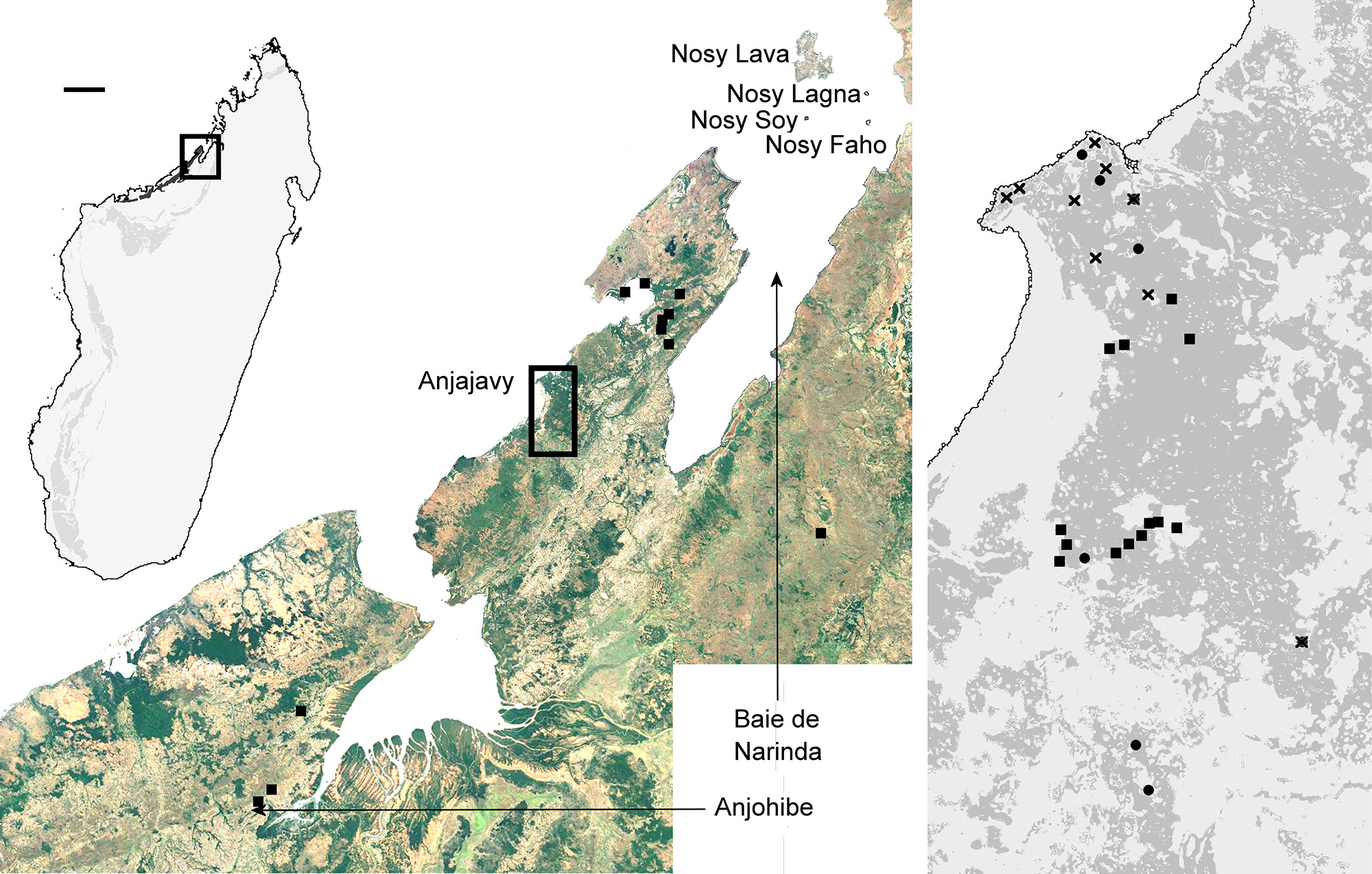
The coastal karsts of Anjajavy Peninsula and the inland karsts around Lavaka Ambohimenamaso retain fragments of relatively intact lowland dry deciduous forest in addition to mangrove and scrub forests, and grassland habitats. Dry deciduous forests like other forests in Madagascar have suffered extensive deforestation. The exact magnitude of this deforestation is disputed based on uncertainties over the original extent of forest cover (McConell and Kull, 2014) but it is well established that forest cover in Madagascar has decreased by 40% over the second half of the 20th century (Harper et al., 2007). Deforestation is believed to have led to high rates of biodiversity loss (Allnutt et al., 2008). Unfortunately, forest cover continues to decline by 1.1% per year (Vieilledent et al., 2018) and remaining forest blocks are highly fragmented. In Anjajavy the largest forest block is 355 ha, with the forest interior at most 375 m from the forest edge (Fig. 1). Forest loss and fragmentation leads to changes in soil moisture and leaf litter cover that are likely to have an impact on moisture dependent animals such as snails and would be expected to lead to population declines and the possibility of local extirpation and extinction. Given the high diversity, endemism, and vulnerability of Madagascar’s land snail fauna and the low levels of sampling in the Anjajavy region, it is imperative to document this fauna while there is still time for conservation efforts.
Materials And Methods
Collections of snails were made on the Anjajavy Peninsula in 2003 (O.L. Griffiths), 2007 (K. Emberton) and in 2019 (J. Gerlach). These collections are described here, along with those from the area to the southwest, around Anjohibe Cave in 1997; and the nearby islets of Nosy Lagna, Nosy Lava, Nosy Soy and Nosy Faho from 2004. At each of 57 collecting sites (Appendix 1), at least 10 m2 were searched by hand for approximately one person hour. Several litres of leaf litter were collected and dried from most sites and snails were subsequently sorted from these samples under a dissecting microscope.
We measured intact adult shells of new, or notable taxa down to 0.1 mm. Height was measured as the greatest distance between the apex and the base of the aperture parallel to the shell axis and width is the greatest width of the shell perpendicular to the shell axis. Aperture height was measured from the suture to the base of the lip, parallel to the shell axis and aperture width is the greatest distance from the columellar edge to the distal edge of the aperture. Large shells were measured with digital calipers and small shells using an ocular micrometer. We express measurements as means, ranges and standard deviations in Table 1.
Synonyms are given for nomenclature changes proposed here or since the last major reviews of the Madagascar terrestrial fauna (Fischer-Piette et al., 1993, 1994; Fischer-Piette and Vukadinovic, 1973) and the African freshwater fauna (Brown, 1994). Higher-level taxonomy follows Bouchet et al. (2017).
Voucher material is deposited in: Australian Museum, Sydney (AM); Natural History Museum, London (NHMUK); Parc Botanique et Zoologique de Tsimbazaza Museum, Antananarivo (PBZT); University of Florida, Florida Museum, Gainesville (UF); University Museum of Zoology in Cambridge (UMZC). Collectors are abbreviated: Ken Emberton (KE); Justin Gerlach (JG); Owen Griffiths (OLG).
Results
Subclass CAENOGASTROPODA Cox, 1960
Order ARCHITAENIGLOSSA Haller, 1892
Family CYCLOPHORIDAE Gray, 1847
Acroptychia milloti Fischer-Piette and Bedoucha, 1965 (Fig. 3A–B, 21A)
Distribution.—Recorded from Soalala to Majunga in western Madagascar (Fischer-Piette et al., 1993). In Narinda North recorded from Anjajavy and Ambalatsingy; associated with ‘tsingy’ rock areas: Grotte des Sakalava and Lavaka Ambohimenamaso caves.
Material studied.—OLG: 33/03 x 85; 36/03 x 34; 37/03 x 11; 38/03 x 18; 39/03 x 24; 40/03 x 5; 6/04 x 30; 8/04 x 1; 11/04 x 15; 13/04 x 1. KE: MBI-2582 (UF 425632 x 3 ethanol, 431763 x 12); MBI-2583 (UF 425636 x 1 ethanol. 431762 x 10); MBI-2586 (UF 425640 x 1 ethanol, 431769 x 9); MBI-2587 (UF 431766 x 8); MBI-2588 (UF 431865 x 18); MBI-2590 (UF 431758 x 6); MBI-259 (UF 425649 x 1 ethanol, 431876 x 23); MBI-2592 (UF 433485 x 8); MBI-2593 (UF 431862 x 14); MBI-2594 (UF 425656 x 1 ethanol, 431767 x 1, 431863 x 18); MBI-2595 (UF 431923 x 1; 432142 x 9); MBI-2596 (UF 425661 x 3 ethanol; 431899 x 10); MBI-2597 (UF 431753 x 2, 432144 x 10). JG: 10/19 x 3; 12/19 x 4.
Table 1. Measurements of new taxa (in mm), holotype measurements, ranges with means and standard deviations.
| N | shell | aperture | ||||||
| height | width | h/w | height | width | h/w | |||
| Omphalotropis lavanensis | holotype NHMUK 20220184 | 8.5 | 6.1 | 1.39 | 3.6 | 2.2 | 1.64 | |
| range | 4 | 6.0–8.6, 7.2±1.21 | 4.4–6.1, 5.2±0.73 | 1.31–1.48 | 2.4–3.6, 3.1±0.54 | 1.8–2.5, 2.2±0.31 | 1.36–1.64 | |
| Boucardicus crassus | holotype NHMUK 20220186 | 5.5 | 3.2 | 1.72 | 1.0 | 1.2 | 0.83 | |
| range | 13 | 4.2–5.5, 5.0±0.33 | 3.2–4.9, 4.5±0.44 | 1.04–1.72 | 1.0–2.5, 2.0±0.36 | 1.2–2.1, 1.8±0.22 | 0.83–1.47 | |
| Boucardicus malama | holotype NHMUK 20220188 | 3.9 | 3.5 | 1.11 | 1.6 | 1.3 | 1.23 | |
| range | 2 | 3.9 | 3.5 | 1.11 | 1.5–1.6 | 1.3 | 1.15–1.23 | |
| Boucardicus minoratus | holotype NHMUK 20220189 | 2.3 | 1.6 | 1.44 | 0.8 | 0.7 | 1.14 | |
| Cyclotopsis pectinata | holotype NHMUK 20220190 | 6.1 | 8.3 | 0.73 | 3.6 | 3.6 | 1.0 | |
| range | 4 | 6.1–6.7 | 7.7–8.3 | 0.73–0.87 | 2.9–3.6 | 3.0–3.6 | 0.97–1.00 | |
| Tropidophora narindana | holotype UF 536177 | 16.4 | 17.2 | 0.95 | 7.5 | 6.8 | 1.10 | |
| mainland | 24 | 10.5–17.1, 13.8±2.03 | 11.8–19.1, 15.3±1.86 | 0.83–0.96 | 5.6–8.4, 6.9±0.82 | 5.1–7.8, 6.3±0.76 | 0.98–1.10 | |
| Nosy Soy | 5 | 14.9–18.2, 16.8±1.19 | 17.1–18.8, 18.0±0.74 | 0.84–0.99 | 8.0–9.2, 8.5±0.44 | 7.2–8.8, 7.8±0.62 | 1.05–1.19 | |
| Nosy Lava | 9 | 14.9–19.2, 17.3±1.41 | 17.3–21.7, 19.5±1.35 | 0.86–0.93 | 8.2–10.0, 8.9±0.75 | 7.1–9.0, 8.1±0.66 | 1.02–1.15 | |
| Tropidophora tenona | holotype UF 448569 | 15.5 | 18.2 | 0.85 | 8.4 | 7.0 | 1.20 | |
| range | 15 | 12.5–16.4, 14.3±1.13 | 14.4–18.2, 16.4±1.56 | 0.84–0.96 | 8.6–8.8, 8.6±0.19 | 7.0 | 1.20 | |
| Tropidophora jugia | holotype NHMUK 20220192 | 16.8 | 19.6 | 0.86 | 9.0 | 8.3 | 1.08 | |
| range | 2 | 16.8 | 19.5–19.6 | 0.86 | 9.0 | 7.9–8.3 | 1.08–1.14 | |
| Tropidophora neoliratoides | holotype NHMUK 20220195 | 10.5 | 15.3 | 0.69 | 6.9 | 6.3 | 1.10 | |
| typical range | 12 | 8.8–13.8, 9.7±0.67 | 11.0–15.4, 13.4±1.61 | 0.65–0.82 | 6.0–6.9, 6.3±0.35 | 5.8–6.3, 6.1±0.19 | 0.98–1.10 | |
| small form range | 37 | 7.8–10.9, 8.7±0.69 | 10.0–14.8, 12.0±1.13 | 0.63–0.82 | 4.6–5.7, 5.3±0.49 | 4.8–5.8, 5.4±0.44 | 0.95–1.00 | |
| Tropidophora rovidrovitra | holotype UF 431997 | 12.4 | 11.4 | 1.09 | 6.6 | 6.0 | 1.10 | |
| range | 20 | 11.5–14.3, 12.7±0.87 | 10.2–12.5, 11.6±0.71 | 1.00–1.2 | 5.9–7.3, 6.7±0.45 | 5.2–6.6, 6.0±0.40 | 1.06–1.16 | |
| Gulella foucaultia | holotype NHMUK 20220204 | 7.4 | 3.9 | 1.90 | 2.3 | 1.8 | 1.27 | |
| range | 13 | 7.2–9.5, 8.3±0.70 | 3.0–4.1, 3.7±0.30 | 1.90–2.93 | 2.1–2.3, 2.2±0.14 | 1.8–2.0, 1.9±0.14 | 1.05–1.27 | |
| Gulella martiniana | holotype NHMUK 20220206 | 8.4 | 3.2 | 2.63 | 2.1 | 1.5 | 1.40 | |
| range | 26 | 7.1–10.8, 8.9±0.83 | 3.1–3.9, 3.4±0.19 | 2.14–3.09 | 1.3–2.1, 1.8±0.38 | 1.1–1.5, 1.3±0.19 | 1.00–1.64 | |
| Gulella anjajavyensis | holotype NHMUK 20220198 | 6.9 | 2.7 | 2.56 | 1.6 | 1.2 | 1.33 | |
| range | 14 | 5.5–7.1, 5.9±0.49 | 1.9–2.8, 2.5±0.21 | 1.96–2.95 | 1.5–1.8, 1.7±0.23 | 1.1–1.4, 1.3±0.11 | 1.20–1.40 | |
| Gulella volontany | holotype NHMUK 20220202 | 4.8 | 1.9 | 2.52 | 1.1 | 1.0 | 1.10 | |
| range | 11 | 3.5–4.8, 4.0±0.46 | 1.6–1.9, 1.8±0.11 | 2.06–2.52 | 1.0–1.4, 1.1±0.43 | 1.0–1.1, 1.0±0.08 | 0.99–1.30 | |
| Gulella antonibe | holotype NHMUK 20220200 | 4.7 | 2.0 | 2.35 | 1.5 | 1.4 | 1.07 | |
| range | 3 | 4.1–4.7, 4.3±0.32 | 1.8–2.1, 2.0±0.15 | 2.00–2.28 | 1.4–1.7, 1.6±0.58 | 1.3–1.7, 1.6±0.33 | 1.00–1.08 | |
| Parvedentulina lavana | holotype NHMUK 20220208 | 4.6 | 1.9 | 2.42 | 1.3 | 0.9 | 1.44 | |
| Ampelita anjajavyensis | large form | 2 | 15.4–16.4 | 32.0–33.1 | 0.46–0.51 | 11.1–12.0 | 13.9–15.5 | 0.77–0.80 |
| Ampelita cf. ela | range | 2 | 15.5–16.0 | 31.5–33.0 | 0.47–0.51 | 8.9–10.2 | 13.5–14.9 | 0.66–0.68 |
| Microcystis zorony | holotype UF 539640 | 4.1 | 6.3 | 0.64 | 2.5 | 3.2 | 0.78 | |
| range | 20 | 3.5–4.1, 3.8±0.23 | 5.6–6.4, 6.1±0.24 | 0.57–0.67 | 2.3–2.7, 2.5±0.14 | 2.6–3.2, 3.0±0.18 | 0.78–0.93 | |
| Microcystis embertoni | holotype UF 432447 | 2.0 | 3.1 | 0.64 | 1.3 | 1.6 | 0.77 | |
| range | 11 | 1.8–2.1, 1.9±0.09 | 2.9–3.4, 3.2±0.14 | 0.57–0.62 | 1.3–1.4, 1.3±0.07 | 1.4–1.7, 1.6±0.09 | 0.77–0.88 | |
| Microcystis aff. viaregina | typical range | 56 | 2.7–4.4, 3.6±0.34 | 4.6–7.0, 6.1±0.50 | 0.50–0.67 | 2.2–3.1, 2.6±0.27 | 3.3 | 0.91 |
| small form range | 6 | 2.2–2.6, 2.4±0.21 | 3.8–5.0, 4.6±0.32 | 0.49–0.58 | 1.6–2.2, 1.9±0.31 | 1.7–2.4, 2.1±0.63 | 0.89–0.93 | |
| Sitala dickensi | holotype NHMUK 20220209 | 6.3 | 8.0 | 0.79 | 2.0 | 4.0 | 0.79 | |
| range | 14 | 5.5–7.1, 6.0±0.72 | 5.3–8.5, 7.5±0.87 | 0.73–0.91 | 1.5–4.6, 3.1±1.29 | 3.3–6.1, 4.6±1.15 | 0.45–0.99 | |
| Ctenophila tangolika | holotype NHMUK 20220211 | 3.9 | 4.5 | 0.87 | 1.5 | 1.9 | 0.79 | |
| range | 48 | 2.9–4.0, 3.4±0.29 | 3.5–4.7, 4.1±0.31 | 0.75–1.00 | 1.3–1.7, 1.6±0.33 | 1.6–2.2, 1.8±0.58 | 0.80–0.82 | |
| Kalidos aff. pendutsaratae | range | 68 | 3.8–8.0, 6.3±0.79 | 5.7–13.1, 10.5±1.34 | 0.51–0.67 | 3.1–5.6, 4.1±0.53 | 4.8–6.2, 5.7±0.63 | 0.30–0.91 |
| Kalidos unistriata | holotype NHMUK 20220217 | 18.9 | 33.0 | 0.57 | 14.2 | 17.0 | 0.84 | |
| range | 33 | 15.5–21.0, 18.6±1.64 | 23.8–34.5, 30.9±2.92 | 0.56–0.65 | 11.0–15.6, 13.2±2.08 | 11.7–17.7, 15.2±2.74 | 0.84–0.94 | |
| Kalidos quadrangulata | holotype NHMUK 20220215 | 12.9 | 21.2 | 0.61 | 9.6 | 9.9 | 0.97 | |
| range | 3 | 10.2–12.9, 11.6±1.91 | 17.4–21.2, 18.8±2.09 | 0.58–0.61 | 7.5–9.6, 8.2±1.21 | 9.0–9.9, 9.3±049 | 0.82–0.97 | |
| Kalidos narindana | holotype NHMUK 20220213 | 17.8 | 25.9 | 0.69 | 11.7 | 14.2 | 0.82 | |
| range | 15 | 12.2–17.8, 14.8±1.78 | 19.9–25.9, 22.7±2.05 | 0.59–0.70 | 9.5–12.3, 11.2±1.21 | 9.114.2, 11.6±3.61 | 0.82–1.04 | |
| Kalidos mahafatifaty | holotype UF 427649 | 19.9 | 31.2 | 0.64 | 14.9 | 18.0 | 0.83 | |
Acroptychia salvati (Fischer-Piette and Bedoucha, 1965) new generic placement (Fig. 3C–D)
Tropidophora salvati Fischer-Piette and Bedoucha, 1965: 87
Tropidophora (Ligatella) salvati Fischer-Piette and Bedoucha, Fischer-Piette et al., 1993: 204
Described from a worn shell as a Tropidophora species but has a non-calcified operculum like Acroptychia. Fresh shells have a blue-grey apex that grades to tan or brown in later whorls and this base colour is overlain by a pattern of tan maculations similar to other Acroptychia species. Furthermore, in older adults the lip is not only reflected but the aperture has four or five concentric growth rings around the edge causing the aperture to broaden laterally with these concentric growth bands. This is a feature more common in Acroptychia than Tropidophora.
Distribution.—Species recorded from north of Majunga (Fischer-Piette et al., 1993). Also found at Kasijy on the Mahavavy and Antsingimavo, north of Maintirano (O. Griffiths collection). In Narinda North recorded from Anjajavy and Ambalatsingy.
Material studied.—OLG: 33/03 x 1; 37/03 x 1; 38/03 x 65 (NHMUK); 40/03 x 3; 8/04 x 3; 11/04 x 1. KE: MBI-2582 (UF 425634 x 1 95% ethanol, 432279 x 2, 433480 x 4); MBI-2583 (UF 432211 x 2); MBI-2586 (UF 432278 x 5, UF 433483 x 4); MBI-2589 (UF 432239 x 4, 433484 x 4); MBI-2590 (UF 430393 x 2, 432281 x 3); MBI-2594 (UF 432280 x 6, 433486 x 9).
Boucardicus crassus sp. nov. (Fig. 3E; Table 1)
Holotype.—NHMUK 20220186.
Paratypes.—NHMUK 20220187 (1), UMZC 2022.31.1 (2), AM C.593588 (7); PBZT T183 (1).
Description.—Shell conical; height 5.0 mm, width 4.5 mm. 5.0 very convex whorls, periphery evenly rounded. Body whorl constriction occurs 0.3 whorls before lip. Body whorl width 1.3 mm before constriction, 1.0 mm at constriction (24% constriction), 1.2 mm at post-constriction swelling (20% swelling). Surface dull, ornamented with dense radial riblets, becoming more widely spaced and irregular on post-constriction swelling. Lip evenly expanded; columella slightly reflected over umbilicus. Umbilicus open (3% of shell diameter). No umbilical ridge.
Uniformly off-white.
Distribution.—Narinda North – Anjajavy.
Material studied.—OLG: 33/03 x 9 (AM C.593588 x 7 paratypes); 37/03 x 2 (NHMUK 20220186 holotype, 20220187 x 1 paratype); 38/03 x 3 (UMZC 2022.31.1 x 2 paratypes; PBZT T183 x 1 paratype). KE: MBI-2590 (UF 429491 x 2).
Comparison.—Superficially closest to B. striatus Emberton, 2002 from coastal rainforest in north-eastern Madagascar. However, it differs in a number of key ways – in the Narinda North specimens, the umbilicus is partially covered by the reflected lip in the columellar region; the lip is not flared out, lacks lobes and is not retracted at the suture; there is only a single post-restriction swelling, this is more pronounced (constriction 14% in B. striatus) with only irregular radial ridges, and the shells are larger (3.9 x 3.8 mm in B. striatus).
Etymology.— crassus, Latin for solid or coarse, referring to the dull shell surface.
Boucardicus malama sp. nov. (Fig. 3F; Table 1)
Holotype.—NHMUK 20220188.
Paratypes.— UF 429522 (6).
Description.—Shell conical, small: height 3.9 mm, width 3.5 mm. 4.7 very convex whorls, periphery evenly rounded. Body whorl constriction occurs 0.2 whorls before lip. Body whorl width 1.3 mm before constriction, 1.2 mm at constriction (8% constriction), and 1.3 mm at post-constriction swelling (8% swelling). Apical whorl smooth, shiny; 2nd whorl covered with oblique well-spaced radial growth striae, only irregular growth lines on rest of shell except for very strong radial ridges on post-constriction swelling. Aperture quadrangular; lip evenly expanded; columella partially reflected over umbilicus. Umbilicus wide (13% of shell diameter), without umbilical ridge.
Dark brown, aperture off-white.
Distribution.—Narinda North – Anjajavy.
Material studied.—OLG: 40/03 x 2 (NHMUK 20220188 holotype). KE: MBI-2595 (UF 429522 x 6 paratypes).
Comparison.—Similar in size and overall appearance to B. malemius Emberton, 2002 (3.6 x 3.0 mm) from rainforest in the north-east at Marojejy but differs in aperture shape and in the absence of spiral sculpture.
Etymology.—malama, Malagasy for smooth, referring to lack of spiral sculpture on the shell.
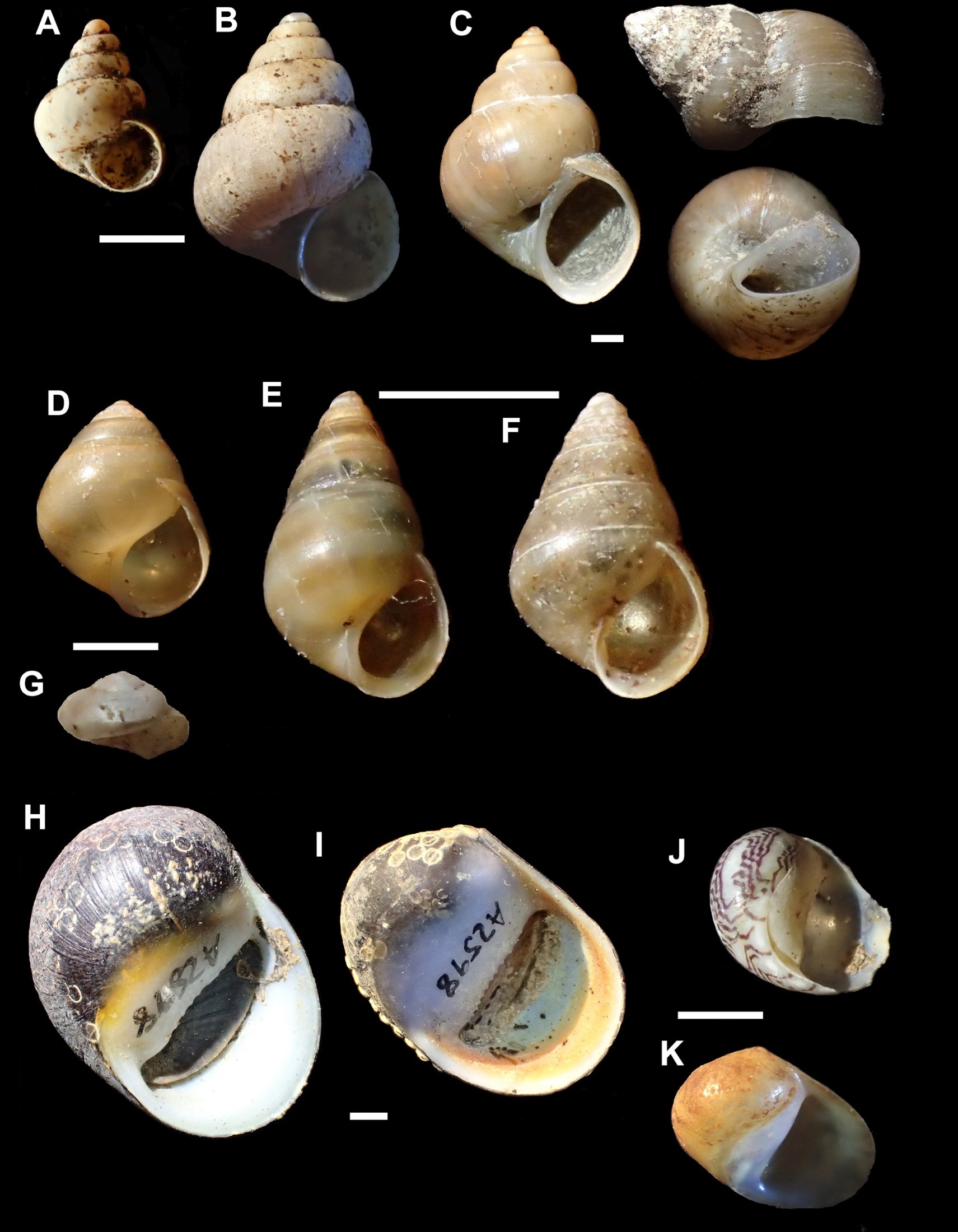
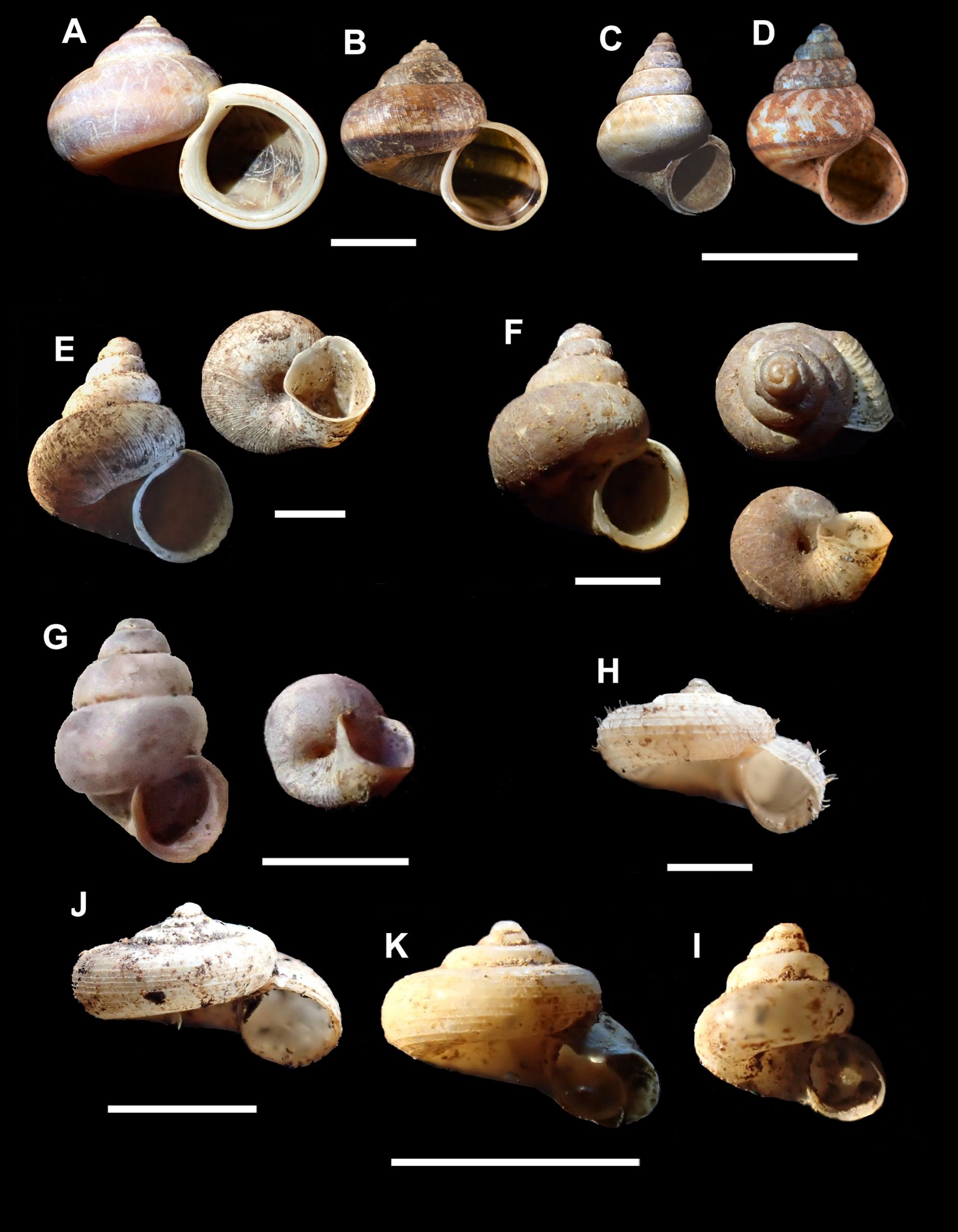
Boucardicus minoratus sp. nov. (Fig. 3G; Table 1)
Holotype.—NHMUK 20220189.
Paratypes.— UF 429515 (2).
Description.—Shell pupiform, very small: height 2.3 mm, width 1.6 mm. 4.0 rounded whorls. Body whorl constriction occurs 0.4 whorls before lip. Body whorl width 0.76 mm before constriction, 0.46 mm at constriction (41% constriction), 0.50 mm at post-constriction swelling (8% swelling). Surface smooth except for strong radial ridges on post-constriction swelling. Aperture rounded, sutural insertion round shouldered, inserting about 100˚ from vertical. Lip slightly expanded, not reflected. Umbilicus slit-like, 7% of shell diameter. No umbilical ridge.
Shell dull purplish, aperture tinted reddish.
Distribution.—Narinda North – Anjajavy and Ambalatsingy.
Material studied.—OLG: 10/04 x 1 adult (NHMUK 20220189 holotype). KE: MBI-2595 (UF 429515 x 2 paratypes).
Comparison.—Most similar in form to B. microlavalavus Emberton, 2002 from rainforest at Manombo in south-east Madagascar, which differs in being slightly smaller (2.0 x 1.2 mm), has a very faint pre-constriction sculpture, narrower umbilicus (2%), the constriction on the body whorl is further back (0.8 whorls) followed by additional constrictions. In addition, the aperture is oval, descending steeply at sutural insertion (about 170˚). Other similar species are B. pupisomus Emberton, 2002 which is the same size (2.5 x 1.6 mm) but differs slightly in shape (more tapering) and has a very small lobe on the lip, its umbilicus is narrower at 2.5%, and B. betsiakensis Emberton, 2002 has a similar umbilicus (6.5%) but is larger (3.4 x 2.9 mm) and with more prominent ridges.
Etymology.—minoratus, Latin for lessening, in reference to the small size and tapered shape.
Cyathopoma majungae Fischer-Piette et al., 1993 (Fig. 3H)
Distribution.—Type locality at Soalala, west Madagascar, south of Majunga. In Narinda North found at Anjajavy and Ambalatsingy; Nosy Soy.
Material studied.—OLG: 33/03 x 9; 36/03 x 19; 39/03 x 33; 40/03 x 23 (UMZC); 8/04 x 7; 10/04 x 3; 11/04 x 4; 17/04 x 210 (NHMUK). JG: 03/19 x 1.
Cyathopoma pearcei Emberton, 2003
(Fig. 3I)
Notes.—Slightly higher than typical C. pearcei but otherwise as type.
Distribution.—Type locality at Ankarana in north Madagascar. In Narinda North only recorded at Anjajavy.
Material studied.—OLG: 36/03 x 33 (UF 583317); 39/03 x 22; 40/03 x 45.
Cyclotus mamillaris Odhner, 1919
(Fig. 3J)
Distribution.—Recorded from north-west Madagascar (Fischer-Piette et al., 1993). In Narinda North found at Anjajavy and Ambalatsingy.
Material studied.—OLG: 34/03 x 2; 38/03 x 126 (NHMUK, UMZC); 8/04 x 59; 9/04 x 1; 11/04 x 41. JG: 12/19 x 1. KE: MBI-2583 (UF 430864 x 30); MBI-2590 (UF 445301 x 20); MBI-2593 (UF 430842 x 8).
Millotorbis milloti (Fischer-Piette and Bedoucha, 1965) (Fig. 3K)
Distribution.—North-West Madagascar: Marovatobe, Nosy Be, Nosy Komba, In Narinda North only found at Anjajavy.
Material studied.—OLG: 33/03 x 44 (NHMUK). JG: 10/19 x 1. KE: MBI-2583 (UF 545297 x 5); MBI-2586 (UF 569422 x 15); MBI-2588 (UF 431266 x 25); MBI-2589 (UF 431257 x 12, 432261 x 4); MBI-2590 (UF 431281 x 11); MBI-2591 (UF 559889 x 4); MBI-2593 (UF 559942 x 2); MBI-2594 (UF 559845 x 1).
Family AMPULLARIIDAE Gray, 1824
Notes.— One freshwater species recorded.
Pila cecillei (Philippi, 1848) (Fig. 10P)
Distribution.—Found throughout Madagascar (Starmuhlner 1969; Fischer-Piette and Vukadinovic 1973). In Narinda North found at Anjajavy and Ambalatsingy; abundant shells in the Lavaka Ambohimenamaso cave.
Material studied.—OLG: 33/03 x 12 (NHMUK, UMZC); 5/04b x 3 (brown banded form). JG: 12/19 x 4.
Order LITTORINIMORPHA Golikov and Starobogatov, 1975
Family POMATIIDAE Newton, 1891
Cyclotopsis pectinata sp. nov. (Fig. 4A–C; Table 1)
Holotype.—NHMUK 20220190.
Paratypes.—NHMUK 20220191 (2).
Description.—Shell helicoid; height 6.4 mm, width 8.1 mm. 3.8–4.0 convex whorls. Suture very deeply impressed. Apical whorl smooth, following whorls with sculpture of 6 parallel spiral cords crossed by very strong, wavy radial ridges. These are taller and strongly retracted where they cross spiral cords, giving a distinctively scalloped effect. Radials irregularly spaced, resulting in the scalloped ridges clustering in groups. Not all intersections project, and projection height varies. These features extend well into sutural area. Scalloping sculpture extends from suture into umbilicus, with a total of 14 spiral cords on body whorl. Umbilicus wide (19–22% of shell diameter) and deep, showing edge of all whorls. Aperture circular, final 0.2 whorls deflected downwards. Lip simple, not reflected or thickened. Shell uniformly greyish brown.
Comparisons.—Differs from C. milloti Fischer-Piette et al., 1974 in the wavy radial sculpture being grouped into scalloped ridges rather than regularly spaced, also less broad. Shape similar to C. mermosi Fischer-Piette et al., 1993 but sculpture different. Similar scalloping sculpture is found in C. tsaratananae Emberton, 2003 and C. orchidae Emberton, 2003. the shell is lower than either of these species (h/w 0.7–0.9 compared to 0.9–1.0) and slightly larger (width at least 7.7 mm compared to a maximum of 7.7 mm), it has a higher, narrower spire (width of first 1.5 whorls 19–25% of shell diameter compared to 32%). The sculpture in C. orchidae is regular and linear, whereas the raised scalloping is wavy, irregular, and grouped in C. tsaratanae. The present species differs from the others in that the scalloping is more prominent and clumped: the ratio of the distance between spirals to maximum projection height is 1.0, compared to 2.5–3.0 in the other species, and distance between radials to projection height is 0.3 compared to 1.0.
Distribution.—Narinda North – Anjajavy.
Material studied.—OLG: 38/03 x 4 (NHMUK 20220190 x 1 holotype, 20220191 x 2 paratypes). KE: MBI-2596 (UF 430763 x 11)
Etymology.—pectinata from pecten Latin for a comb, also used for bivalve scallops in refererence to the distinctive comb-shaped sculpture.
Tropidophora lineata (Pfeiffer, 1852) (Fig. 5A, 21B)
Distribution.—Found throughout western Madagascar (Antsingimavo to Tulear: Fischer-Piette et al., 1993). In Narinda North recorded from Anjajavy and Ambalatsingy; Nosy Lava; Nosy Soy. Found abundantly in dry forest areas throughout Anjajavy.
Material studied.—OLG: 34/03 x 47; 36/03 x 50; 37/03 x 29; 38/03 x 60; 39/03 x 65; 40/03 x 13; 6/04 x 14; 8/04 x 55 (UMZC); 9/04 x 63 (UMZC); 10/04 2; 11/04 x 133; 15/04 x 110; 17/04 x 55 (NHMUK). KE: MBI-2581 (UF 432026 x 2); MBI-2586 (UF 425641 x 1 ethanol, 432079 x 9); MBI-2589 (UF 432242 x 8); MBI-2590 (UF 432095 x 8); MBI-2591 (UF 432253 x 1); MBI-2593 (UF 431971 x 9); MBI-2594 (UF 432102 x 4); MBI-2595 (UF 425657 4 ethanol, 432000 x 7); MBI-2596 (UF 432123 x 36); MBI-2597 (UF 432029 x 9). JG: 07/19 x 25.
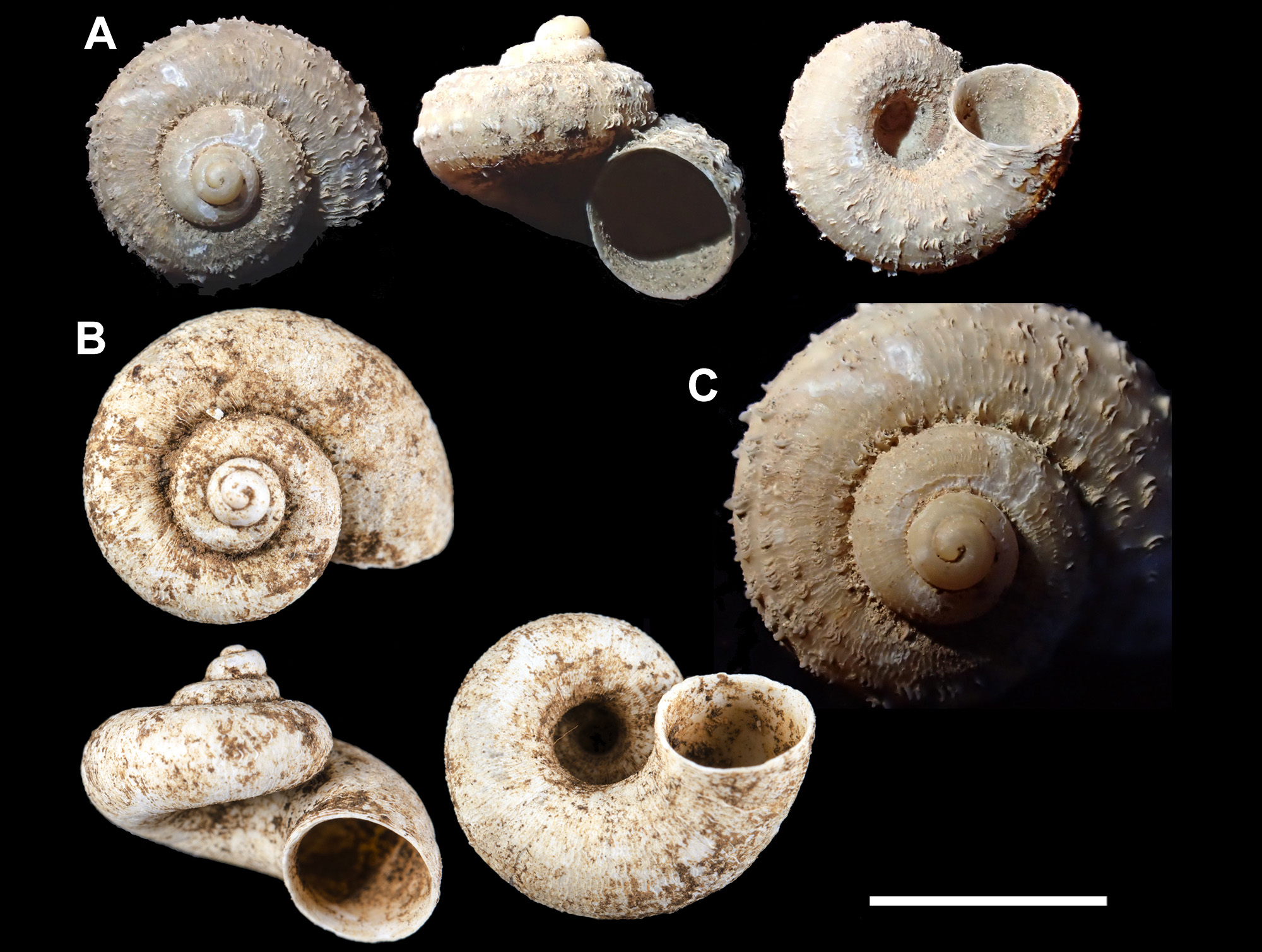
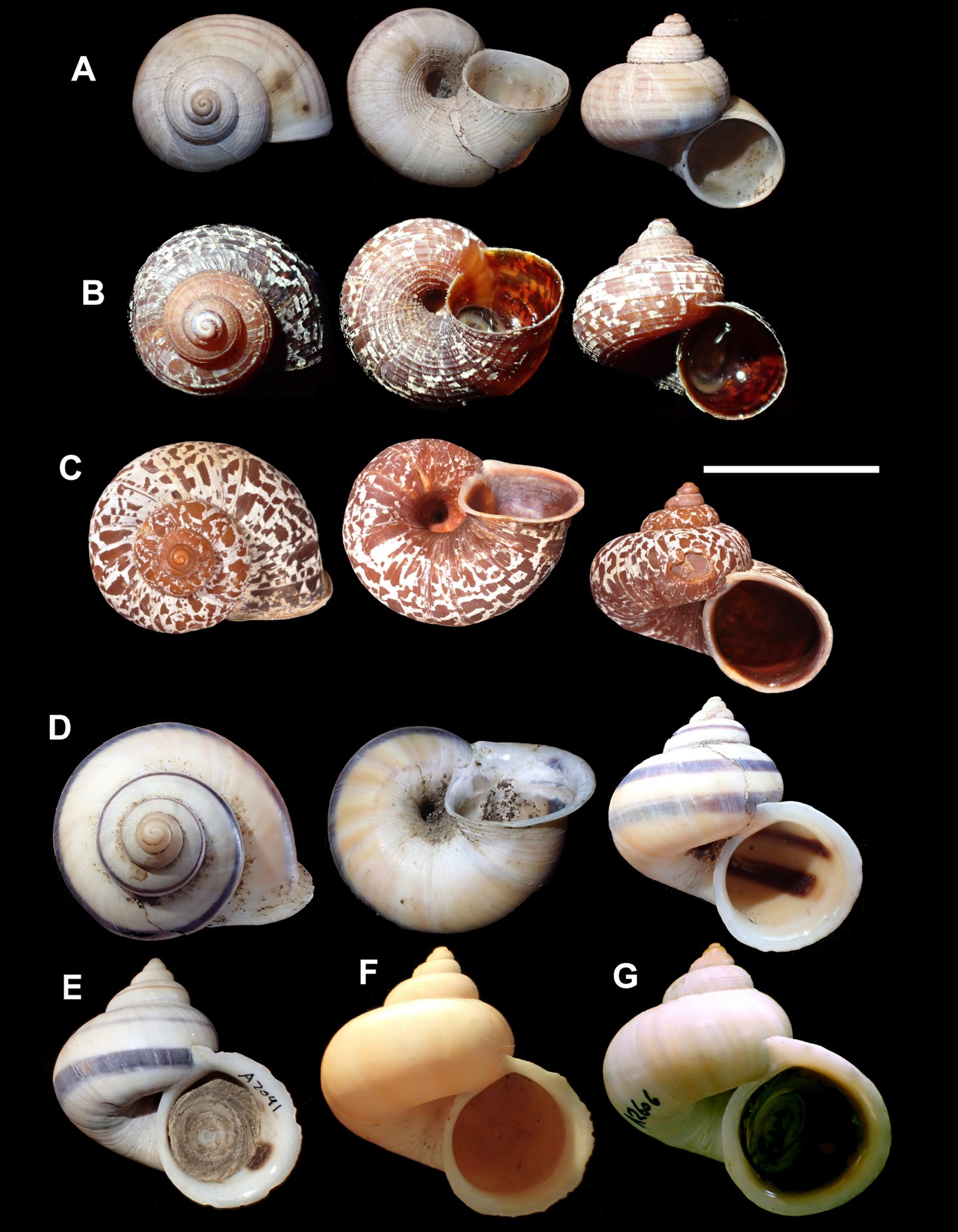
Tropidophora reticulata (Adams and Reeve, 1850) (Fig. 5B, 21C)
Notes.—This species was previously known only from the type specimens (NHMUK 74.2.11.231) collected from an unknown locality in Madagascar and described in the Samarang expedition reports (Adams and Reeve, 1850), although the expedition never visited Madagascar. Presumably, it was included in the Samarang report in error as no other Madagascar species are included.
This is a strongly ridged species with distinct coloring: dark brown shell with white patches on the periostracum, shared only with the following species which differs in sculpture and shape. Worn specimens lose the white patches of periostracum but are recognizable from the sculpture: the apical 1.5 whorls are smooth, followed by whorls with radial striae, fading around the periphery. From the 2nd whorl there is a sculpture of coarse, strong ridges: with four prominent low spiral ridges on the upper half of each whorl, separated by finer ridges which continue on the base, into the umbilicus. Regular raised radial ridges cross the spirals, at the sutures the radials are raised, forming distinctive angular lamellae. The only described species with a similar sculpture is T. surda Fischer-Piette et al., 1993 which has radial striae that form distinctively inclined lamellae at the suture. However, their shells differ in the height and angle of the spire.
Distribution.—Narinda North – Anjajavy.
Material studied.—OLG: 38/03 x 1 large juvenile. KE: MBI-2584 (UF 432230 x 3); MBI-2585 (UF 431934 x 3). JG: 01/19 x 1 (ethanol); 02/19 x 1 adult, 2 juveniles (UF 583318).
Tropidophora bathiei Fischer-Piette, 1949 (Fig. 5C, 21D)
Tropidophora secunda Fischer-Piette and Bedoucha, 1965 Griffiths and Herbert, 2013: 10 syn. Nov.
Notes.—Tropidophora bathiei was known from isolated records in north-western Madagascar (Fischer-Piette 1949). T. secunda was recorded first from northern Madagascar (Fischer-Piette et al. 1993) with later records further west (Griffiths and Herbert, 2013). The two taxa differ only in the presence of white maculations and streaks on T. secunda, which are part of the periostracum and wear off on some specimens. The type material of T. bathiei retains small amounts of white periostracum in the sutures, accordingly we synonymize them here.
Distribution.—Found in north-western Madagascar and previously recorded at Anjajavy (Griffiths and Herbert, 2013). Widespread on the ground, on rocks and trees throughout Anjajavy.
Material studied.—OLG: 33/03 x 68; 36/03 x 49; 37/03 x 55; 38/03 x 24; 39/03 x 18; 40/03 x 10. KE: MBI-2582 (UF 425633 x 2 ethanol, 431713 x 23); MBI-2583 (UF 431708 x 13); MBI-2586 (UF 425642 x 3 ethanol, 431714 x 13); MBI-2587 (UF 431711 x 20); MBI-2589 (UF 425646 x 3 ethanol, 425647 x 1 ethanol, 431709 x 8); MBI-2590 (UF 432283 x 1); MBI-2591 (UF 431705 x 9); MBI-2593 (UF 431727 x 8); MBI-2594 (UF 425654 x 1 ethanol, 431712 x 14); MBI-2597 (UF 431706 x 15). JG: 07/19 x 22; 12/19 x 18.
Tropidophora sikorae (Fulton, 1901) (Fig. 5D–G)
Notes.—Variably colored in Narinda North region: around Anjajavy pale yellow with two broad brown spiral bands (Fig. 5D), upper band narrow in some specimens (Fig. 5E); Anjohibe white with two unequal sized brown bands and yellow between bands, uniformly orange-yellow (Fig. 5F) or with a single band, or olive with a pale band and a brown tinted aperture (Fig. 5G).
Distribution.—Widespread throughout Madagascar. In Narinda North found at Anjajavy, Ambalatsingy, Anjohibé and Nosy Lava.
Material studied.—OLG: Narinda North: 38/03 x 2; 5/04 x 5 (NHMUK); 8/04 x 1; A637/78 x 13; Anjohibé: MBI 903 x 1; MBI 904 x 5; MBI 906 x 5; MBI 907 x 17 (UMZC); Nosy Lava: 15/04 (UF 448443). KE: MBI-2595 (UF 431992 x 2). JG: 10/19 x 2; 12/19 x 1.
Tropidophora narindana sp. nov. (Figs 6, 7; Table 1)
Holotype: UF 536177.
Paratypes: NHMUK 20220194 (6), UMZC 2022.31.2 (6), UF 425659 (2 ethanol), AM C.593589 (5); PBZT T184 (1).
Description.—Shell globosely conical; height 13.8 mm, width 15.3 mm. Umbilicus open (9–20% of shell diameter). 4.2–5.2 whorls. First 1½ whorls smooth, remainder ornamented with five very slightly raised spiral ridges and evenly spaced growth lines raised at suture only. Spiral striae numerous and distinct into umbilicus. Lip slightly thickened, moderately recurved, and broadly expanded. Most expanded at insertions: often forming flange at parietal insertion and recurved to form a shallow gutter. Often expanded at columella, usually obscuring at least 32% of umbilicus (sometimes completely covering it). Aperture circular. A ridge of aestivational arrested growth present.
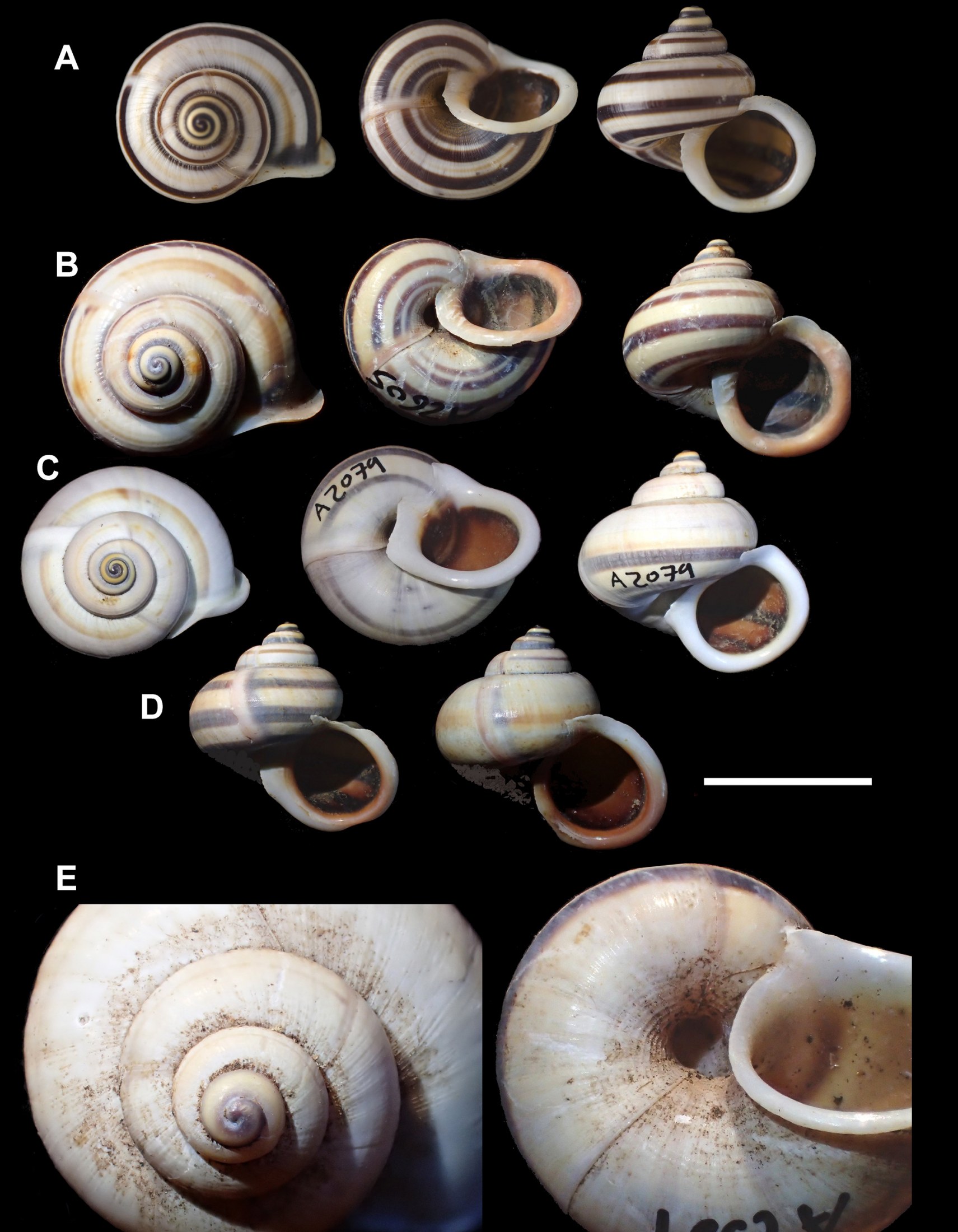
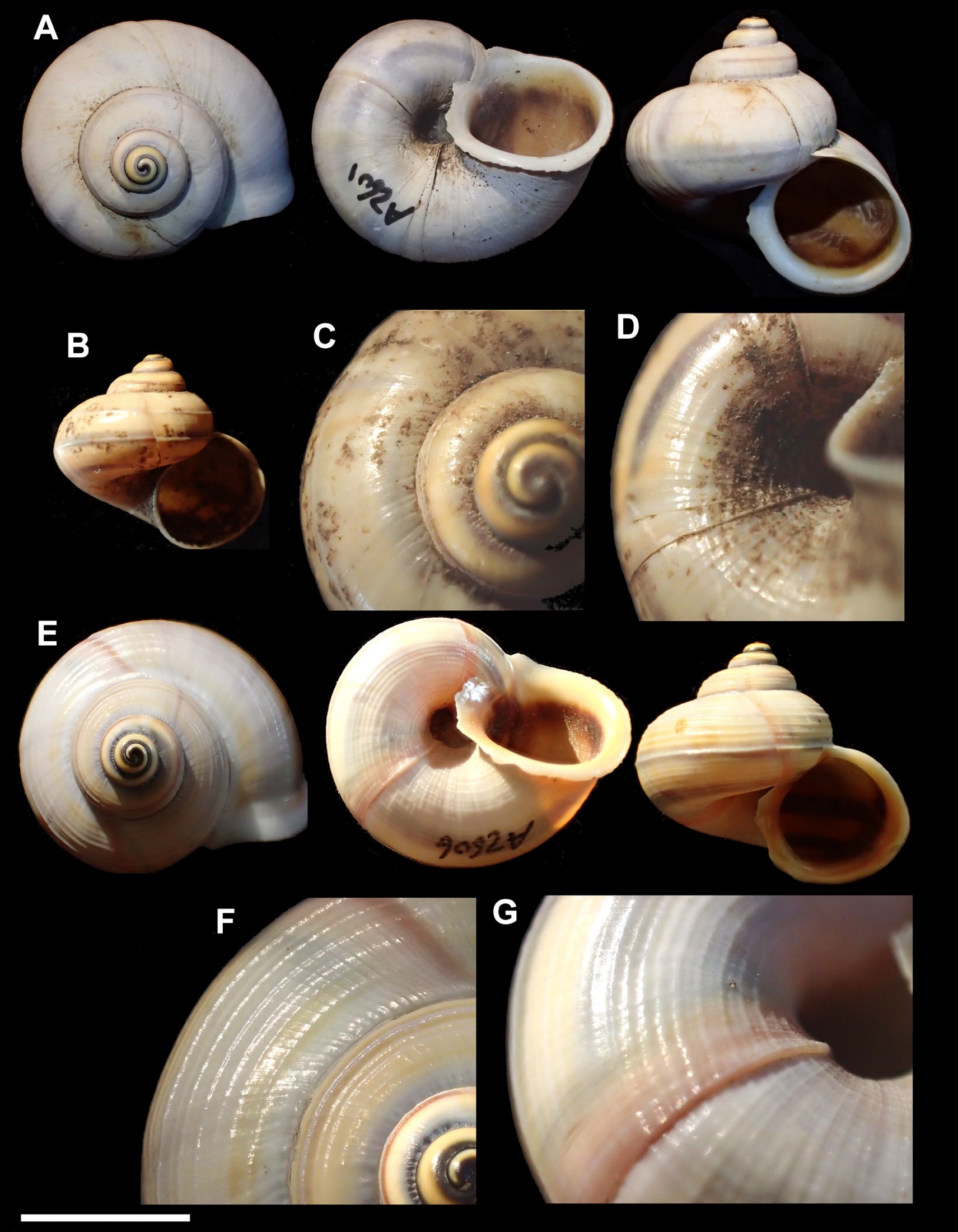
Shell thickness variable: some populations (5/04b Ambalatsingy and MBI 903 Anjohibé) being particularly thick, these also have reduced sculpture.
5–6 spiral dark brown bands (supra-peripheral, peripheral, sub-peripheral and 2–3 umbilical) on raised spiral ridges. Apex purple with a central yellow band. Lip white, suffused yellow around aperture, with a blackish band internally (indistinct on the outside). Specimens from further north (5/04b) have reduced banding and are larger in some populations, others have a yellow-brown spiral band near the suture (9/04).
Distribution: Narinda North – Anjajavy, Ambalatsingy, Anjohibé, Nosy Soy and Nosy Lava. Specimens from Anjohibé differ in color but are otherwise identical. Nosy Soy and Nosy Lava specimens differ in sculpture (see below). Adult shells from both island populations are faded and often rat damaged.
Material studied.—OLG: Narinda North 33/03 x 26 (AM C.593589 x 5 paratypes); 36/03 x 42 (NHMUK 20220194 x 5 paratypes; PBZT T184 x 1 paratype); 38/03 x 5; 5/04b x 39; 6/04 x 2; 8/04 x 4; 9/04 x 69 (UMZC 2022.31.2 x 6 paratypes); 13/04 x 2; Anjohibe MBI 903 x 4 (UF 583319). KE: MBI-2595 (UF 536177 holotype, UF 425659 x 2 paratypes, UF 444497 x 8); MBI-2596 (UF 432337 x 15, 444486 x 1 ethanol). JG: 11/19 x 3; 12/19 x 6. Nosy Soy: OLG: 17/04 x 53 (NHMUK). Nosy Lava: OLG: 15/04 x 76 (NHMUK).
Comparison.—A very distinct species, smooth with slight ridges underlying dark spiral bands, radial striae only at sutures. The pattern of five spiral dark brown bands is similar to T. goudotiana (Sowerby, 1853) which differs in shape and has an angled aperture. There is a superficial similarity to T. johnsoni (Smith, 1882) in shape.
The populations from the islands of Nosy Soy and Nosy Lava could be regarded as distinct, differing from the mainland population in color pattern and sculpture. The two islands are close to the mainland and not separated by a deep channel, so are only likely to have been isolated within the past few thousand years. With a short geological history and relatively slight differences we regard these as local variants at present.
Those on Nosy Soy (Fig. 7A–D) are closest to the Anjohibé population (MBI 903) but the lip is not as expanded and not reflected to form a gutter. They differ from typical T. narindana in that the sculpture is reduced to two spiral ridges: one at periphery and one half-way between periphery and suture (obsolete in adults), with basal sculpture restricted to the umbilicus. Nosy Lava specimens (Fig. 7E–G) have much more prominent sculpture: 10 spiral ridges on the body whorl, with a weak peripheral keel and sometimes a supraperipheral low keel; radial growth lines are separated by 5–12 very fine radial striae, worn in adults but distinct in subadults. Spiral striae are more prominent on base than in other populations. In both populations the shells are pale; 3 brown bands (supraperipheral, peripheral, basal) are present but ill defined. The peripheral spiral ridge is white.
Etymology.—narindana, Latinisation of Narinda, the region in which it occurs.
Tropidophora tenona sp. nov. (Fig. 8A–D, 20A, 21E; Table 1)
Holotype.—UF 448569.
Paratypes.—AM C.593590 (6), NHMUK 20220197 (6), UF 448465 (2 ethanol).
Description.—Shell globosely conical; height 14.3 mm, width 16.4 mm. Umbilicus open (15% of shell diameter) partially obscured by reflected lip. 4.3 whorls. First 1.5 whorls smooth, remainder crossed by regular radial ridges and prominent spiral striae increasing in number on successive whorls. 2 spirals on the 2nd whorl, 4 on 3rd and 10 on the upper surface of 4th. Sculpture continues on underside, extending into umbilicus. Lip broadly expanded, thin, serrated at periphery. Covers approximately 1/3 of umbilicus. 1–3 strong ridges of aestivational arrested growth.
Apex purple. 2nd whorl with medial yellow band, expanding in width and covering basal half of 3rd whorl. Fine red-brown spiral line starting at suture of 3rd and 4th whorls, becoming less distinct and combined with yellow-brown spiral lines. On body whorl all spiral ridges marked with red-brown to black spiral lines. Body whorl usually with three ill-defined broad dark bands. Shell before the lip black, fading to pink and then white. Underside with irregular broad brown bands, white around umbilicus. Lip white, aperture orange, black inside. Colors highly variable.
Reproductive anatomy.—penis (Fig. 20A) moderately elongate, distally inflated with a prominent curved apical extension. Inflated portion flattened in cross-section and regularly folded on underside.
Distribution.—Narinda North – Anjajavy. Associated with rock outcrops at Anjajavy: lemur fossil cave and ‘tsingy’ in coastal forest near the marina. Not located elsewhere and apparently a narrow range endemic.
Material studied.—OLG: 40/03 x 124 (NHMUK 20220197 x 6 paratypes; AM C.593590 x 6 paratypes). JG: 04/19 x 7. Some rat damaged.
Comparison.—The reddish aperture is similar to T. pyrostoma (Sowerby, 1843) which lacks the complex sculpture and flared lip that partially obscures the columella found in the present species. The thin expanded lip is unique in this species. The strong lines of arrested growth are also characteristic.
Etymology.—tenona Malagasy for ‘woven’, referring to this species net-like sculpture of prominent spiral striae crossed by radial ridges.
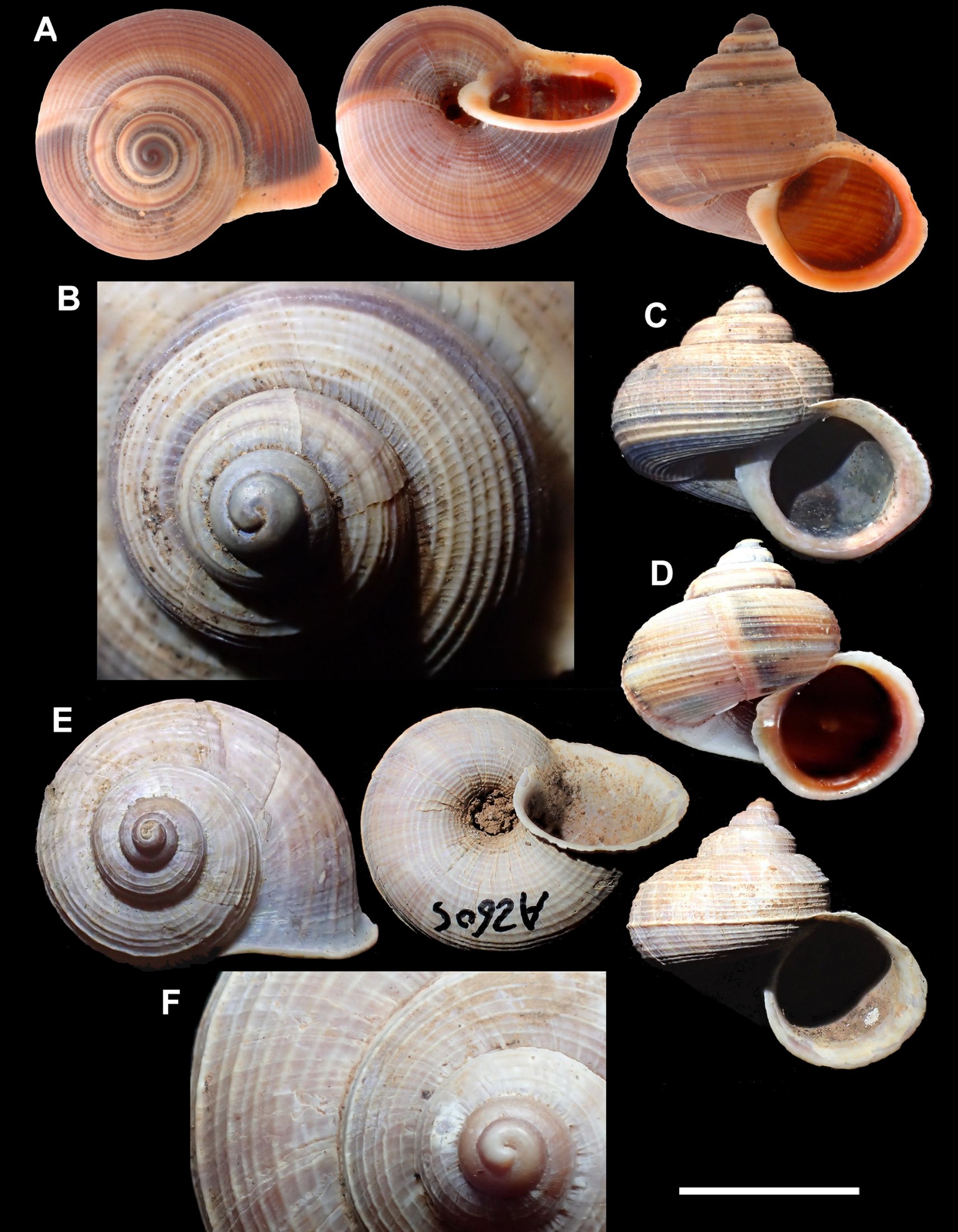
Tropidophora jugia sp. nov. (Fig. 8E–F; Table 1)
Holotype.—NHMUK 20220192.
Paratypes.—NHMUK 20220193 (2).
Description.—Shell subglobose; height 16.8 mm, width 19.6 mm. 4.5–4.6 convex whorls. First 1.7 whorls smooth, remainder marked by strong close spiral ridges and irregular growth lines. Sculpture continues onto body whorl and into umbilicus. Ridge at periphery and half-way between periphery and suture developed into low keels. Aperture circular, expanded and slightly reflected over columella. Umbilicus open (17% of shell diameter), 20% covered by lip. Shell grey-brown with irregular darker radial streaks and an indistinct dark area before aperture. Spiral ridges pale.
Distribution.—Narinda North – Anjajavy and Ambalatsingy.
Material studied.—OLG: 33/03 x 2; 9/04 x 25 (NHMUK 20220192 x 1 holotype, 20220193 x 2 paratypes).
Comparison.—Similar forms are found in several different localities in Madagascar. Of the described species it may be closest to T. milloti Fischer-Piette, 1949 from northern Madagascar (Ankarana), but the present species differs in being grey-brown rather than largely reddish-brown, and in having two low spiral keels rather than one. There is some similarity to T. madagascariensis (Gray, 1833) but the sculpture is coarser, the single peripheral keel in T. madagascariensis is more prominent, the lip more expanded and the shell generally more robust.
Etymology.— jugia – Latin for ridges.
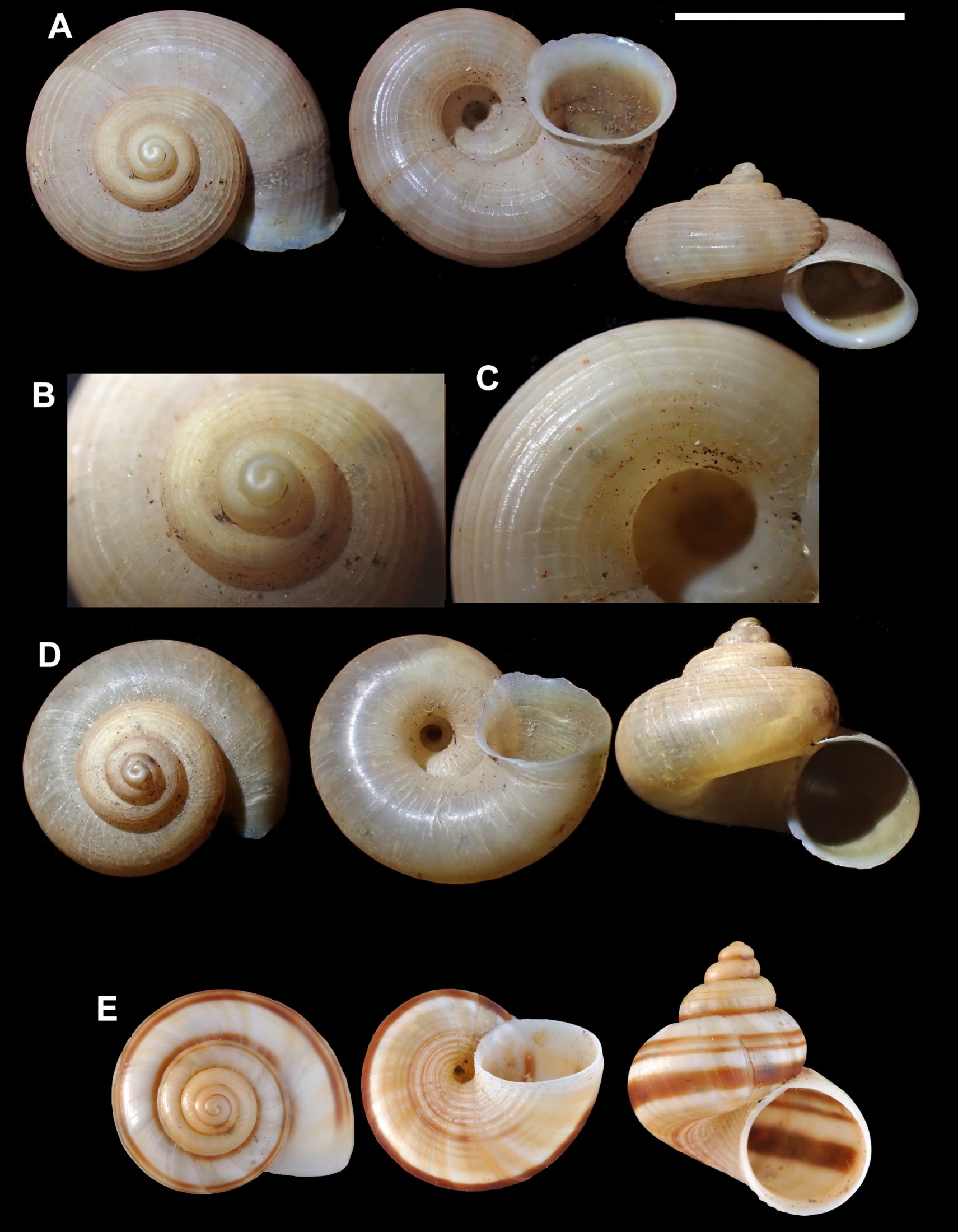
Tropidophora neoliratoides sp. nov. (Fig. 9A–D; Table 1)
Holotype.—NHMUK 20220195.
Paratypes.—NHMUK 20220196, AM C.593591 (5), PBZT T185 (2).
Description.—Shell flattened subglobose; height 9.7 mm, width 13.4 mm with 4.0–4.3 rapidly expanding whorls. Shell pale horn colored with white lip. First whorl smooth. Subsequent whorls on upper side with sculpture of up to 8 parallel spiral striae weakening towards periphery. Shell covered in dense, close, and fine radial striae, with irregular well-spaced radial growth lines. Sculpture on base as per upper side except for the complete absence of spiral sculpture. Sutures deep and broad. Shell periphery rounded. Umbilicus deep and broad (25% of diameter). Lip white and slightly but distinctly reflected.
Distribution.—Narinda North – Anjajavy and Ambalatsingy.
Material studied.—OLG: 33/03 x 166 (NHMUK 20220195 x 1 holotype, 2022196 x 6 paratypes; AM C.593591 x 5 paratypes; PBZT T185 x 2 paratypes); 37/03 x 26; 40/03 x 8; 33/03 x 42 (small form; UMZC); 36/03 x 79 (small form); 38/03 x 194 (small form; UMZC); 39/03 x 70 (small form; NHMUK x 6; AM C.593592 x 6); 8/04 x 170 (small form; UMZC). KE: MBI-2582 (UF 432315 x 18); MBI-2583 (UF 425639 x 1 ethanol, 432251 x 23); MBI 2586 (UF 430781 x 6, 432316 x 30, 432322 x 1); MBI-2588 (UF 431956 x 15); MBI-2589 (UF 432240 x 16); MBI-2590 (UF 432314 x 30, 425648 x 1 ethanol); MBI-2591 (UF 432200 x 7); MBI-2592 (UF 432313 x 40); MBI-2593 (UF (UF 431939 x 13); MBI-2594 (UF 432299 x 17); MBI-2595 (UF 422913 x 1 ethanol, 431928 x 8); MBI-2596 (UF 432317 x 13); MBI-2597 (UF 432023 x 12).
Comparison.—Tropidophora liratoides (Fischer-Piette et al., 1994) is the most similar snail to the Narinda taxon but is geographically widely separated (Tulear) and is clearly a different species: the Narinda species has a completely smooth base and very fine spiral striation on the upper side. T. liratoides is also flatter, with a lower spire.
A smaller form is present which may represent sexual dimorphism or an additional species, spirit material is needed to resolve its identity. The two forms have been found sympatrically. This differs from the type specimens in that the spiral striae continue onto the base and inside the umbilicus, rather than weakening on the periphery. Umbilicus 15–28% of shell diameter. The shell is also slightly smaller (7.8–10.9 x 10.0–14.8 mm compared to 8.8–13.8 x 11.0–15.4 mm).
Etymology.—neoliratoides, neo- Latin for ‘new’ and liratoides, the most similar known species.
Tropidophora rovidrovitra sp. nov. (Fig. 9E; Table 1)
Holotype.—UF 431997.
Paratypes.—UF 425645 x (1 ethanol), UF 539872 (6).
Description.—Shell conical; height 12.4 mm, width 11.4 mm. 4.6 whorls expanding evenly. Umbilicus open, narrow (8% of shell diameter). Apical 2 whorls smooth, remainder with two strong supraperipheral spiral ridges, fading on last 2 whorls. Base with strong spiral ridges running into umbilicus. All whorls marked with fine, irregular radial growth lines. Aperture simple, not expanded or reflected.
Shell white with faint radial streaks of pale brown, apical three whorls, umbilicus and inside of shell tinted pale brown. A broad spiral band, narrowly exposed below suture; two narrow spiral bands half-way between periphery and suture; base with one ill-defined spiral band. Bands fading before aperture but clearly visible internally.
Distribution.—Narinda North – Anjajavy.
Material studied.—KE MBI-2582 (UF 425635 x 7 ethanol; UF 432078 x 14), MBI-2583 (UF 432252 x 1), MBI-2587 (UF 432094 x 12), MBI-2588 (UF 425645 x 1 ethanol paratype, 431977 x 1, 539872 x 6 paratypes), MBI-2592 (UF 432097 x 28, 425650 x 3 ethanol).
Comparison.—A very distinct species; superficially similar in pattern to T. lineata but differing in more attenuate shape.
Etymology.—rovidrovitra, Malagasy adjective meaning torn or tattered, for the tendency for the upper bands to be broken into two or more bands.
Family TRUNCATELLIDAE Gray, 1840
Notes.—Two similar littoral species, differing largely in size.
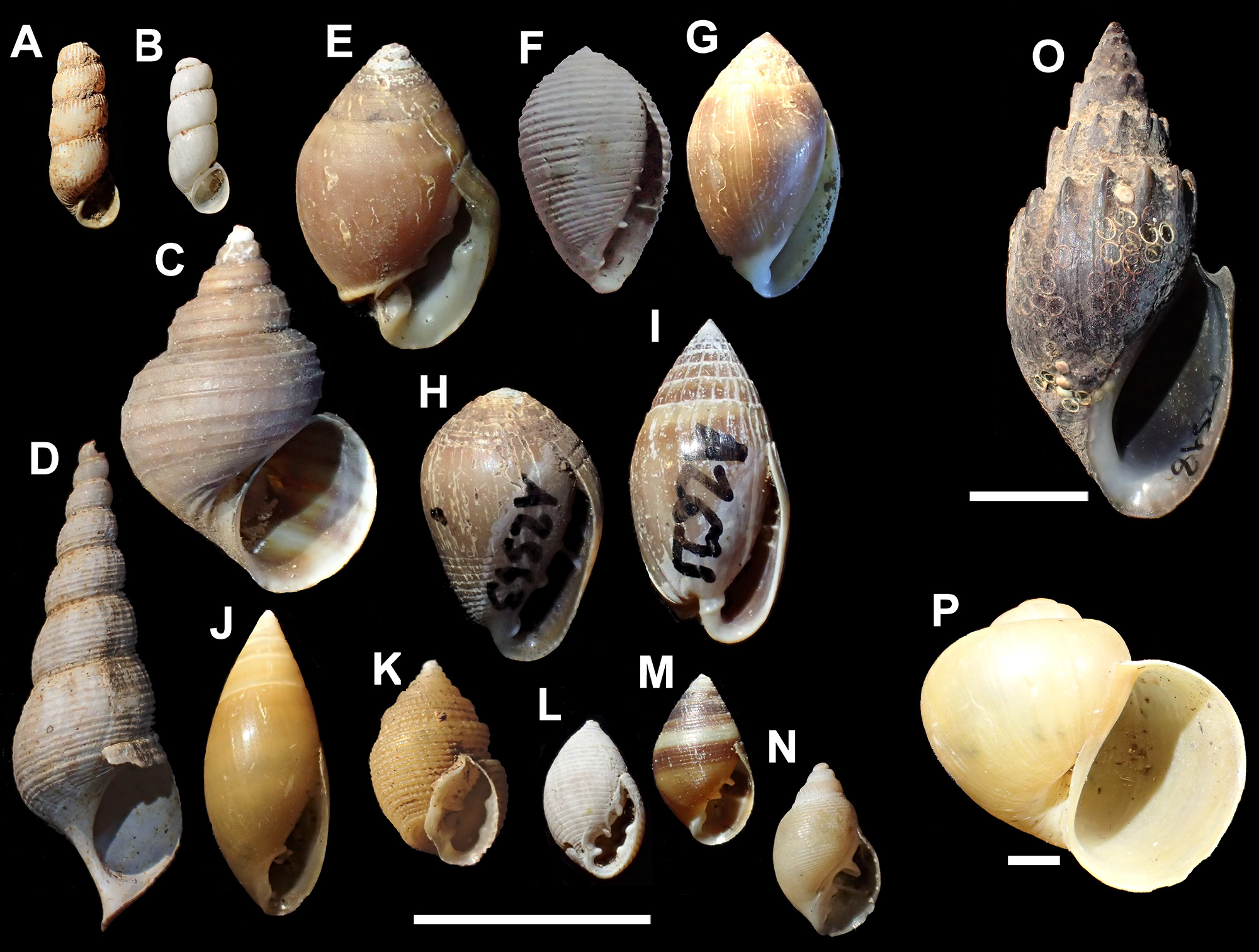
Truncatella guerinii Villa and Villa, 1841 (Fig. 10A)
Distribution.—Indo-Pacific, including Seychelles, Mauritius, Rodrigues, Réunion, Madagascar. In Narinda North only recorded from Anjajavy.
Material studied.—OLG 34/03 x 6 (UMZC).
Truncatella marginata Küster, 1855 (Fig. 10B)
Distribution.—Indian Ocean to west Pacific, including Mauritius, Diego Garcia, St Brandon, Madagascar. In Narinda North only recorded from Ambalatsingy.
Material studied.—OLG 10/04 x 265 (NHMUK).
Family ASSIMINEIDAE H. Adams and A. Adams, 1856
Notes.—Seven species of this family were recorded: two fully terrestrial Omphalotropis species and five littoral species in the genera Paludinella, Assiminea and Ditropisena.
Omphalotropis madagascariensis Germain, 1921 (Fig. 2B)
Distribution.—The type locality is Andrahomana in southern Madagascar. However, this species appears very widespread over much of the lowland and coastal areas of Madagascar (Fischer-Piette et al., 1993). In Narinda North recorded from Anjajavy, Ambalatsingy, Nosy Lagna, Nosy Soy, and Nosy Faho. Narinda North specimens are small; 4.8 mm high compared to more typical 6.2 mm but are otherwise identical.
Material studied.—OLG: 33/03 x3; 34/03 x 1; 40/03 x 2; 16/04 x 1; 17/04 x 32; 18/04 x 11 (NHMUK, UMZC).
Omphalotropis lavanensis sp. nov. (Fig. 2C; Table 1)
Holotype.—NHMUK 20220184. Paratypes: NHMUK 20220185 (4)
Description.—Shell globosely conical; height 7.2 mm, width 5.2 mm. 5.5–6.0 convex whorls bearing an indistinct low umbilical ridge, rounded, and never developed into a carina. Surface with widely spaced irregular growth lines. Nno trace of spiral or punctate sculpture. Umbilicus narrow, 12–13% of shell diameter. Aperture ovate, slightly angled at base. Lip not expanded or reflected.
Uniformly light olive brown. Aperture white.
Distribution.—Nosy Lava.
Material studied.—OLG: 15/04 x 5 (NHMUK 20220184 holotype, 20220185 x 4 paratypes).
Comparison.—Only three other Madagascar Omphalotropis species are known to exceed 5 mm in length: O. tantelia Emberton, 2009 (6.1 mm), O. madagascariensis (6.2 mm) and O. fortis Emberton, 2009 (7.2 mm). O. tantelia differs in lacking any trace of a circum-umbilical ridge and is minutely punctate, with faint growth lines; the aperture is broader (aperture height / width = 1.10, compared to 1.36–1.64 in the present species), umbilicus is similar (7% shell diameter). O. madagascariensis differs in having shouldered whorls and spiral as well as punctate sculpture and lacking a circum-umbilical ridge. O. fortis is relatively slender (h/w 1.7 compared to 1.48) with the widest part of the shell approximately 1/3 of the way from the base (compared to 2/5) and has spiral and punctuate sculpture. The present species differs from all described Madagascan species in the slightly angulate base of the aperture.
Etymology.—Named for Nosy Lava, the type locality.
Paludinella sp. (Fig 2D).
Notes.—Unidentified; it does not appear to be the previously recorded P. hidalgoi (Gassies, 1869) but the species of this genus are poorly defined. Shell squat, blunt apex, and dense fine spiral sculpture.
Distribution.—Narinda North – Ambalatsingy, in mangroves, upper tidal behind beaches.
Material studied.—OLG: 10/04 x 1 (UF 583312).
Assiminea cf. punctum Morelet, 1882 (Fig. 2E)
Notes.—Small, height: 3.0 mm; width 1.9 mm; sharply conical; very fine, faint spiral sculpture, a spiral subsutural and peripheral thread. Two fine brown spiral bands on body whorl on either side of periphery. The coloration is unusual, but the shape resembles Assiminea punctum, previously recorded from southwest and northern Madagascar (Fischer-Piette et al., 1993).
Distribution.—Narinda North – Anjajavy; leaf litter in salt marsh.
Material studied.—OLG: 35/03 x 1 (UF 583313).
Assiminea cf. parvula Morelet, 1877 (Fig. 2F)
Notes.—Small, height: 3.0 mm; width 1.9 mm, as previous but uniformly pale; a peripheral thread on body whorl, no other sculpture. There is uncertainty whether Indian Ocean populations of this taxon should be identified as A. nitida (Pease, 1864) or A. parvula, or another species (Griffiths and Florens, 2006).
Distribution.—Narinda North – Ambalatsingy; leaf litter behind beach.
Material studied.—OLG: 10/04 x 10 (UF 583314).
Ditropisena spp.
Notes.—Ditropisena species were reviewed in 2003 (Fukuda and Ponder, 2003) when the genus was moved from Cyclophoridae to Assimineidae and an undescribed species from Mauritius and the Comores (previously only known from Papua New Guinea and the Pacific region) was reported. There are two new records from Narinda North, these species are being described by Fukuda and Ponder. Both species differ markedly from the Mauritian species.
Ditropisena sp. 1 ‘spiral sculpture’
Notes.—Height: 1.0 mm; width: 2.0 mm. 4.0 whorls, first and second smooth, third with strong spiral striae. Suture margined by gutter. Underside smooth except in the umbilicus, which is wide and has strong spiral ridges. Keel moderate.
Distribution.—Narinda North – Ambalatsingy; littoral.
Material studied.—OLG: 10/04 x 1.
Ditropisena sp. 2 ‘radial sculpture’ (Fig. 2G)
Notes.—Height: 0.7 mm; diameter 1.5 mm. 3.0 whorls, 1st and 2nd smooth, third with strong radial riblets. Base smooth with prominent radial riblets in the umbilicus. Shell with strong raised peripheral keel that notches the lip where they meet. Lip simple.
Distribution.—Narinda North – Ambalatsingy; littoral.
Material studied.—OLG: 10/04 x 24 (UF 583315).
Order unassigned CAENOGASTROPODA
Family PALUDOMIDAE Stoliczka, 1868
Notes.—One freshwater species recorded.
Cleopatra madagascariensis (Crosse and Fischer, 1872) (Fig. 10C)
Freshwater. Shells found in Lavaka Ambohimenamaso cave with live animals crawling on rock just above a small pool of water.
Distribution.—Found throughout the northern half of Madagascar (Starmuhlner, 1969; Fischer-Piette and Vukadinovic, 1973). In Narinda North found at Anjajavy and Ambalatsingy.
Material studied.—OLG: 33/03 x 50; 8/04 x 89 (NHMUK, UMZC). JG: 12/19 x 10.
Family THIARIDAE Gill, 1871
Notes.—Two freshwater species recorded, both distributed throughout the Indo-Pacific.
Thiara amarula (Linnaeus, 1758) (Fig. 10O)
Distribution.—Indo-Pacific. In Narinda North only found at Ambalatsingy. Narinda North specimens average sized: height 36.0 mm; width:16.5 mm.
Material studied.—OLG: 5/04b x 51 (NHMUK, UMZC).
Melanoides tuberculata (Müller, 1774) (Fig. 10D)
Distribution.—Pantropical, widely introduced. In Narinda North only found at Ambalatsingy.
Material studied.—OLG: 8/04 x 2.
Subclass NERITIMORPHA Golikov and Starobogatov, 1975
Order CYCLONERITIDA Golikov and Starobogatov, 1975
Family HYDROCENIDAE Troschel, 1857
Notes.—Within the Hydrocenidae there are 11 described species of Georissa from Madagascar. Most are associated with karst landscapes. A single species was found in our surveys.
Georissa ankaranae Emberton, 2004 (Fig. 2A)
Distribution.—Previously recorded from Ankarana in northern Madagascar. In Narinda North,-recorded from Anjajavy and Ambalatsingy. Abundant, forming colonies in crevices on karst surfaces.
Material studied.—OLG: 33/03; 36/03; 39/03 (NHMUK, UMZC); 40/03; 8/04; 11/04. KE: MBI-2582 (UF 429997 x 8); MBI-2586 (UF 430016 x 1); MBI-2588 (UF 430028 x 12); MBI-2591 (UF 430283 x 25); MBI-2592 (UF 430250 x 12); MBI-2594 (UF 430044 x 5); MBI-2595 (UF 430263 x 5); MBI-2596 (UF 430249 x 2); MBI-2597 (UF 430246 x 23).
Family NERITIDAE Rafinesque, 1815
Notes.—Three widespread species of this marine, brackish, and freshwater family were found.
Vittina gagates (Lamarck, 1822) (Fig. 2H)
Neritina gagates Lamarck, Brown, 1994: 47
Distribution.—Indo-Pacific. In Narinda North only found at Ambalatsingy.
Material studied.—OLG: 5/04b x 15 (NHMUK, UMZC).
Neritina pulligera (Linnaeus, 1767) (Fig. 2I)
Distribution.—East Africa and Indo-Pacific. In Narinda North only found at Ambalatsingy.
Material studied.—OLG: 5/04b x 39 (NHMUK).
Smaragdia patburkeae Eichhorst, 2016 (Fig. 2J)
Distribution.—Indo – West Pacific. In Narinda North only recorded from Ambalatsingy. A marine species from sea-grass flats, presumably washed ashore. Although not a littoral species, included here as the first record of this Indo – West Pacific species from Madagascar. A distinctive species with a smooth shell, covered in purple wavy lines (maximum width 3.0 mm).
Material studied.—OLG: 10/04 x 16 (NHMUK, UMZC).
Family NERITILIIDAE Schepman, 1908
Notes.—One widespread species of this freshwater family was found.
Neritilia rubida (Pease,1865) (Fig. 2K)
Neritilia consimilis Martens, Brown, 1994: 51
Distribution.—Indo-Pacific. In Narinda North only recorded from Ambalatsingy.
Material studied.—OLG: 5/04b x 25 (NHMUK, UMZC).
Subclass HETEROBRANCHIA Burmeister, 1837
Order ELLOBIIDA Pfeiffer, 1854
Family ELLOBIIDAE Pfeiffer, 1854
Notes.—Ten species of this littoral group were recorded.
Cassidula labrella (Deshayes, 1830) (Fig. 10E)
Distribution.—East Africa, Madagascar, Comoros, Mauritius. In Narinda North recorded from Anjajavy and Ambalatsingy.
Material studied.—OLG: 35/03 x 2 (UF 583322); 10/04 x 10 juveniles, 2 adults.
Melampus granifer (Mousson, 1849) (Fig. 10F)
Distribution.—Indo-Pacific. Madagascar; Seychelles; Mauritius; Rodrigues. In Narinda North only recorded from Ambalatsingy.
Material studied.—OLG: 10/04 x 3 (UF 583323).
Melampus lividus (Deshayes, 1830) (Fig. 10G)
Distribution.—Indo-Pacific. Madagascar; Seychelles; Mauritius; Réunion; Rodrigues; Diego Garcia. In Narinda North recorded from Anjajavy and Ambalatsingy.
Material studied.—OLG: 34/03 x 9 (UF 583324); 35/03 x 7; 10/04 x 83 juvenile, 14 adults.
Melampus semiaratus Connolly, 1912 (Fig. 10H)
Distribution.—East Africa; Comoros. In Narinda North recorded from Anjajavy and Ambalatsingy.
Material studied.—OLG: 35/03 x 8 (UF 583325); 10/04 x 20 juvenile, 7 adults.
Melampus semiplicatus Pease, 1860 (Fig. 10I)
Distribution.—Indo-Pacific. East Africa; Seychelles; Mauritius; Réunion; Rodrigues; Diego Garcia. In Narinda North only recorded from Anjajavy and Ambalatsingy.
Material studied.—OLG: 35/03 x 6 (UMZC); 10/04 x 3.
Auriculastra radiolata (Morelet, 1860) (Fig. 10J)
Distribution.—East Africa; Comores, Mauritius. In Narinda North recorded from Anjajavy and Ambalatsingy.
Material studied.—OLG: 35/03 x 46 (UF 583326); 10/04 x 4.
Laemodonta bella (Adams and Adams, 1855) (Fig. 10K)
Distribution.—Indo-Pacific. Mauritius; Rodrigues; Diego Garcia. In Narinda North only recorded from Ambalatsingy.
Material studied.—OLG: 10/04 x 11 (UF 583327).
Laemodonta octanfracta (Jonas, 1845) (Fig. 10L)
Distribution.—Indo-Pacific. Mauritius. In Narinda North only recorded from Ambalatsingy.
Material studied.—OLG: 10/04 x 33 (UF 583328).
Allochroa layardi (Adams and Adams, 1855) (Fig. 10M)
Distribution.—East Africa; Mauritius; Rodrigues. Sometimes recorded as Allochroa anaaensis (Mousson, 1869). In Narinda North only recorded from Ambalatsingy.
Material studied.—OLG: 10/04 x 19 (UF 583329).
Pedipes affinis Férussac, 1821 (Fig. 10N)
Distribution.—Indo-Pacific. East Africa; Seychelles; Mauritius; Réunion; Rodrigues; Diego Garcia. In Narinda North only recorded from Ambalatsingy.
Material studied.—OLG: 10/04 x 3 (UF 583330).
Order STYLOMMATOPHORA Schmidt, 1855
Family ACHATINIDAE Swainson, 1840
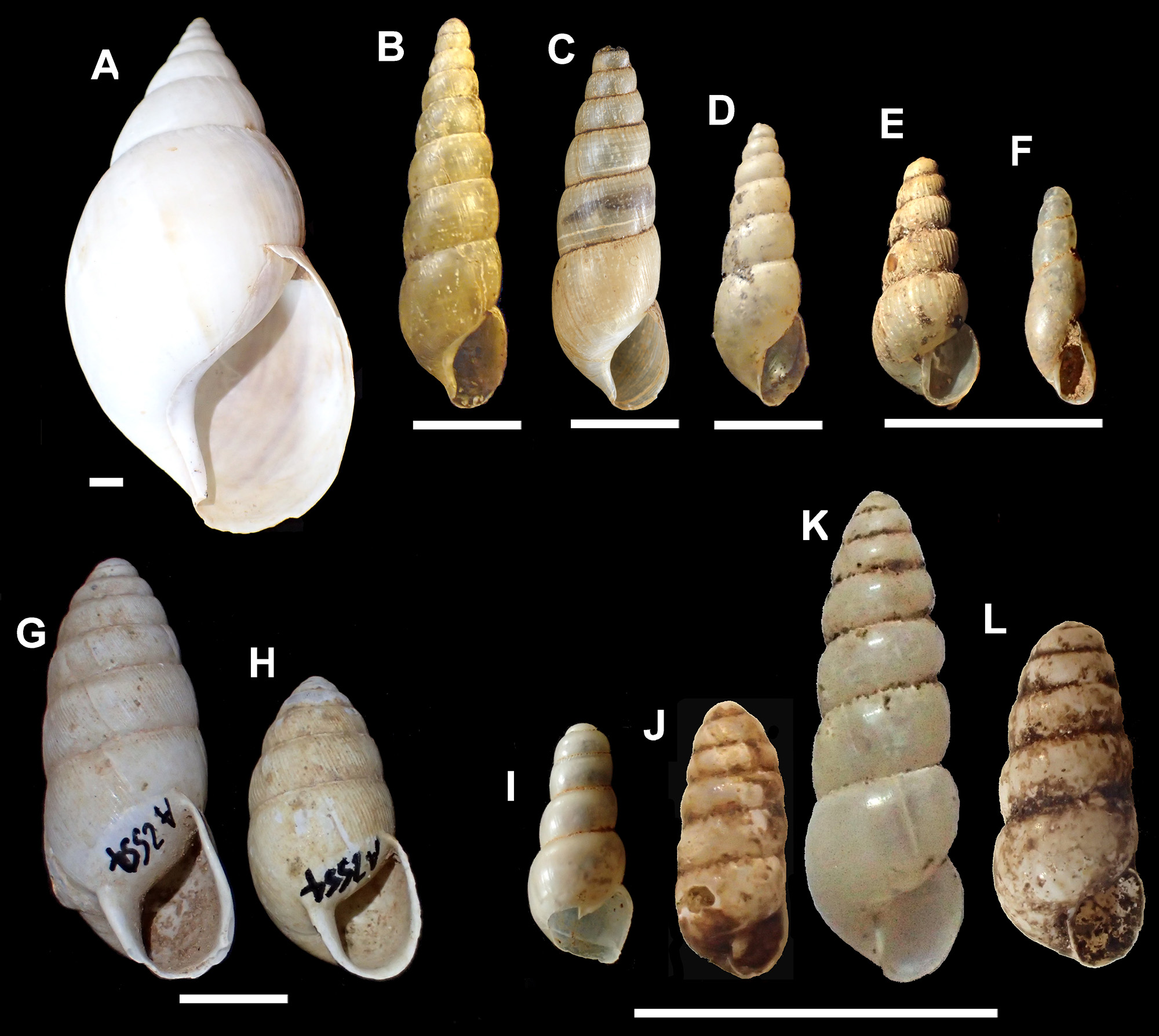
Lissachatina fulica (Bowdich, 1822) (Fig. 11A)
Achatina fulica Férussac, Fischer-Piette et al. 1994: 43
Distribution.—This invasive species was introduced to Madagascar in the 1800s and is found throughout the island (Fischer-Piette et al., 1994). In Narinda North old shells were found near the Anjajavy airstrip only.
Material studied.—JG: 13/19 x 1 (UF 583331).
Subulina mamillata (Craven, 1880) (Fig. 11B)
Distribution.—Widely distributed and thought to be introduced from Africa (Emberton and Pearce, 2000). In Narinda North recorded from Anjajavy, Ambalatsingy, and Nosy Lava. Widespread in dry forest throughout the area.
Material studied.—OLG: 33/03 x 16; 36/03 x 25; 38/03 x 26; 40/03 x41; 8/04 x138; 15/04 x 45. KE: MBI-2581 (UF 430965 x 22); MBI-2582 (UF 430950 x 1, 433343 x 1); MBI-2583 (UF 425637 x 1 ethanol, 430945 x 9); MBI-2585 (UF 430916 x 5); MBI-2586 (UF 430958 x 7); MBI-2587 (UF 430949 x 6); MBI-2588 (UF 430927 x 2); MBI-2589 (UF 430935 x 6); MBI-2590 (UF 430971 (UF 4); MBI-2591 (UF 430954 x 2); MBI-2592 (UF 430934 x 7); MBI-2593 (UF 425652 x 1 ethanol, 430925 x 7); MBI-2594 (UF 430957 x 8); MBI-2595 (UF 430977 x 7); MBI-2596 (UF 430972 x 7); MBI-2597 (UF 430941 x 13). JG: 03/19 x 12.
Subulina cf. manampetsaensis Fischer-Piette and Testud, 1964 (Fig. 11C)
Distribution.—A species known only from the south-west of Madagascar. The slightly twisted spire appears to be characteristic of the species. In Narinda North known from one sample from Anjajavy.
Material studied.—KE: MBI-2581 (UF 433344 x 11).
Allopeas gracile (Hutton, 1834) (Fig. 11D)
Lamellaxis (Allopeas) gracilis (Hutton), Fischer-Piette et al., 1994: 36
Distribution.—A widely introduced species. In Narinda North found at Anjajavy and Ambalatsingy; Nosy Lava; Nosy Lagna; Nosy Soy; Nosy Faho. Locally abundant.
Material studied.—OLG: 38/03 x 10 (UF 583333); 39/03 x1; 10/04 x 16; 15/04 x 17; 16/04 x 73; 17/04 x 5; 18/04 x 146. JG: 03/19 x 1.
Pseudopeas valentini Fischer-Piette et al., 1994 (Fig. 11E)
Distribution.—Known previously from several sites in Madagascar: central east – Mantadia and Sahafina; central west – Beanka and Kasiji; north – Montagne D’Ambre. In Narinda North known from Anjajavy and Ambalatsingy.
Material studied.—OLG: 33/3 x 5; 36/03 x 3; 39/03 x 10; 40/03 x 2; 8/04 x 1. KE: MBI-2584 (UF 433604 x 1); MBI-2588 (UF 430651 x 2); MBI-2589 (UF 430609 x 1); MBI-2590 (UF 559810 x 1); MBI-2592 (UF 545270 x 6); MBI-2594 (UF 433609 x 1); MBI-2597 (UF 430976 x 2).
Family FERUSSACIIDAE Bourguignat, 1883
Geostilbia mariei Crosse, 1880 (Fig. 11F)
Ceciliodes (Geostilbia) mariei (Crosse, 1880) Fischer-Piette et al., 1994: 30
Distribution.—Described from Nosy Be. Known also from Montagne des Francais and Windsor Castle in the north, and Bemaraha and Mangoky in the central west. In Narinda North found only at Anjajavy.
Material studied.—OLG: 38/3 x 3 (UF 583335).
Family STREPTAXIDAE Gray, 1860
Edentulina minor (Morelet, 1851) (Fig. 11G–H)
Distribution.—Species found in northern and western Madagascar (Emberton, 1999). In Narinda North found in rocky areas at Anjajavy, Ambalatsingyand Nosy Soy. Within populations, shells vary considerably from elongate: 23.0 mm height x 8.5 width, to squat and broad: 20.5 mm height x 11.0 mm width. Body bright pale yellow.
Material studied.—OLG: 33/03 x 31; 36/03 x 12; 37/03 x 48 (NHMUK, UMZC); 38/03 x 8; 39/03 x5; 40/03 x 14; 5/04 x 1; 6/04 x 9; 8/04 x 8; 9/04 x 4; 11/04 x 35; 17/04 x 1. KE: MBI-2581 (UF 433760 x 1); MBI-2582 (UF 431448 x 6); MBI-2585 (UF 433761 x 1); MBI-2586 (UF 425472 x 1 ethanol, 431451 x 8); MBI-2587 (UF 433762 x 2); MBI-2588 (UF 433763 x 1); MBI-2589 (UF 433764 x 5); MBI-2590 (UF 433765 x 8, 433766 x 8); MBI-2591 (UF 433767 x 1); MBI-2592 (UF 433768 x 10); MBI-2593 (UF 431450 x 3); MBI-2594 (UF 433769 x 3, 433770 x 3); MBI-2595 (UF 433771 x 12); MBI-2596 (UF 433772 x 7); MBI-2597 (UF 433773 x 3, 433774 x 3). JG: 10/19 x 2; 12/19 x 2; 06/19 x 1.
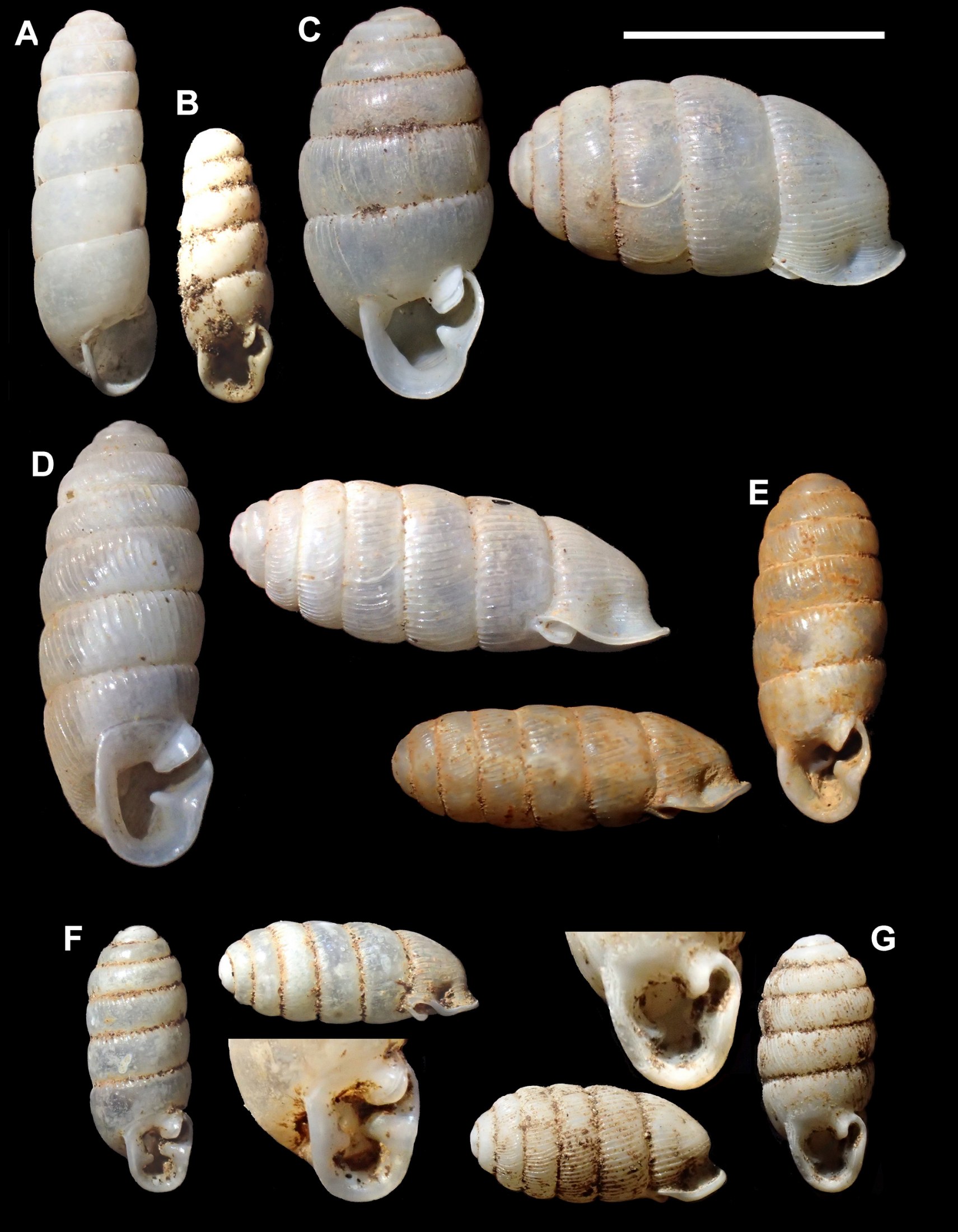
Gulella bicolor (Hutton, 1834) (Fig. 12A)
Distribution.—In Madagascar previously only recorded from Nosy Be. Introduced. Recorded here from Nosy Lava for the first time.
Material studied.—OLG: 15/04 x 3 (UF 583337).
Gulella andreana Fischer-Piette et al., 1974 (Fig. 12B)
Distribution.—A widespread species occurring over much of coastal and lowland Madagascar. In Narinda North recorded from Ambalatsingy and Nosy Lava.
Material studied.—OLG: 33/03 x 12 (NHMUK, UMZC); 36/03 x 9; 37/03 x 2; 38/03 x 8; 39/03 x 11; 40/03 x 10; 8/04 x 4; 15/04 x 1. KE: MBI-2581 (UF 430090 x 1); MBI-2586 (UF 569402 x 6); MBI-2589 (UF 545288 x 6); MBI-2596 (UF 559932 x 2). JG: 4/19 x 1.
Gulella foucaultia sp. nov. (Fig. 12C; Table 1)
Holotype.—NHMUK 20220204.
Paratypes.—NHMUK 20220205, AM C.593593 (3), PBZT T186 (2).
Description.—Shell broadly pupiform; height 8.3 mm, width 3.7 mm. 7.6 whorls, almost straight sided and slanting inwards towards base. First 2 whorls smooth; next 3 with weak radial ribbing across the whorl; last 2 whorls with very weak to obsolete ribbing, becoming strong again just before lip around the palatal tooth indentation. Suture with strong crenulations. Aperture with 2–3 teeth: a strong blade-like slightly curved parietal tooth ending opposite a strong raised palatal tooth creating a crescent shaped area in upper right of aperture. Columellar recessed baffle narrow. On the left side of aperture is a weak mid-columellar tooth that is absent in many specimens. Shell colorless, translucent.
Distribution.—Narinda North – Anjajavy and Ambalatsingy; Nosy Lava.
Material studied.—OLG: 36/03 x 1; 8/04 x 24 (NHMUK 20220204 x 1 holotype, 20220205 x 7 paratypes; PBZT T186 x 2 paratypes); 9/04 x 3; 11/04 x 6 (AM C.593593 x 3 paratypes); 15/04 x 3. KE: MBI-2589 (UF 433176 x 1); MBI-2595 (UF 559888 x 1).
Comparison.—Of the two or three-toothed Gulella it is closest to G. ambrensis Emberton, 2001 but differs in size (over 7.2 mm compared to under 6.3 mm), more angled whorls, apertural dentition (less prominent baso-columellar lamella), and more even sculpture.
Etymology.—Named after Cédric de Focault, General Manager of Anjajavy Le Lodge until 2019, who provided invaluable assistance.
Gulella martiniana sp. nov. (Fig. 12D; Table 1)
Holotype.—NHMUK 20220206.
Paratypes.—NHMUK 20220207 (8), UMZC 2022.31.3 (5), AM C.593594 (2), PBZT T187 (5).
Description.—Shell elongate; height 8.9 mm, width 3.4 mm. 8.8 slightly rounded whorls, giving the shell a cylindrical appearance. First 2 whorls smooth, later whorls sculptured with radial growth ridges becoming stronger and denser on last half whorl. Crenulations along well-defined suture. Aperture with 2 teeth: a strong blade-like slightly curved parietal tooth ending opposite a strong raised palatal tooth creating a crescent-shaped area in the upper right of aperture. Columellar recessed baffle narrow. Shell colorless, translucent.
Distribution.—Narinda North – Anjajavy; Nosy Soy.
Material studied.—OLG: 37/03 x 3 (AM C.593594 x 2 paratypes); 38/03 x 20 (UMZC 2022.31.3 x 5 paratypes; PBZT T187 x 5 paratypes); 40/03 x 9 (NHMUK 20220206 x 1 holotype, 20220207 x 8 paratypes); 17/04 x 5 juveniles. KE: MBI-2592 (UF 545294 x 5); MBI-2593 (UF 430632 x 8); MBI-2594 (UF 433178 x 23).
Comparison.—Of the two or three-toothed Gulella this most resembles G. bemarahae Emberton, 2001 from which it differs principally in having one extra whorl and lower shell height/width ratio (h/w <3.09 compared to 3.13); stronger more pointed palatal tooth and less rounded whorls.
Etymology.—Named after Cédric Martin, General Manager of Anjajavy Le Lodge from 2019 who greatly facilitated the 2019 study.
Gulella anjajavyensis sp. nov. (Fig. 12E; Table 1)
Holotype.—NHMUK 20220198.
Paratypes.—NHMUK 20220199 (1), AM C.593595 (10).
Description.—Shell elongate, apically broad, tapering basally; height 5.9 mm, width 2.5 mm. 7.0 slightly convex whorls. First 2 whorls with very weak radial striations. Subsequent whorls with strong radial growth ribs. Aperture with 2 teeth: a strong blade-like slightly curved parietal tooth ending opposite a strong raised palatal tooth creating a crescent-shaped area in upper right of aperture. Columellar baffle recessed and broad. Shell colorless, translucent.
Distribution.—Narinda North – Anjajavy.
Material studied.—OLG: 33/03 x 10 (NHMUK 20220198 x 1 holotype, 20220199 x 1 paratype); 36/03 x 39 (AM C593595 x 10 paratypes). KE: MBI-2595 (UF 430152 x 1); MBI-2596 (UF 545278 x 13); MBI-2597 (UF 430665 x 5).
Comparison.—Appears similar to Gulella petitboucheti Emberton, 2001 from which it differs principally by its much stronger radial sculpture. G. petitboucheti overlaps the lower end of the size range of the present species (5.5 mm).
Etymology.—Named for the type locality.
Gulella volontany sp. nov. (Fig. 12F; Table 1)
Holotype.—NHMUK 20220202.
Paratypes.—NHMUK 20220203 (5), UMZC 2022.31.4 (4), AM C.593596 (4).
Description.—Shell elongately cylindrical; height 4.0 mm, width 1.8 mm. 7.2 whorls, first 4.5 distinctly convex, becoming straight sided by body whorl. First whorls smooth, subsequent whorls with weak to obsolete radial ribs, strong at suture. Aperture constricted, inverted ‘L’ shape. Parietal tooth very strong, angled to right of aperture and extending beyond aperture plain. Palatal tooth strong, well buttressed, extending over half-way across aperture; tip going beyond tip of parietal. Strong mid-columellar tooth almost meeting tip of palatal. Columellar baffle recessed and small, barely visible from directly above aperture. Shell colorless, translucent.
Distribution.—Narinda North – Anjajavy and Ambalatsingy.
Material studied.—OLG: 33/03 x 1; 36/03 x 4 (AM C.593596 x 4 paratypes); 38/03 x 1; 40/03 x 6 (NHMUK 20220202 x 1 holotype, 20220203 x 5 paratypes); 8/04 x 17 (UMZC 2022.31.4 x 4 paratypes). KE: MBI-2582 (UF 430719 x 2); MBI-2583 (UF 430662 x 4); MBI-2586 (UF 430121 x 7). MBI-2588 (UF 430690 x 1); MBI-2590 (UF 430687 x 2); MBI-2591 (UF 430597 x 18); MBI-2592 (UF 433177 x 2); MBI-2594 (UF 559797 x 1); MBI-2595 (UF 545287 x 1).
Comparison.—Most like G. mitsikia Emberton, 2001 but differs in dentition and more elongate shape (although there is complete overlap in shell proportions) and in being larger (maximum height 4.8 mm compared to 3.6 mm).
Etymology.—volontany, Malagasy adjective meaning brown; named after Ken Brown for his work on the Gulellinae.
Gulella antonibe sp. nov. (Fig. 12G, Table 1)
Holotype.—NHMUK 20220200.
Paratypes.—NHMUK 20220201, AM C.593597 (1).
Description.—Shell pupiform, slightly broadened apically; height 4.3 mm, width 2.0 mm. 7.1 whorls. First 2 whorls smooth, then sculpture of strong radial ribs equally spaced on all whorls up to lip. Aperture constricted. Parietal tooth strong, curved, extending beyond plain of aperture. Palatal tooth strong, very broad, creating effect of narrow passage with palatal. Strongly buttressed from above. Baso-central tooth small, set well back in aperture. Mid-columellar tooth strong, well buttressed from above. Columellar recessed baffle very large, filling over 50% of aperture. Shell white, opaque.
Distribution.—Narinda North – all specimens collected in the Anjajavy area.
Material studied.—OLG 39/03 x 7 (NHMUK 20220200 x 1 holotype, 20220201 x 2 paratypes); 40/03 x 1 (AM C.593597, paratype). KE: MBI-2596 (UF 433179 x 5); MBI-2597 (UF 569450 x 5).
Comparison.—Most like G. vakinifia Emberton, 2001, differing in the palatal tooth being entire, rather than bifid and being slightly larger (height at least 4.1 mm compared to 3.5 mm).
Etymology.—Named after Antonibe, a village near the collecting sites.
Parvedentulina tsingia Emberton, 2002 (Fig. 11J)
Distribution.—Previously only known from its type locality at Ankarana in northern Madagascar. In Narinda North found at Anjajavy and Ambalatsingy.
Material studied.—OLG: 33/03 x 1; 11/04 x 1 (NHMUK). KE: MBI-2588 (UF 433605 x 4); MBI-2589 (UF 432258 x 1); MBI-2591 (UF 433607 x 5).
Parvedentulina vitroni (Fischer-Piette et al., 1994) (Fig. 11K)
Streptostele (?) vitroni Fischer-Piette et al., 1994: 85
Parvedentulina vitroni (Fischer-Piette et al., 1994); Emberton, 2002: 123
Distribution.—Previously only known from its type locality at Ankarana in northern
Madagascar (Fischer-Piette et al., 1994; Emberton, 2002). In Narinda North found at Anjajavy and Ambalatsingy.
Material studied.—OLG: 8/04 x 6 (NHMUK x 3). KE: MBI-2584 (UF 563540 x 2); MBI-2586 (UF 430434 x 1); MBI-2589 (UF 433606 x 8); MBI-2590 (UF 430655 x 5); MBI-2592 (UF 433608 x 15); MBI-2593 (UF 433611 x 1); MBI-2595 (UF 430696 x 2).
Parvedentulina lavana sp. nov. (Fig. 11L; Table 1)
Holotype.—NHMUK 20220208.
Description.—Shell fusiform, apex evenly domed; height 4.6 mm, width 19 mm. 6.7 convex whorls ornamented with radial ridges which are distinct only near suture; no trace of spiral sculpture. Lip not expanded or reflected. Columella not significantly tapered, angled 10˚ from vertical. Umbilicus open, narrow (2% of shell diameter). Aperture narrowly ovate, slanted.
Distribution.—Nosy Lava.
Material studied.—15/04 x 1 (NHMUK 20220208 holotype).
Comparison.—Most similar to southern Madagascar species Parvedentulina morontsiraka Emberton, 2002 and P. saintjacqui Emberton, 2002 in size, shape and simple aperture. It differs from P. morontsiraka in the shape of the apex, has an angled, narrower aperture (h/w=1.44 compared to 1.50) rather than a vertical one, and a more tapered columella (columella middle/upper width 0.7 compared to 0.9), and lack of spiral sculpture. Parvedentulina saintjacqui is more robust and more strongly sculptured, the aperture is oval (mouth h/w=1.20),and the columella more strongly tapered (mid/upper = 0.5).
Etymology.—Named for Nosy Lava, the type locality.
Streptostele decaryi (Fischer-Piette et al., 1974) (Fig. 11I)
Notes.—Known from a single shell lacking precise locality. Represented here by a single damaged shell, identical to the type in all details of the spire (base missing).
Distribution.—Narinda North – Anjajavy.
Material studied.—JG: 05/19 x 1 (UF 583336).
Family ACAVIDAE Pilsbry, 1895
Embertoniphanta goudotiana (Férussac, 1839) (Figs. 15G, 21I)
Helicophanta goudotiana (Férussac, 1839) Fischer-Piette et al., 1994: 161
Embertoniphanta oviformis (Grateloup, 1840) Groh and Poppe, 2002: 45
Distribution.—The species occurs today principally in dry deciduous forest ranging from Morandava in the south-west to Ankarana in the north (Fischer-Piette et al., 1994). In Narinda North found in rocky areas throughout Anjajavy and Ambalatsingy. Anjajavy specimens are large for the species: up to 66 mm height and 43 mm width.
Reproductive anatomy.—Penis short, stout; simple. No distinct epiphallus.
Material studied.—OLG 33/03 x 5; 36/03 x 5; 37/03 x 4; 38/03 x 2; 39/03 x 4; 6/04 x 3 (old dead). KE: MBI-2582 (UF 418919 x 1, 420103 x 1); MBI-2594 (UF 418920 x 1). JG: 05/19 x 1; 12/19 x 2 (UF 583340).
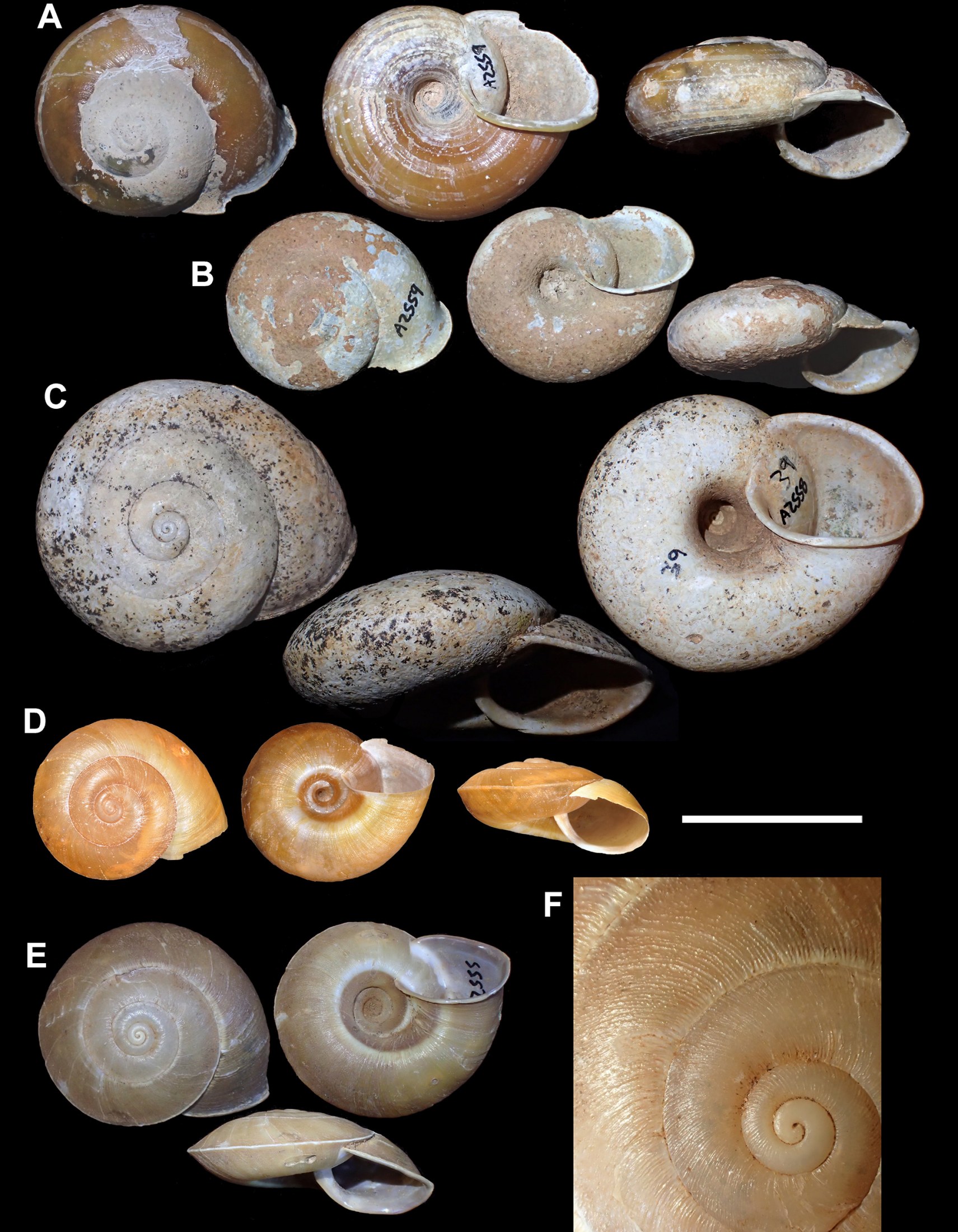
Ampelita anjajaviensis Emberton and Rakontondrazafy, 2020 (Fig. 13D–F; Table 1)
Distribution.—Narrow-range endemic known only from the Narinda North area. Described from fresh dead shells collected in 2007 from near Anjajavy, now also recorded from Ambalatsingy.
Some specimens are larger than the type specimens and differ slightly in shape and sculpture. These could be regarded as a separate species. However, the differences are small and the limits of variation in the present species are very poorly known. It is possible that typical A. anjajaviensis, the larger variant and the very similar A. namerokoensis Fischer-Piette, 1952 from the Bemaraha and Beanka karst areas south of Majunga are all conspecific.
Material studied.—Typical form – OLG 33/03 x 1 (old dead); 36/03 x 3 (old dead; UMZC); 37/03 x 4 (old dead); 38/03 x 1 (old dead); 40/03 x 7 (old dead); 11/04 x 1 (old dead). KE: 07/07 x 5 (UF 418628, 419072); 09/07 x 1 (UF 418627); 14/07 x 2 (UF 418626, 418629).
Larger variant – OLG 36/03 x 9 (2 x fresh dead; 7 x old dead – NHMUK); 40/03 x 1 (old dead).
Note.—The larger variant (Fig. 13E–F) differs in size (15.4–16.4 x 32.0–33.1 vs 11.3 x 23.9 mm in typical A. anjajaviensis) and lacks the spiral striae of A. anjajaviensis over most of the shell, having prominent pustular radial ridges instead and only a trace of spiral striae at the sutures. The body whorl also slopes more gently and descends before the aperture less steeply.
Ampelita capuroni Fischer-Piette et al., 1974 (Fig. 13A)
Distribution.—Mostly confined to upland rainforest in the Andasibe and Moramanga areas east of Tananarive. Also occurs in tall dry deciduous forest in the Bongolava Mountains, 125 km west of Tsiroanomandidy. In Narinda North only found at Anjajavy. Probably locally extinct due either to the massive deforestation in the area or to climate change, or both. The specimens from the Anjajavy area are in all aspects identical to shells from the type locality (Manerinerina) including the distinctive spiral color bands on the underside, except that they are much smaller: height 20.8 mm; width 40.2 mm.
Material studied.—OLG 33/03 x 2 (old dead).
Ampelita gaudens (Mabille, 1886) (Fig. 13C).
Distribution.—A widespread moist forest species ranging from Betampona, north of Tamatave in the east, to Antalaha and west to Nosy Be. In Narinda North known from Anjajavy and Ambalatsingy. Probably locally extinct due either to the extensive deforestation in the area or climate change, or both. Specimens from the Anjajavy area are of average size for the species: height 32.2 mm; width 57.8 mm.
Material studied.—OLG 37/03 x 2; 38/03 x 2; 39/03 x 1; 6/04 x 3 (UF 583338), all old dead. KE: MBI-2588 (UF 419040 x 1).
Ampelita cf. ela Emberton and Rakotondrazafy, 2020 (Fig. 13B; Table 1)
Notes.—The specimens from Anjajavy superficially resemble A. ela from Namoroka karst south of Majunga in terms of shell form, with well reflected lip and deep umbilicus. However, as A. ela is described from a specimen encrusted with lime deposits it is difficult to make an exact comparison.
Distribution.—Narinda North – Anjajavy.
Material studied.—OLG 33/03 x 2 old dead (NHMUK, AM C.593598).
Family EUCONULIDAE Baker, 1928
Microcystis embertoni sp. nov. (Fig. 14D; Table 1)
Holotype.—UF 432447.
Paratypes.—UF 569824 (2).
Description.—Shell discoidal with a low spire; height 2.0 mm, width 3.1 mm. 4.2–5.0 whorls. Body whorl rounded, slightly high shouldered. Surface matt with spiral striae. Aperture circular-lunate. Umbilicus narrow (4% of shell width), bordered by reflected columella. Lip not reflected or thickened. Shell pale brown.
Distribution.—Narinda North – only found at Anjajavy.
Material studied.—KE: MBI-2582 (UF 432447 x 1 holotype, 569824 x 2 paratypes); MBI-2583 (UF 559891 x 3); MBI-2585 (UF 429755 x 2); MBI-2586 (UF 554081 x 6); MBI-2587; (UF 554106 x 5); MBI-2588 (UF 554103 x 5); MBI-2591 (UF 554090 x 5); MBI-2592 (UF 559814 x 5).
Comparison.—One of the smallest Microcystis species; the only similar sized species are M. kendrae Emberton and Griffiths, 2009, M. fotsifotsy Emberton et al., 2010 and M. vony Emberton et al., 2010, all of which are smaller (maximum 1.6 x 2.3 mm), and M. sahavondrononae Emberton, 1994 which is the same size (2.6 x 3.7 mm). Of these, only M. vony is similar in shape, but lacks any trace of spiral sculpture.
Etymology.—Named for Kenneth Emberton for 30 years of dedication to the discovery and conservation of Madagascar’s diverse land snail fauna.
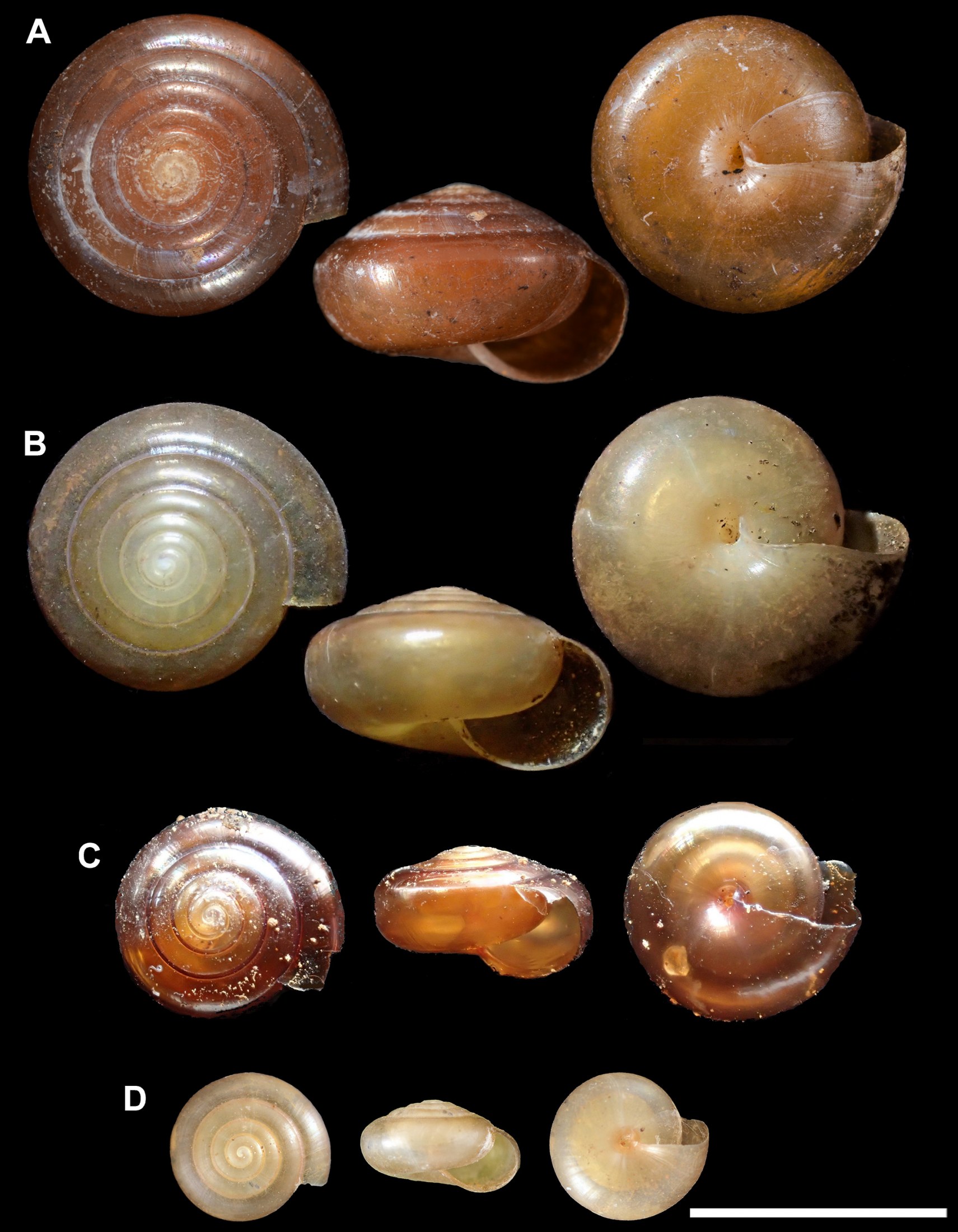
Microcystis zorony sp. nov. (Fig. 14A; Table 1)
Holotype.—UF 539640.
Paratypes.—UF 429715 (194), UF 429746 (38).
Description.—Relatively large for a Microcystis. Height 4.1 mm, width 6.3 mm. 5.9–6.7 flat sided whorls. Aperture quadrangular; width 3.2 mm, height 2.5 mm. Shell depressed helicoid with slightly raised spire. Whorls flat-sided and base rounded, giving a very distinct shape. . Lip margin sinuous, not expanded or reflected. Umbilicus open, minute (2% of shell diameter). Smooth.
Distribution.—Narinda North – Anjajavy and Antonibe.
Material studied.—OLG: 33/03 x 1. KE: MBI-2586 (UF 429715 x 194 paratypes); MBI-2591 (UF 539640 x 1 holotype, UF 429746 x 38 paratypes).
Comparison.—The only Malagasy Microcystis with an angulate shoulder and flattened rather than rounded periphery. This characteristic is especially pronounced in juveniles.
Etymology.—From the Malagasy adjective zorony, meaning angled describing the angulate shoulder on the shell periphery.
Microcystis aff. viaregina Emberton, 1994 (Figs. 14B–C, 20B–C, 21F; Table 1)
Description.—Shell discoidal with a low spire; height 3.6 mm, width 6.1 mm. 4.5–6.0 flat sided whorls. Body whorl slightly compressed laterally, giving a rounded quadrangular profile. Highly glossy with indistinct fine growth lines, 2–3 extremely fine spiral striae visible only at suture. Aperture circular-lunate. Umbilicus narrow (3–9% of shell diameter), bordered by reflected columella. Columella slanting at an angle of 50˚. Lip not reflected or thickened. Lip edge sinusoidal in ventral view. Shell dark brown, suture white.
Body.—Light gray to bluish gray, tentacles very dark. A very prominent dark caudal horn present.
Reproductive anatomy (Fig. 20B–C).—Penis very slender; epiphallus long, broadening distally with a very long flagellum bound to retractor muscle. Penis and epiphallus within penial sheath; retractor muscle attached to tip of epiphallus. Spermatheca branching off from penis base, duct basally inflated, remainder elongate, simple.
Distribution.—Narinda North – Anjajavy and Ambalatsingy.
Material studied.—OLG: 33/03 x 34; 34/03 x 21; 36/03 x 6; 37/03 x 1; 38/03 x 125 (AM C.593601); 39/03 x 80 (AM C.593602); 40/03 x 65 (UMZC); 8/04 x 38 (NHMUK); 11/04 x 51 (NHMUK). KE: MBI-2581 (UF 429740 x 10); MBI-2582 (UF 429762 x 40); MBI-2583 (UF 429766 x 33); MBI-2584 (UF 429743 x 1); MBI-2587 (UF 429748 x 16); MBI-2588 (UF 429751 x 30); MBI-2590 (UF 429725 x 50); MBI-2592 (UF 433482 x 75); MBI-2593 (UF 429752 x 40); MBI-2594 (UF 429723 x 65); MBI-2595 (UF 429719 x 75); MBI-2596 (UF 429726 x 50); MBI-2597 (UF 429724 x 50). JG: 04/19 x 4; 06/19 x 2; 08/19 x 7.
Comparison.—Resembles the preceding species but with a lower spire and narrower aperture with an angled columella. Very like M. viaregina Emberton, 1994 from eastern Madagascar which has a less sinuous aperture margin.
Note.—Some specimens (JG: 02/19 x 1; 08/19 x 1; 11/19 x 1; 16/19 x 1) (Fig. 14C) may be a different form, smaller although with the same number of whorls (4.0–5.2), a more quadrangular periphery, evenly curved on underside, peripheral spiral striae absent. Anatomically the penis is slightly expanded terminally; spermatheca duct base not inflated (Fig. 20B).
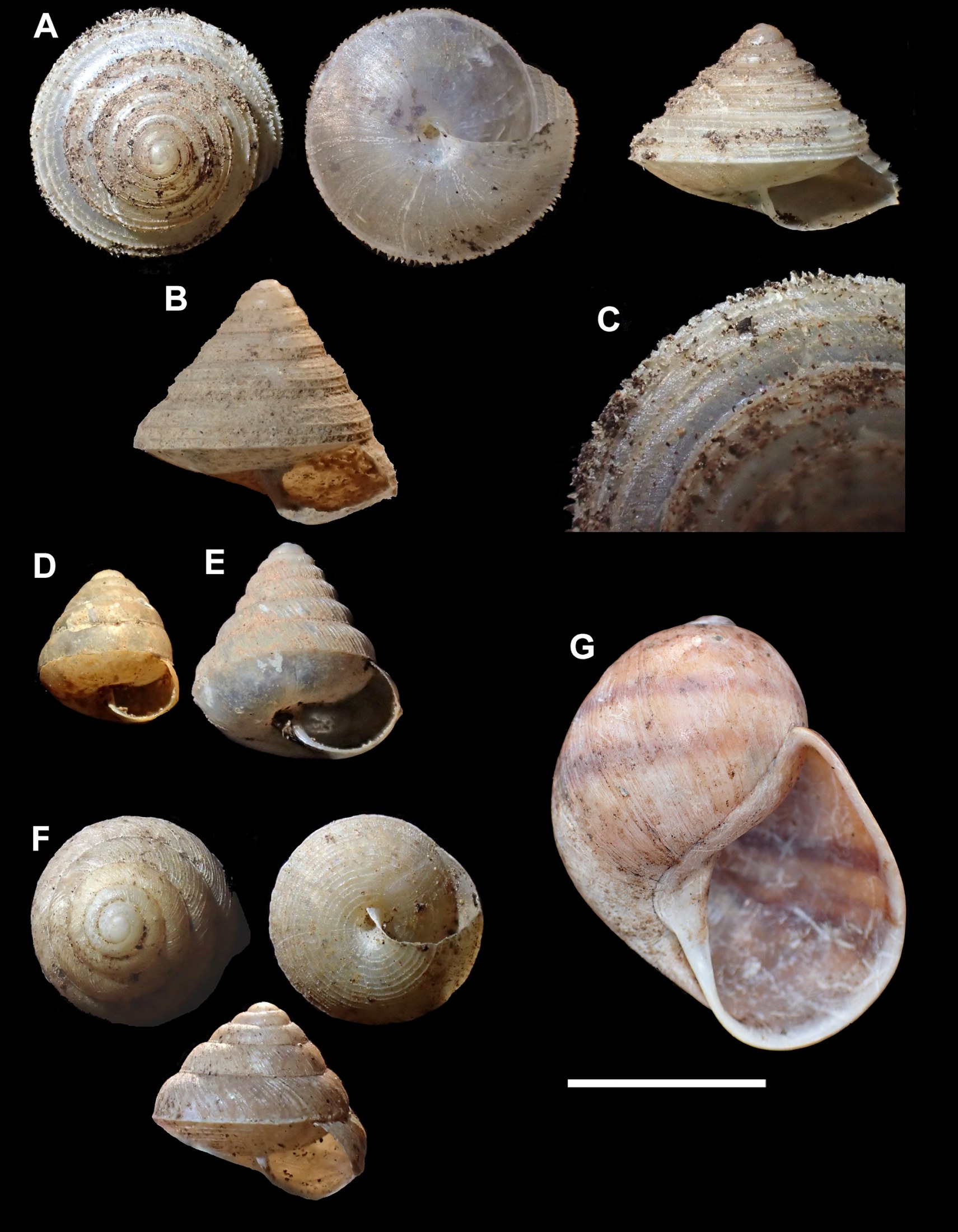
Family HELICARIONIDAE Bourguignat, 1877
Sitala dickensi sp. nov. (Figs. 15A–C, 20D, 21G; Table 1)
Holotype.—NHMUK 20220209.
Paratypes.—NHMUK 20220210 (7), UMZC 2022.31.5 (2), AM C.593603 (3), PBZT T188 (1).
Description.—Shell low conical; height 6.0 mm, width 7.5 mm. 5.5–6.7 slightly convex whorls. Apical 2 whorls acute (50–70˚), remainder more obtuse (35–60˚). Apical whorl smooth, others ornamented with 3 spiral ridges between 2 fine spiral striae. Striae develop into low ridges from 3rd whorl. Fine radial growth lines cross the ridges, forming low crenulations. Crenulations support deciduous periostracal bristles which are largest on lowest, peripheral carina. These bristles are 0.24 mm long, spaced 0.19 mm apart. Bristles worn off most older shells. Underside with irregular growth lines only. Umbilicus minute (4% of shell diameter), bordered by the reflected columella. Aperture rhomboidal, 31–33% of shell height, lip not expanded, slightly reflected at upper part of columella.
Tail with a very short, obtuse caudal horn. Body gray with darker tentacles. Mantle off-white with black speckling, speckles form bars along rectum. Mantle edge greenish with white speckling.
Reproductive anatomy (Fig. 20D): penis elongate, slender, strongly twisted around epiphallus; retractor attached terminally; epiphallus very slender, with short, broad terminal flagellum. Spermathecal duct slender, spermatheca oval.
Distribution.—Narinda North – Anjajavy. Found in areas of ‘tsingy’.
Comparison.—Two Sitala species have ‘bristly sculpture’: S. elegans Emberton and Pearce, 2000, but these are slender, well-spaced 0.8 mm long bristles on three carinae; and S. hirsuta Emberton and Griffiths, 2009, which has more spiral striae, only two of which bear hairs. Angulate striae are also found in the conical Sitala species S. gromatica Godwin-Austen, 1882 and S. patwrightae Emberton, 1994 but the present species differs from these in proportions. S. madecassina (Fischer-Piette and Salvat, 1966), S. frenesti Fischer-Piette et al., 1994 and S. kendrae Emberton and Griffiths, 2009 also have angulate carinae, but only two.
Material studied.—OLG: 33/03 x 2 (UMZC 2022.31.5 x 2 paratypes); 36/03 x 31 (NHMUK 20220210 x 7 paratypes); 40/03 x 12 (AM C.593606 x 3 paratypes; PBZT T188 x 1 paratype). JG: 10/19 x 3 (NHMUK 20220209 holotype). KE: MBI-2586 (UF 427643 x 1); MBI-2589 (UF 427645 x 3); MBI-2593 (UF 427650 x 1).
Etymology.—Named after Dr. Tim Dickens, Fellow of Peterhouse, Cambridge who has provided invaluable support to JG.
Ctenophila tangolika sp. nov. (Fig. 15F; Table 1)
Holotype.—NHMUK 20220211.
Paratypes.—NHMUK 20220212 (5), UMZC 2022.31.6 (9), AM C.593604 (8); PBZT T189 (2).
Description.—Shell small, low conical; height 3.4 mm, width 4.1 mm. 5.3 moderately convex whorls. Whorls with a distinctly corded peripheral keel resulting in a corded suture. First half whorl smooth, then faint spiral striation becoming stronger but always weak, over entire upper side of rest of whorls. After 2nd whorl strong radial ridges develop that cover the rest of the upper side. Last whorl with distinct strong corrugated keel. Base lacking radial ridges but with 10–11 strong raised spiral cords, weak to absent in umbilical region. No lip but slightly reflected in columellar region. Umbilicus open (6% of shell diameter).Shell horn-brown.
Distribution.—Narinda North – Anjajavy and Ambalatsingy; Nosy Lava; Nosy Soy; Kasijy forest south of Majunga.
Material studied.—OLG 33/03 x 2; 36/03 x 13; 38/03 x 35 (AM C.593604 x 8 paratypes; PBZT T189 x 1 paratype); 39/03×40; 40/03 x 34 (NHMUK 20220211 holotype, NHMUK 20220212 x 5 paratypes); 8/04 x 12 (UMZC 2022.31.6 x 9 paratypes); 10/04 x 1; 17.04 x 18. KE: MBI-2586 (UF 431179 x 15); MBI-2593 (UF 431446 x 6); MBI-2594 (UF 425655 x 1 ethanol, 431441 x 15, 433488 x 1); MBI-2595 (UF 431171 x 7); MBI-2596 (UF 431337 x 9); MBI-2597 (UF 425664 x 2 ethanol, 431381 x 40).
Comparison.—A distinctive species. Only two Ctenophila species have been recorded from Madagascar: C. milloti (Fischer-Piette et al., 1975) and C. griffithsi Emberton, 1994 of southern Madagascar. Both are smaller (maximum 1.9 x 2.9 mm compared to a minimum of 2.9 x 3.5 mm) and lack the distinctive spiral ridges on the base. In addition, Sitala aliceae Emberton and Pearce, 2000 is of similar shape, but is also no more than 2.0 x 2.8 mm and has spiral striae on the spire, not the base.
Etymology.—tangolika is Malagasy for spiral, referring to the distinctive spiral sculpture on the base of the shell.
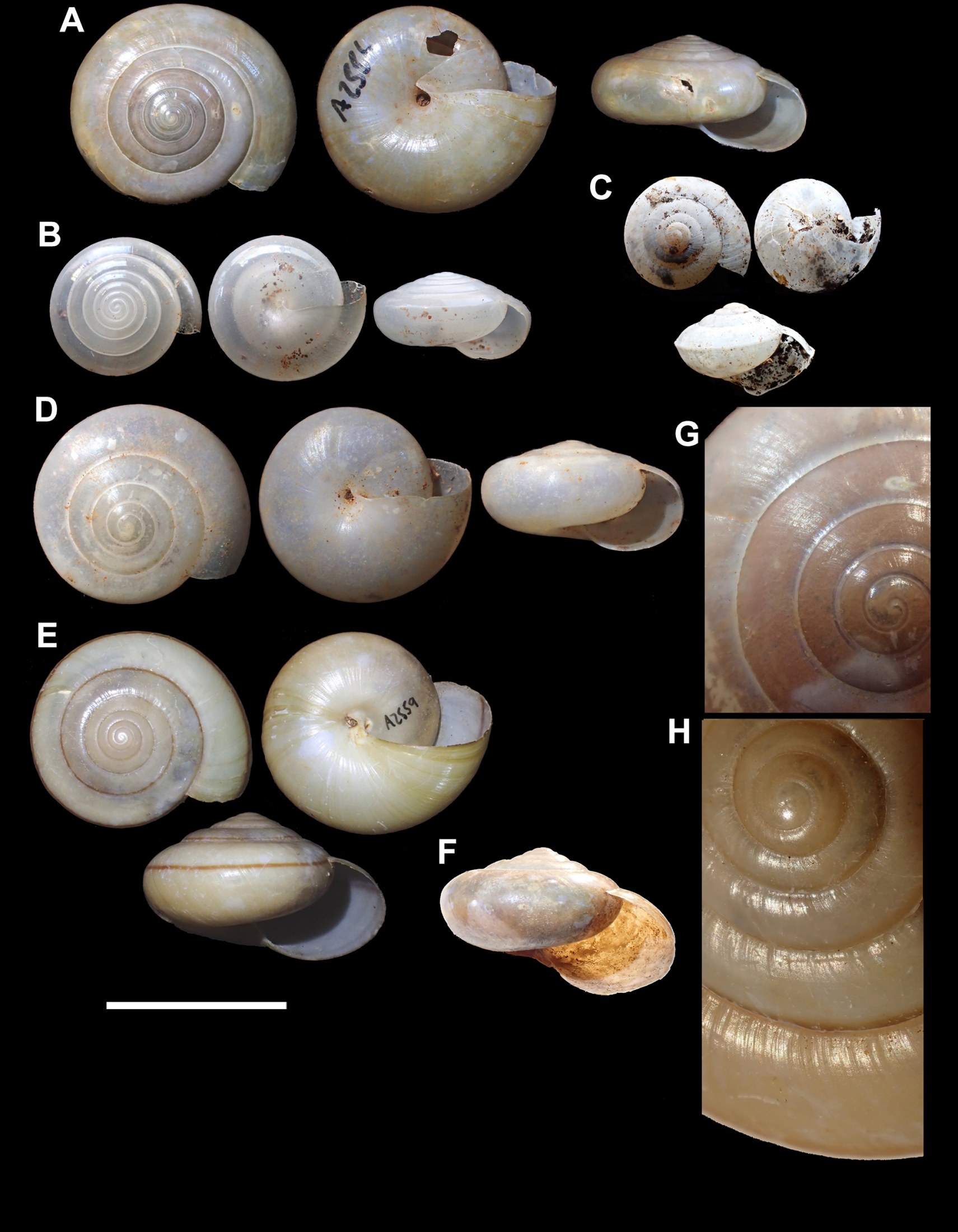
Kalidos cf. lamyi Fischer-Piette and Bedoucha, 1966 (Fig. 16A)
Notes.—Similar to K. lamyi except in having almost undetectable spiral striation. Kalidos lamyi is known from Cap d’Ambre to Ankarana. If this taxon is K. lamyi our records are a significant range extension for the species. However, it is also possible this is a very similar undescribed species, unfortunately we do not have enough well-preserved material to differentiate between these two options.
Distribution.—Narinda North – Anjajavy.
Material studied.—OLG: 38/03 x 70 (NHMUK, UMZC). KE: MBI-2589 (UF 433471 x 2).
Kalidos microlamyi Fischer-Piette et al., 1974 (Figs. 16B, 21H)
Body.—Back of foot with a small angular caudal horn. Mantle with a small filiform lappet on the left side, a broad lobe on the right. Brilliant orange-yellow, mantle white.
Reproductive anatomy.—Penis short, broad; epiphallus long and slender, with a long, very slender flagellum and short caecum. This differs from all previously figured Kalidos species (Fischer-Piette et al., 1975; Griffiths and Herbert, 2013; Hyman and Ponder, 2010) in the very distinctive broad penis shape, other features are typical of the genus.
Radula.—17+11+1+11+17.
Distribution.—Northern Madagascar (Fischer-Piette et al., 1994). In Narinda North only found at Anjajavy.
Material studied.—OLG: 36/03 x 34 (NHMUK, UMZC). JG: 10/19 x 4.
Kalidos prunella Fischer-Piette et al.t, 1994 (Fig. 16C)
Distribution.—Previously recorded from northern Madagascar (Mont Tsaratanana – Fischer-Piette et al., 1994), also in western Madagascar (Bemaraha – OLG collection). In Narinda North only known from Anjajavy.
Material studied.—OLG: 33/03 x 1; 37/03 x 2; 38/03 x 3 (NHMUK). JG: 12/19 x 1. All adults.
Kalidos aff. pendutsaratae Emberton, 2007 (Fig. 16D, G; Table 1)
Description.—Shell globose-discoidal; height 6.3 mm, width 10.6 mm. 4.6–5.5 very slightly convex whorls. Body whorl evenly curved. Translucent, surface highly glossy, indistinct fine growth lines, very faint microscopic spiral sculpture, usually restricted to near sutures. Umbilicus extremely narrow (2–9% of shell diameter), partially obscured by reflected columella. Aperture lunate. Lip not reflected or thickened, base sinuous. Shell pale brown to uniformly white.
Distribution.—Narinda North – Anjajavy and Ambalatsingy, Nosy Soy, Nosy Lava; widespread in forest.
Material studied.—OLG: 33/03 x 32; 34/03 x 21; 36/03 x 73 (AM C.593605, NHMUK); 37/03 x 1; 38/03 x 223 (AM C.593599, NHMUK); 39/03 x 85; 40/03 x 45; 8/04 x 103; 11/04 x 34 (AM C.593600); 15/04 x 3 (NHMUK); 17/04 x 2 (NHMUK). JG: 10/19 x 11. KE: MBI-2592 (UF 427647 x 9, 429718 x 16).
Comparison.—There are several similar shaped and sized Kalidos species described (Emberton, 2007; Emberton et al., 2010) and many undescribed from different parts of Madagascar. These need a comprehensive review. This taxon is most similar to K. pendutsaratae in its white color and sinuous lip.
Kalidos unistriata sp. nov. (Fig. 16E–F, H; Table 1)
Holotype.—NHMUK 20220217.
Paratypes.—NHMUK 20220218 (8), UMZC 2022.31.7 (14), AM C.593606 (6); PBZT T190 (8).
Description.—Shell relatively large subglobose; height 18.6 mm, width 30.9 mm. 6.0 evenly expanding whorls. Glossy with 1 peripheral brown band, 1.5 mm width. Shell covered in very thin brown periostracum. First whorl smooth. Rest covered in very fine, dense spiral sculpture only visible under magnification. Underside with similar spiral sculpture that is more prominent. Umbilicus, narrow, shallow. Lip thin, not reflected or thickened. Shell pale yellowish gray with a narrow spiral supraperipheral band. Band usually very narrowly visible at suture. Some individuals have the band slightly further from the periphery, so it lies above the suture (37/03, MBI 907). The band is very rarely absent. Rarely uniform orange-brown with slightly darker wider brown band above periphery (39/03) or uniformly olive brown (one from 37/03 – Fig. 16F).
Distribution.—Narinda North – Anjajavy, Ambalatsingy and Anjohibé.
Material studied.—OLG: Narinda North: 33/03 x 48 (NHMUK 20220217 x 1 holotype, 20220218 x 8 paratypes); 37/03 x 6 (AM C.593606 x 6 paratypes); 39/03 x 2 (fully brown shell); 6/04 x 57; 5b/04 x 2; 8/04 x 32 (PBZT T190 x 8 paratypes); 9/04 x 3; 11/04 x 148 (UMZC 2022.31.7 x 14 paratypes). Anjohibe: MBI 907 x 6.
Comparison.—Its size, smooth shell with only very fine spiral sculpture and single peripheral band is unlike any described Kalidos. It is similar to an unnamed Kalidos from Kasijy and Antsingimavo. However, the latter has a much flatter spire making the shell almost discoid and has two parallel thin brown bands on the periphery.
Variation.—Anjohibe shells are smaller: maximum 16.8 x 26.8 mm compared to a range of 16.9–21.0 x 29.8–34.5 mm in other populations, with the brown band higher than usual, otherwise as per Narinda North specimens.
Etymology.— unistriata – Latin for one-banded, referring to the distinctive pattern of this species.
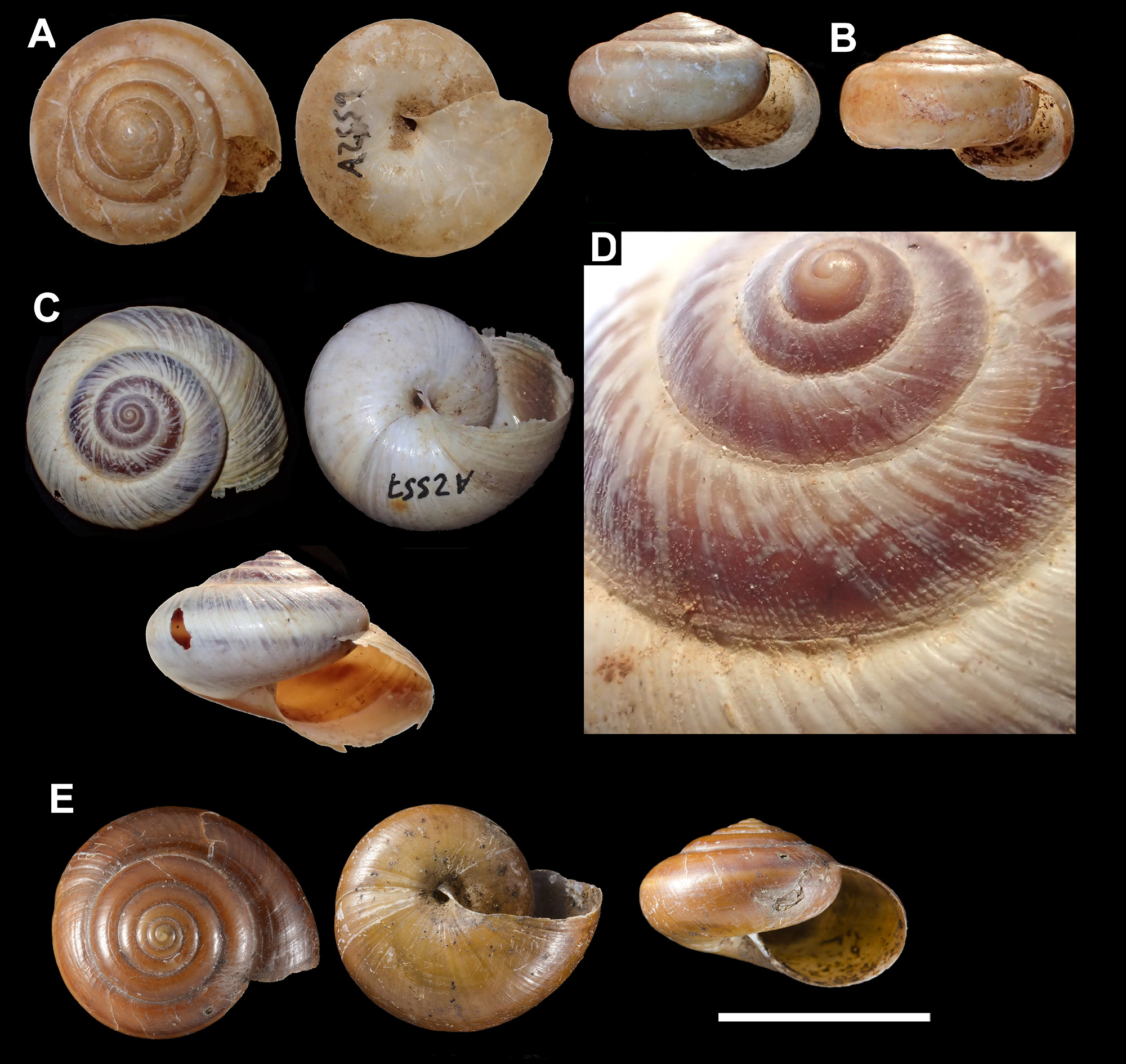
Kalidos quadrangulata sp. nov. (Fig. 17A–B; Table 1)
Holotype.—NHMUK 20220215.
Paratypes.—NHMUK 20220216 (2).
Description.—Shell subglobose to discoid with a low, evenly rounded spire; average height 11.6 mm, width 18.8 mm. 6 whorls, periphery regularly curved or quadrangular. Base flat. Shell glossy, smooth with very fine spiral striae barely visible at high magnification. Underside smooth. Umbilicus narrow, deep. Aperture lunate or flat based. Lip simple not reflected or thickened. Shell light brown with 2 ill-defined darker bands, one near periphery and one two thirds of way from periphery to suture.
Distribution.—Narinda North – Anjajavy. Known from three very old specimens, two broken. These old shells suggest it may be locally extinct.
Material studied.—OLG: 33/03 x 3 (NHMUK 2022015 x 1 holotype, 2022016 x 2 paratypes).
Comparison.—This species is unlike any other Kalidos species in its quadrangular body whorl and evenly lunate aperture.
Etymology.— quadrangulata, Latin for quadrangular, in reference to the distinctive body whorl shape of this species.
Kalidos narindana sp. nov. (Fig. 17C–D; Table 1)
Holotype.—NHMUK 20220213.
Paratypes.—NHMUK 20220214 (9), AM C.593607 (5).
Description.—Shell globose-lenticular, spire raised, broadly conical. Average height 14.8 mm, width 22.7 mm. Periphery bluntly angulate at the beginning of body whorl becoming rounded later on the body whorl. 5.3–5.5 slightly convex whorls. Suture moderately indented. Protoconch of 1 whorl ornamented with very fine spiral striae. Striae coarser and widely spaced on other whorls and interrupted by prominent irregular growth lines, resulting in a granular pattern. Striae not visible on underside. Aperture ovate-reniform. Lip not expanded. Columella angled, upper part reflected, partially covering umbilicus. Umbilicus narrow. Broad pale spiral band just above periphery, bordered above by a broad dark brown band and below by a narrower dark brown band. Margins of all bands poorly defined and dark bands partially obscured with white mottling. White band absent from spire, rest of shell pinkish brown. Suture white. Underside uniformly light yellowish brown. Columella white.
Distribution.—Narinda North – Anjajavy.
Material studied.—OLG: 33/03 x 5; 36/03 x 23 (AM C.593607 x 5 paratypes); 38/03 x 2; 40/03 x 33 (NHMUK 20220213 x 1 holotype, 20220214 x 9 paratypes). JG: 10/19 x 3. KE: MBI-2582 (UF 423996 x 5); MBI-2583 (UF 432490 x 1); MBI-2591 (UF 423995 x 1); MBI-2592 (UF 432482 x 1); MBI-2596 (UF 427653 x 1).
Comparison.—A distinctively marked and relatively large species, no known Kalidos of this size has this color pattern. It is closest to K. ternieri Fischer-Piette et al., 1994 but with distinctive striae on the protoconch and lacking any spiral sculpture on the base. K. ternieri has a smooth protoconch and microscopic spiral striae on the base, it is also largely brown with only very narrow paler bands. K. namorokae Emberton, 2007 is smaller (width 15.9 mm) and has prominent basal sculpture. K. maryannae Herbert and Griffiths, 2013 has similar sculpture, but this is more developed on the base and the shell is larger (27.3–29.3 mm diameter). In both species the colour pattern has some similarity but the dark bands are narrower and well defined, whereas the boundaries between bands in the present species are highly blurred.
Etymology.—Named for the geographical range of this distinctive species.
Kalidos mahafatifaty sp. nov. (Fig. 17E; Table 1)
Holotype.—UF 427649.
Paratypes.—UF 449142 (6).
Description.—Shell is depressed helicoid, height 19.9 mm, width 31.2 mm, with 6.3 moderately tightly coiled whorls. Whorls expand regularly until last half whorl which widens slightly, spire width 18.4 mm. Protoconch and early teleoconch whorls smooth, spiral striae develop on teleoconch and become progressively stronger especially on the slightly malleated body whorl. Shell periphery almost imperceptibly shouldered in early whorls becoming rounded on last half of the body whorl. Aperture oblique ovate-lunate, height 14.9 mm, width 18.0 mm. Umbilicus small, 1.40 mm, ⅓ covered by reflected inner edge of shell lip.
Color brown with poorly defined darker brown sutural and supraperipheral bands. Supraperipheral band is subtended by a tan band. Background color of some individuals is darker, obscuring the dark sutural and supraperipheral bands and lighter in others, obscuring the tan band.
Distribution.—Narinda North – Anjajavy.
Material studied.—KE: MBI-2586 (UF 449142 x 6); MBI-2593 (UF 427649 holotype).
Comparison.—A distinctive species; no other large, dark brown Kalidos species has been described.
Etymology.— mahafatifaty is a Malagasy adjective meaning delightful and engrossing for the beguiling, shiny, rich-brown shell, with subtle sculpture and banding pattern.
Family CHRONIDAE Thiele, 1931
Kaliella barrakporensis (Pfeiffer, 1852) (Fig. 15D)
Distribution.—Very widespread in Madagascar. Also occurs in south Asia; east and south Africa and the Comores (Fischer-Piette et al., 1994). In Narinda North known only from Anjajavy.
Material studied.—OLG 33/03 x 12 (UF 583339); 36/03 x 3; 38/03 x 3. MBI-2592 (UF 431175 x 1).
Kaliella soulaiana Fischer-Piette, 1973 (Fig. 15E)
Distribution.—Northern Madagascar (Fischer-Piette et al., 1994). In Narinda North found at Anjajavy and Ambalatsingy.
Material studied.—OLG 36/03 x 1; 40/03 x 6; 8/04 x 48 (NHMUK, UMZC). MBI-2594 (UF 427651 x 5).
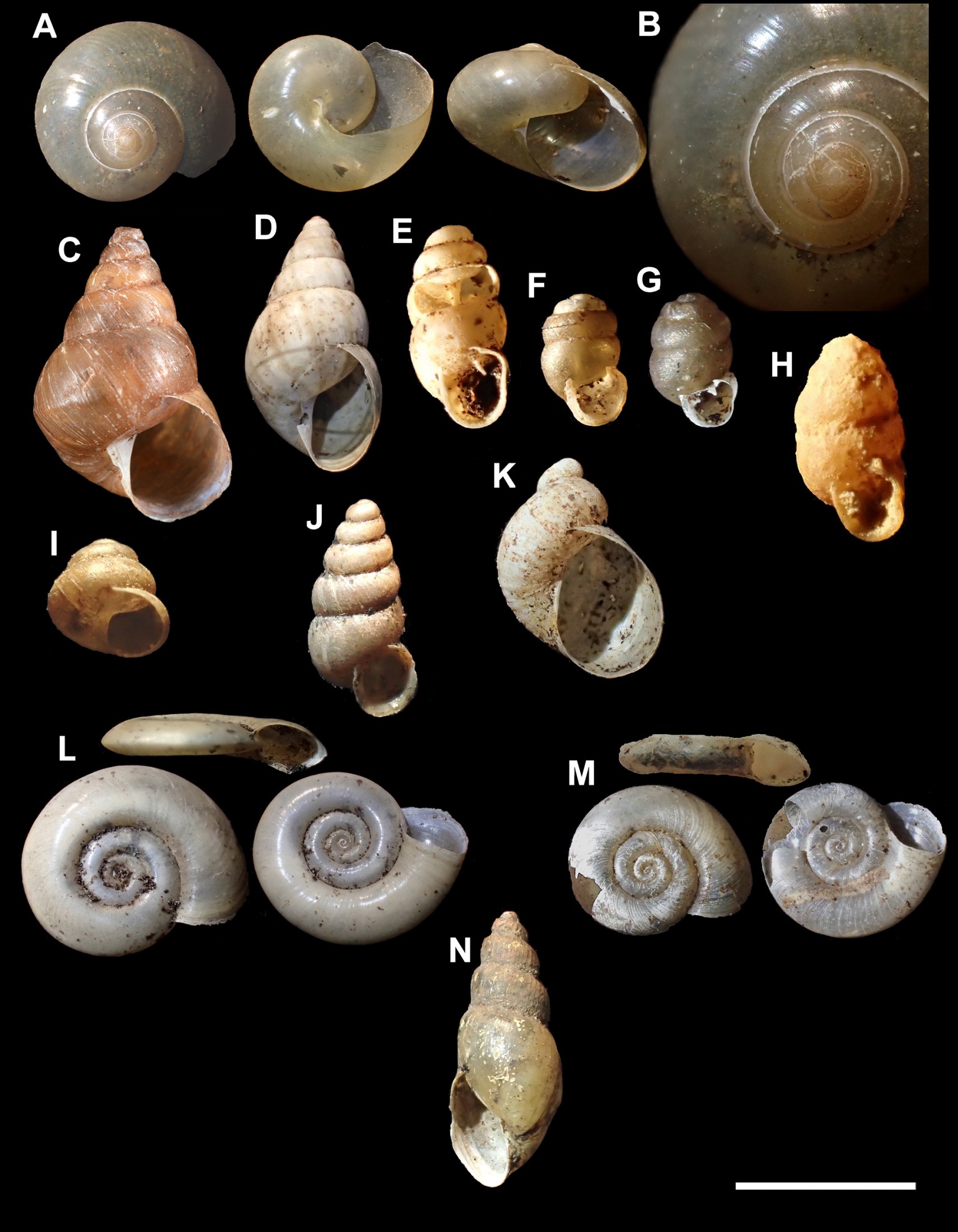
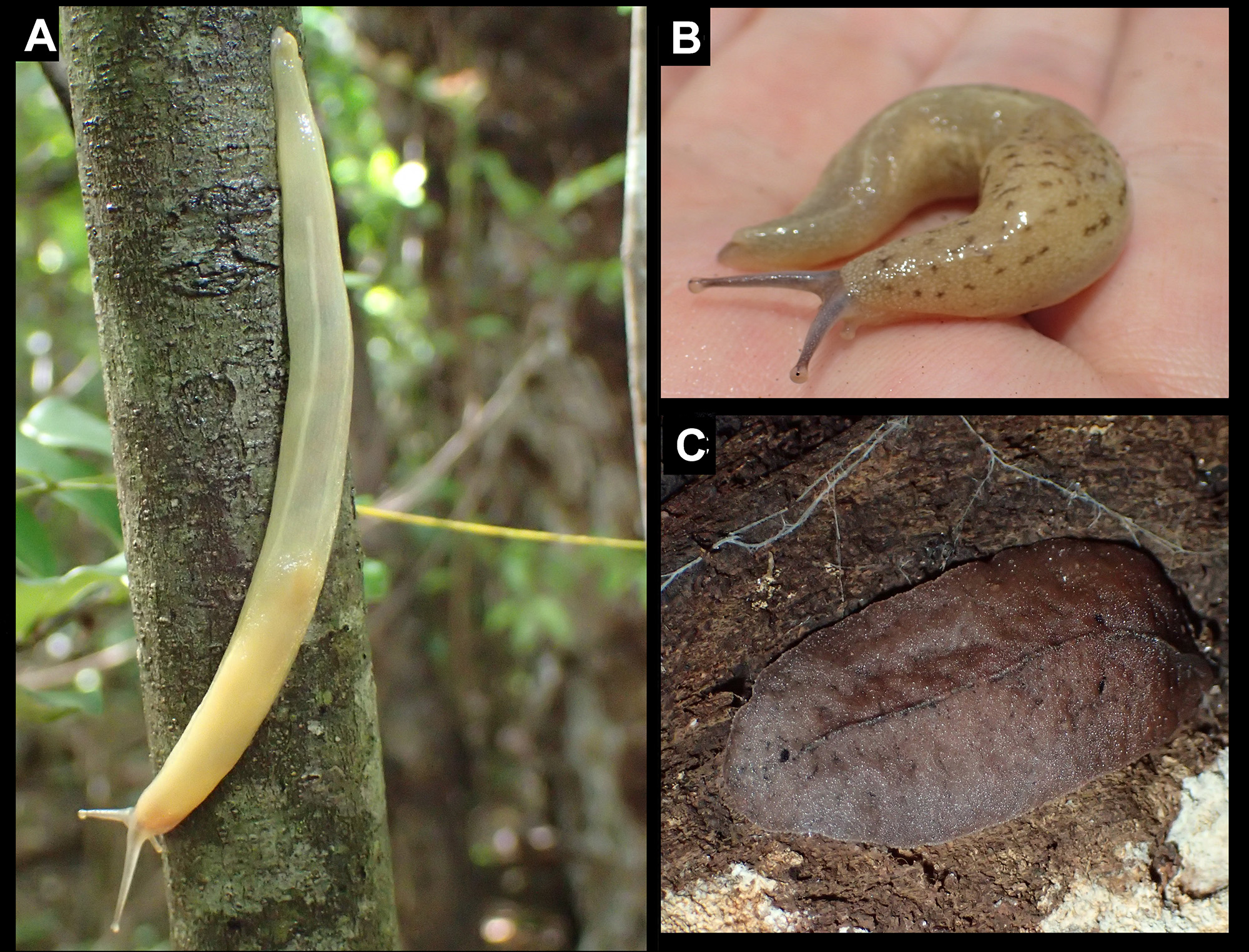
Family UROCYCLIDAE Simroth, 1889
Malagarion terzi (Fischer-Piette et al., 1994) (Figs. 18A–B, 20E, 21I) new generic placement
Granularion (?) terzi Fischer-Piette et al., 1994: 334
Notes.—Four semislug genera have been recorded from Madagascar (Vitrina, Granularion, Chlamydarion, and Malagarion) but the limits between them are not defined, only one species (Malagarion paenelimax Tillier, 1979) has been investigated anatomically. The Narinda North specimens correspond to Granularion terzi Fischer-Piette et al., 1994 with well-developed shells, and spiral sculpture only on whorls 1–3. The body, radula, and reproductive anatomy are described here for the first time. This shows anatomical similarity to M. paenelimax, suggesting that Madagascar’s ‘Granularion’ species are probably congeneric with Malagarion. The present species has a considerably more developed flagellum than true Granularion.
Body.—mantle covers 2/3 of height of body whorl; nuchal shield and lateral lappets covered in rounded tubercles of varying size. A distinct caudal horn present. Gray with blackish tentacles and retractors, tail dark gray, sole pale. Pale tubercles on tentacles and tail. Caudal horn pale gray.
Reproductive anatomy (Fig. 20E).—As Malagarion paenelimax (after Tillier, 1979) but caecum less distinct, epiphallus inflated at junction with penis.
Radula.—17 laterals, at least 21 marginals (damaged).
Distribution.—North-western Madagascar (Ankarafantskia, Amparimgidro and Baly – Fischer-Piette et al. 1994). In Narinda North found at Anjajavy and Ambalatsingy.
Material studied.—OLG: 33/03 x 4; 36/03 x 28 (UF 583341); 38/03 x 8; 39/03 x 1; 40/03 x 13; 6/04 x 6; 8/04 x 16; 11/04 x 13. KE: MBI-2582 (UF 429838 x 9); MBI-2583 (UF 429830 x 4); MBI-2586 (UF 427644 x 1, 429777 x 33); MBI-2587 (UF 429870 x 11); MBI-2588 (UF 429827 x 14); MBI-2589 (UF 429781 x 24, 432151 x 1); MBI-2590 (UF 429825 x 15); MBI-2591 (UF 429868 x 7); MBI-2592 (UF 429834 x 1); MBI-2593 (UF 427648 x 2); MBI-2594 (UF 427652 x 14); MBI-2595 (UF 429832 x 7); MBI-2596 (UF 429853 x 1); MBI-2597 (UF 427654 x 12). JG: 02/19 x 1; 04/19 x 4 (1 dissected); 06/19 x 1; 07/19 x 2; 12/19 x 1.
Elisolimax sp. (Fig. 19A–B)
Notes.—Slugs seen in dry forest (Allee des Rois) have the pale bands on the sides of the body reported for some Elisolimax madagascariensis (Poirier, 1887) specimens, whereas one found near Amboaboaka village had the dark marks found in some E. bella (Heynemann, 1882). These were observed (JG) but not collected; in the absence of anatomical data, they are not definitively identified. E. madagascariensis has been found in the east of Madagascar and E. bella from Nosy Be and Nosy Komba, also Mayotte (Van Goethem, 1977).
Family CERASTIDAE Wenz, 1923
Gittenedouardia rufoniger (Reeve, 1849) (Fig. 18C)
Conulinus rufoniger (Reeve, 1849) Fischer-Piette et al., 1994: 27
Distribution.—Dry forest and coastal dune formations throughout northern Madagascar and ranges down the west coast to the Bemaraha and Beanka karst areas. Found from Nosy Lava and in Narinda North from Anjajavy and Ambalatsingy. Anjajavy specimens are broader with less rounded whorls than specimens from the far north of Madagascar. In this way they are similar to specimens from Beanka and Bemaraha.
Material studied.—OLG: 33/03 x 21; 36/03 x 1; 39/03 x 15 (NHMUK, UMZC); 5/04 x 1; 9/04 x 2. KE: MBI-2582 (UF 431093 x 3); MBI-2583 (UF 431510 x 2); MBI-2586 (UF 431185 x 2, 431520 x 2, 433091 x 1); MBI-2591 (UF 431056 x 1, 431483 x 7); MBI-2592 (UF 431491 x 1); MBI-2593 (UF 433092 x 1); MBI-2594 (UF 431507 x 2); MBI-2595 (UF 431184 x 8, 431505 x 6); MBI-2596 (UF 431079 x 7, 431488 x 5).
Rachis punctata (Anton,1838) (Fig. 18D)
Rachis punctatus (Anton, 1838) Fischer-Piette et al., 1994: 25
Distribution.—Known from India; Sri Lanka, and east Africa (Fischer-Piette et al., 1994). In Madagascar it is recorded from Nosy Andrano south of Maintirano, Nosy Be, and Nosy Komba in the far north. Also abundant on islets off Analalava (Stn 18/04). In Narinda North found at Anjajavy; Nosy Lagna; Nosy Faho.
Material studied.—OLG: 34/03 x 1; 16/04 x 325 (NHMUK, UMZC); 18/04 x 60.
Family GASTROCOPTIDAE Pilsbry, 1918
Gastrocopta seignaciana (Crosse and Fischer, 1879) (Fig. 18E)
Distribution.—Occurs over much of inland and coastal Madagascar, also Comores, Europa; Aldabra, Cosmoledo (Fischer-Piette et al., 1994). Previously recorded (as Gastrocopta microscopica (Martens, 1898), a junior synonym) from Réunion, Mauritius, Rodrigues, Agalega, Diego Garcia, Seychelles, and Aldabra (Gerlach and Griffiths, 2002; Griffiths and Florens, 2006). In Narinda North found at Ambalatsingy, Nosy Lagna, Nosy Soy, Nosy Faho.
Material studied.—OLG: 33/03; 38/03; 39/03; 10/04; 16/04 x 86; 17/04 x 2; 18/04 x 37 (NHMUK, UMZC). KE: 12/07 (UF 431014 x 4).
Family VERTIGINIDAE Fitzinger, 1833
Divisions between genera and subgenera within this family are the subject of ongoing revision (Nekola and Coles, 2016) and the Nesopupa species are likely to be reassigned to Afripupa and Insulipupa in the near future. Given the current uncertainty of the exact composition of those taxa, we retain the use of the broader Nesopupa here.
Nesopupa minutalis (Morelet, 1881) (Fig. 18F)
Distribution.—Occurs over much of inland and coastal Madagascar, also Comores and Europa Island (Fischer-Piette et al., 1994). Very similar to Nesopupa peilei Madge,1938 from Réunion, Mauritius, Rodrigues, Agalega, and Diego Garcia from which it differs by some minor aspects of the aperture dentition. In Narinda North found at Anjajavy and Ambalatsingy; Nosy Soy; Nosy Faho.
Material studied.—OLG: 33/03 x 9; 38/03 x 16; 39/03 x 28; 40/03 x 2; 10/04 x 5; 16/04 x 35 (U 583342); 17/04 x 23; 18/04 x 19. KE: 02/07 (UF 431100 x 2, 431113 x 5, 431123 x 5); 04/07 (UF 431106 x 1, 431111 x 3), 12/07 (UF 431109 x 1, 431140 x 3); 15/07 (431127 x 1).
Nesopupa rodriguezensis Connolly, 1925 (Fig. 18G)
Distribution.—Previously known from Mauritius and Rodrigues (Griffiths and Florens, 2006), and the Seychelles islands of Mahé (Gerlach, 2006) and Aldabra (Gerlach and Griffiths, 2002). Here recorded from Madagascar for the first time: Windsor Castle and Montagne des Francais in the north; Antsingimavo in the north-west; Farafangana in the south-east (all OLG collection); and Narinda North (Anjajavy only). Madagascar specimens are identical to those from the Mascarenes: minute (height: 1.3–1.8 mm; width: 0.8–1.0 mm); slightly conical spire; aperture sub-quadrate with six teeth.
Material studied.—OLG: 38/03 x 2 (UF 583343).
Nesopupa cf. micra Pilsbry, 1920 (Fig. 18H)
A small species (to 1.8 mm) resembling the Mascarene N. micra previously recorded in Madagascar (Griffiths and Florens, 2006).
Distribution.—Narinda North – Anjajavy.
Material studied.—OLG 33/03 x 2 (UF 583344).
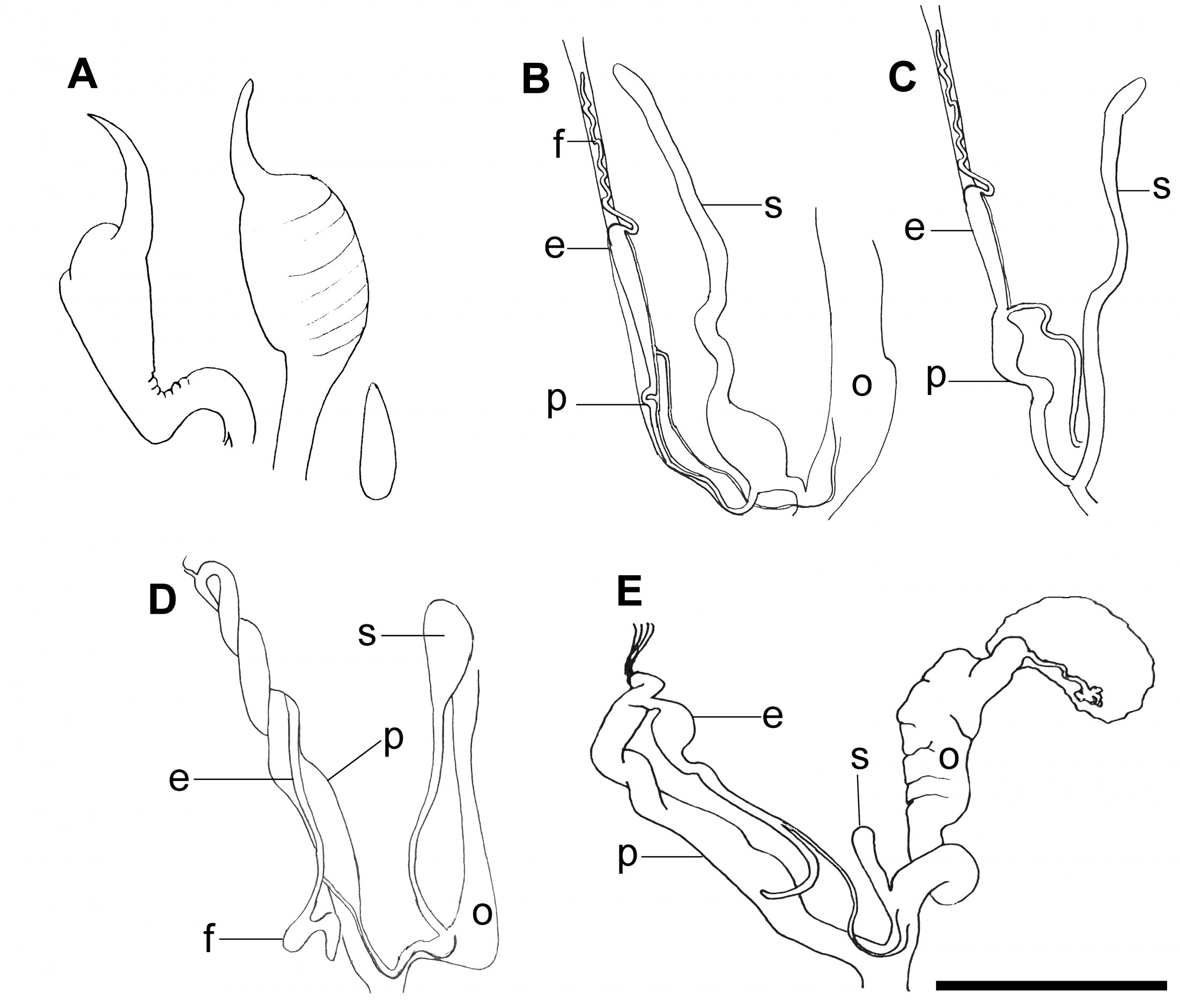
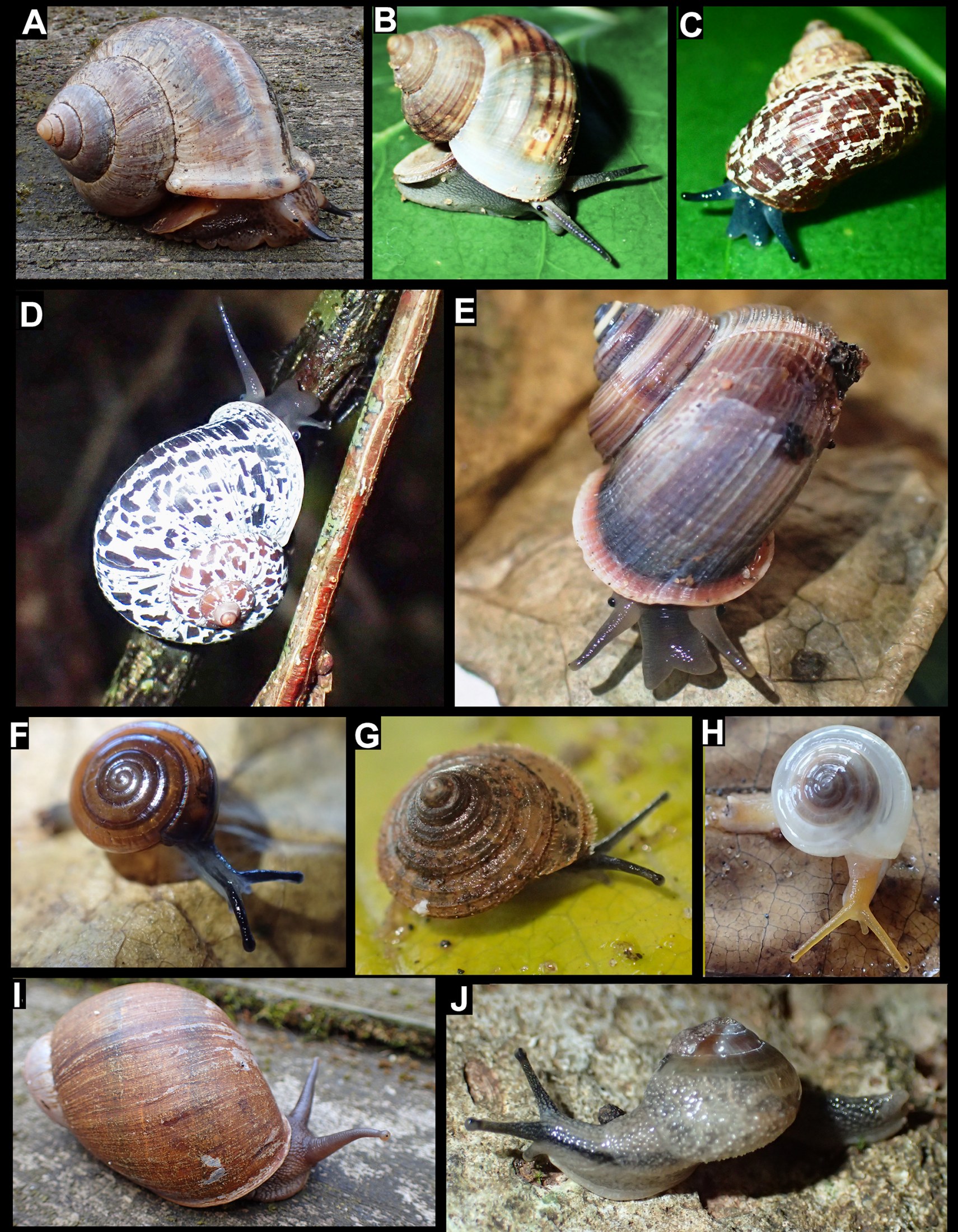
Family VALLONIIDAE Morse, 1864
Pupisoma dioscoricola (Adams, 1845) (Fig. 18I)
Pupisoma orcula (Benson, 1850) Fischer-Piette et al., 1974: 484
Distribution.—Pan-tropical species, in Madagascar known from sites on the west, northern and east coasts. Also occurs in Mauritius and Rodrigues (Griffiths and Florens, 2006). Synonymized by Fischer-Piette et al. (1975, 1994) and recently supported by Hausdorf (2007). In Narinda North found at Anjajavy and Ambalatsingy; Nosy Faho.
Material studied.—OLG: 33/03 x 4 (UF 583345); 38/03 x 1; 39/03 x 1; 40/03 x 2; 8/04 x 1; 18/04 x 1.
Family PUPILLIDAE Turton, 1831
Pupoides coenopictus (Hutton, 1834) (Fig. 18J)
Distribution.—Almost pan-global. Absent from Mascarenes. In Madagascar only known from the northwest (Fisher-Piette et al., 1994). Nosy Lagna; Nosy Faho.
Material studied.—OLG: 16/04 x 96 (NHMUK, UMZC); 18/04 x 85.
Family SUCCINEIDAE Beck, 1837
Quickia concisa (Morelet, 1848) (Fig. 18K)
Distribution.—Africa and Indian Ocean islands (Fischer-Piette et al., 1994). Nosy Lagna; Nosy Faho.
Material studied.—OLG: 16/04 x 12 (UF 583346); 18/04 x 8.
Order SYSTELLOMMATOPHORA Pilsbry, 1948
Family VERONICELLIDAE Gray, 1840
Imerinia sp.
Notes.—One species was observed in Anjajavy but not collected. This resembles Imerinia grandidieri (Crosse and Fischer, 1871) but would have needed dissection for accurate identification. Bruggen (1980, 1981) listed 19 species of veronicellid from Madagascar, with three from the north-western region.
Distribution.—Narinda North – Anjajavy.
Material studied.—OLG 37/03.
Superorder HYGROPHILA Férussac, 1822
Family PLANORBIDAE Rafinesque, 1815
Biomphalaria pfeifferi (Krauss, 1848)
Notes.—Freshwater snails only seen in the Anjajavy Hotel’s freshwater pond. This is a widespread species in Africa and is found throughout Madagascar (Starmuhlner, 1969; Fischer-Piette and Vukadinovic, 1973).
Material studied.—observed, but not collected.
Hovorbis crassilabrum (Morelet, 1860) (Fig. 18L)
Anisus (Anisus) crassilabrum Morelet, Fischer-Piette and Vukadinovic, 1973: 364
Afrogyrus crassilabrum (Morelet, 1860) Brown, 1994: 189
Africanogyrus crassilabrum (Morelet, 1860) Özdikmen and Darılmaz, 2007: 260
Distribution:.—Type locality north-west Madagascar. Widespread from various habitats including seasonally dry pans. In Narinda North found from Ambalatsingy to Marovatolena. Also found in Comoro Islands (Brown, 1994).
Material studied: OLG: 8/04 x 15 (NHMUK); 12/04 x 16.
Gyraulus cf. mauritianus (Morelet, 1876) (Fig. 18M)
Height: 1.0 mm; width: 5.0 mm. Weak keel almost at mid-whorl, lacks the keels usually present on young Hovorbis. Most resembles Gyraulus which is recorded from East Africa; Mauritius and Socotra but not previously from Madagascar.
Distribution.—Narinda North – Ambalatsingy. Previously only recorded from Seychelles and Mauritius (Brown 1994).
Material studied.—OLG: 10/04 x 7 (UF 583347).
Family BULINIDAE Fischer and Crosse, 1880
Bulinus forskalii (Ehrenberg, 1831) (Fig. 18N)
Bulinus (Pyrgophysa) mariei Crosse, Fischer-Piette and Vukavidovnik, 1973: 364
Bulinus forskalii (Ehrenberg, 1831) Brown, 1994: 249
Distribution.—Afro-tropical. Over much of Madagascar (Brown, 1994). In Narinda North only found at Marovatolena.
Material studied.—OLG: 12/04 x 1 (UF 583348).
Acknowledgments
Organization of field work in Anjajavy was helped by Cédric de Foucault and Cédric Martin; we are most grateful for their hard work and kindness, and to the guides from Anjajavy Le Lodge. We are grateful to the Ministère de l’Environnement, des Eaux et Forêts et du Tourisme, Madagascar for granting permission for research and for the support of the Parc Botanique et Zoologique de Tsimbazaza. We thank Tom Eichhorst for the identification of Smaragdia patburkeae. Dai Herbert and Roger W. Portell provided very helpful reviews of the manuscript.
Literature Cited
Adams, A. and L. A. Reeve. 1850. Mollusca. In: Adams, A. (ed.), The zoology of the voyage of H.M.S. Samarang, under the command of Captain Sir Edward Belcher, C.B., F.R.A.S., F.G.S., during the years 1843-1846. Pt. II. Reeve and Benham, London, 380 p.
Adams, C. B. 1845. Specierum novarum conchyliorum, in Jamaica repertorum, synopsis. Proceedings of the Boston Society of Natural History. 2:1–17.
Adams, H., and A. Adams. 1854-1858. The genera of Recent Mollusca; Arranged according to their organisation. J. Van Voorst, London, 661 p.
Anton, H. E. 1838. Verzeichniss der Conchylien welche sich in der Sammlung von Herrmann Eduard Anton befinden. Herausgegeben von dem Besitzer. Anton, Halle, 110 p.
Allnutt, T. F., S. Ferrier, G. Manion, G. V. N. Powell, T. H. Ricketts, B. L. Fisher, G. J. Harper, M. E. Irwin, C. Kremen, J-N. Labat, D. C. Lee, T. A. Pearce, and F. Rakotondrainibe. 2008. A method for quantifying biodiversity loss and its application to a 50-year record of deforestation across Madagascar. Conservation Letters 1:173–181.
Baker, H. B. 1928. Minute American Zonitidae. Proceedings of the Academy of Natural Sciences of Philadelphia 80:1–44.
Beck, C. H. H. 1837. Index Molluscorum praesentis aevi musei principis augustissimi Christiani Frederici. Fasciculus primus et secudnus. Hafniae, 124 p.
Benson, W. H. 1850. Characters of new species of Helix from India, Mauritius and the Cape of Good Hope; also of a new Mauritian Tornatellina, with remarks on the habits of a Cape Succinea. Annals and Magazine of Natural History (2) 6:251–256.
Benstead, J. P., M. M. Douglas, and C. M. Pringle. 2003. Relationships of stream invertebrate communities to deforestation in eastern Madagascar. Ecological Applications 13:1473–1490.
Bouchet, O., J-P., Rocroi, B. Hausdorf, A. Kaim, Y. Kano, A. Nützel, P. Parkhaev, M. Schrödl, and E.E. Strong. 2017. Revised classification, nomenclator and typification of gastropod and monoplacophoran families. Malacologia 61:1–526.
Bourguignat, J. R. 1877. Description de deux nouveaux genres algériens, suivie d’une classification des familles et des genres de Mollusques terrestres et fluviatiles du système européen. Bulletin de la Société des Sciences physiques et naturelles de Toulouse 3(1):49−101.
Bowdich, T.E. 1822. Elements of conchology, including the fossil genera and the animals. Part I. Univalves. Treuttel and Wurtz, London, 79 p.
Brown, D. 1994. Freshwater Snails of Africa and their Medical Importance. 2nd ed. Taylor and Francis, London, 608 p.
Bruggen, A. C. van 1980. Notes on the African element among the terrestrial molluscs of Madagascar. Haliotis 10(2):32.
Bruggen, A. C. van 1981. The African element among the terrestrial molluscs of the island of Madagascar. Proceedings of the Koninklijke Nederlandse Akademie van Wetenschappen 84(1):115–129.
Burmeister, H. 1837. Handbuch der Naturgeschichte. Zum Gebrauch bei Vorlesungen. Enslin, Berlin, 858 p.
Connolly, M. 1912. A revised reference list of South African non-marine Mollusca; with descriptions of new species in the South African Museum. Annals of the South African Museum 11(3):59–306.
Connolly, M. 1925. Notes on a collection of non-marine Mollusca from the islands of the Indian Ocean. Journal of Conchology 17(9):257–266.
Cox, L. R. 1960. Thoughts on the classification of the Gastropoda. Proceedings of the Malacological Society of London 33(6):239−261.
Craven, A. E. 1880. Description of three new species of land and freshwater shells from Nossi-Bé Isand (N.W. coast of Madagascar). Proceedings of the Zoological Society of London 1880:215–216.
Crosse, H. 1880. Diagnoses Molluscorum novorum, in insula “Nossibé” dicta et in provincia Paraensis collectorum. Journal de Conchyliologie 28(2):149–150.
Crosse, H. and P. Fischer. 1871. Description d’un genre nouveau et de deux espèces nouvelles de mollusques terrestres de Madagascar. Journal de Conchyliologie 19(4):331–333.
Crosse, H., and P. Fischer. 1872. Diagnoses molluscorum novorum, insulae Madagascar dictae incolarum. Journal de Conchyliologie 20:209–210.
Crosse, H. and P. Fischer. 1879. Description d’une nouvelle espèce de Pupa, provenant de Nossi-Bé. Journal de Conchyliologie 27(1):49.
Deshayes, G. P. 1830. Encyclopédie méthodique ou par ordre de matières. Histoire naturelle des Vers et Mollusques, Tome 2, Part 1. Agasse, Paris, 256 p.
Ehrenberg, C. G. 1831. Animalia evertebrata. Symbolae physicae seu icones et descriptions naturalium novorum aut minus cognitorum quae ex itineribus Lybiam Aegyptum Nubiam Dongalam Syriam Arabiam et Habessinian. Pars Zoologica. Abhandlungen der deutschen Akademie der Wissenschaften 4:(unpaginated)
Eichhorst, T. E. 2016. Neritidae of the world. Volume 2. Conchbooks, Harxheim, 672 p.
Emberton, K. C. 1999. Edentulina of Madagascar (Pulmonata: Streptaxidae). American Malacological Bulletin 15:97–108.
Emberton, K. C. 2002. Parvedentulina and edentate Gulella of Madagascar (Gastropoda: Stylommatophora: Streptaxidae). Archiv für Molluskenkunde 131(1):67–165.
Emberton, K. C. 2003. Madagascan Cyathopoma sensu lato (Gastropoda:Cyclophoridae). Archiv für Molluskenkunde 132(1/2):9–91.
Emberton, K. C. 2004. Madagascan Georissa, Cyclotus, Omphalotropis and so-called Chondrocyclus (Gastropoda: Caenogastropoda: Hydrocaenidae, Cyclophoridae, Assimineidae). Archiv für Molluskenkunde 133(1/2):69–107.
Emberton, K. C. 2007. Twenty-nine new land-snail species of the genus Kalidos from Northern Madagascar (Pulmonata: Helicarionidae). Archiv für Molluskenkunde. 136(2):245–289.
Emberton, K. C. and T. A. Pearce. 2000. Small, high-spired pulmonates from Mounts Mahermana, Ilapiry, and Vasiha, southeastern Madagascar, with description of a new genus, and with conservation statuses of 15 streptaxid species. The Veliger 43:126–153.
Emberton, K. C. and J. A. Rakotondrazafy. 2020. Rhytidoid land snails collected in 2007 at 21 sites in northern Madagascar, with descriptions of 13 new species and two new subspecies (Gastropoda, Rhytidoidea: Acavidae and Clavatoridae). Basteria 84(4–6):170–209.
Férussac, A. E. J. P. J. F. d’A. de. 1821–1822. Tableaux systématiques des animaux mollusques classés en familles naturelles, dans lesquels on a établi la concordance de tous les systèmes; suivis d’un prodrome général pour tous les mollusques terrestres ou fluviatiles, vivants ou fossils. A. Bertrand, Paris, 204 p.
Fischer, P., and H. Crosse. 1870. Études sur les mollusques terrestres et fluviatiles du Mexique et du Guatemala. Mission scientifique au Mexique et dans l’Amerique Centrale. Recherches zoologiques, Partie 7 Volume 1. Imprimerie Nationale, Paris, 702 p.
Fischer-Piette, E. 1949. Mollusques terrestres de Madagascar. Genre Tropidophora. Journal de Conchyliologie 89(3):111–146.
Fischer-Piette, E. in: Fischer-Piette, E., M. Cauquoin, and A.-M. Testud. 1973. Mollusques terrestrs récoltés par M. Soula dans la region d’Antalaha (Madagascar). Bulletin du Muséum National d’Histoire Naturelle, Zoologie 94:477–530.
Fischer-Piette, E., and J. Bedoucha, in: Fischer-Piette, E., J. Bedoucha, and F. Salvat. 1966. Mollusques terrestres de Madagascar, Ariophantidae. Mémoires du Muséum National d’Histoire Naturelle, Zoologie 40(1):1–50
Fischer-Piette, E. and J. Bedoucha. 1965. Mollusques terrestres operculés de Madagascar. Mémoires du Museum National d’Histoire Naturelle, Zoologie 33:50–91.
Fischer-Piette, E., F. Blanc, and F. Salvat. 1975. Complément aux mollusques pulmonés de Madagascar. Bulletin du Muséum National d’Histoire Naturelle, Zoologie 198:209–276.
Fischer-Piette, E., C. P. Blanc, F. Blanc, and F. Salvat. 1993. Gastéropodes terrestres prosobranches. Faune de Madagascar 80:1–281.
Fischer-Piette, E., C. P. Blanc, F. Blanc, and F. Salvat. 1994. Gastéropodes terrestres pulmonés. Faune de Madagascar 83:1–551.
Fischer-Piette, E., J. Blanc, and D. Vukadinovic. 1974. Additions aux Mollusques terrestres de Madagascar. Bulletin du Museum National d’Histoire Naturelle, Zoologie 146(218):465–524.
Fischer-Piette, E., and A.-M. Testud. 1964. Mollusques terrestres de Madagascar Achatinacea. Bulletin du Museum National d’Histoire Naturelle, Zoologie 36:377–383.
Fischer-Piette, E. and D. Vukadinovic. 1973. Sur les Mollusques Fluviatiles de Madagascar. Malacologia 12:339–378.
Fitzinger, L.J. 1833. Systematisches Verzeichniß der im Erzherzogthume Oesterreich vorkommenden Weichthiere, als Prodrom einer Fauna derselben. Beiträge zur Landeskunde Oesterreichs’s unter der Enns 3:88–122.
Fukuda, H. and W. F. Ponder. 2003. Australian freshwater assimineids, with a synopsis of the Recent genus-group taxa of the Assimineidae (Mollusca: Caenogastropoda: Rissooidea). Journal of Natural History 37(16):1977–2032.
Fulton, H. 1901. Descriptions of new species of Xesta, Amphidromus, and Cyclostoma from Madagascar and Perak. The Journal of Malacology 8(4):103–104.
Gerlach, J. 2006. Terrestrial and Freshwater Mollusca of the Seychelles Islands. Backhuys Publishers, Leiden, 141 p.
Gerlach, J. and O. Griffiths. 2002. The land snails of the Aldabra islands, western Indian Ocean. Journal of Conchology 37:667–679.
Germain, L. 1921. Paleontologie de Madagascar, IX. Mollusques terrestres et fluviatiles quaternaires de Madagascar. Annales de Paleontologie 10:21–36.
Golikov, A. N. and Y. I. Starobogatov. 1975. Systematics of prosobranch gastropods. Malacologia 15(1):185–232.
Gray, J. E. 1824. Zoological notices. The Philosophical Magazine and Journal 63(312):274–277.
Gray, J.E. 1840. Shells of molluscous animals. Pp. 105–152 in: Synopsis of the Contents of the British Museum. British Museum, G. Woodfall, London.
Gray, J. E. 1847. A list of the genera of recent Mollusca, their synonyms and types. Proceedings of the Zoological Society of London 15:129–219.
Griffiths, O. L. G. and V. Florens. 2006. A Field Guide to the Non-Marine Molluscs of the Mascarene Islands (Mauritius, Rodrigues and Réunion) and the Northern Dependencies of Mauritius. Bioculture Press, Mauritius, 185 p.
Griffiths, O. L. and Herbert, D. G. 2013. New species of land snails (Mollusca: Gastropoda) from two isolated karst formations in central western Madagascar: Tsingy Beanka and Antsingimavo, with additional notes on other regional endemics. African Invertebrates 54:1–48.
Groh, K. and G. T. Poppe. 2002. The family Acavidae, excluding genus Ampelita. A Conchological Iconography. ConchBooks, Hackenheim, 69 p.
Haller, B. 1892. Die Morphologie der Prosobranchier. Morphologisches Jahrbuch 18(3):451–543.
Harper, G., M. Steininger, C. Tucker, D. Juhn, and F. Hawkins. 2007. Fifty years of deforestation and forest fragmentation in Madagascar. Environmental Conservation 34(4):325–333.
Hausdorf, B. 2007. Revision of the American Pupisoma species (Gastropoda: Pupilloidea). Journal of Natural History 41:21–24.
Heynemann, F. D. 1882. Ueber einige Nacktschnecken von Ost-Afrika aus dem Berliner Zoologischen Museum. Nachrischtsblatt der detschen Malakozoologischen Gesellschaft 14(11/12):180–184.
Hutton, T. 1834. On the land shells of India. The Journal of the Asiatic Society of Bengal. 3(26):81–93.
Hyman, I. T. and W. F. Ponder. 2010. A morphological phylogenetic analysis and generic revision of Australian Helicarionidae (Gastropoda: Pulmonata: Stylommatophora), and an assessment of the relationships of the family. Zootaxa 2462:1–148.
Irwin, M. T., P. C. Wright, C. Birkinshaw, B. L. Fisher, C. J. Gardner, J. Glos, S. M. Goodman, P. Loiselle, P. Rabeson, J.-L. Raharison, M. J. Raherilalaogk, D. Rakotondravony, A. Raselimanana, J. Ratsimbazafy, J. S. Sparks, L. Wilmé, and J. U. Ganzhorn. 2010. Patterns of species change in anthropogenically disturbed forests of Madagascar. Biological Conservation 143(10):2351–2362.
Jonas, J. H. 1845. Neue Conchylien. Zeitschrift für Malakozoologie 2:168–173.
Krauss, F. 1848 Die Südafrikanischen Mollusken. Ein Beitrag zur Kenntniss der Mollusken des Kap- und Natallandes und zur Geographischen Verbreitung derselben mit Beschreibung und Abbildung der neuen Arten. Ebner and Seubert, Stuttgart, 140 p.
Küster, H. C. 1855. Die Gattungen Truncatella und Paludinella. Pp. 1–19 in W. Kobelt, ed., Systematisches Conchylien-Cabinet von Martini und Chemnitz. Verlag von Bauer and Raspe, Nürnberg.
Lamarck, J.-B. M. de. 1822. Histoire naturelle des animaux sans vertèbres. Tome sixième, 2me partie. Lamarck, Paris, 232 p.
Linnaeus, C. 1758. Systema naturae per regna tria naturae, secundum classes, ordines, genera, species, cum characteribus, differentiis, synonymis, locis. Tomus 1. Editio decima reformata. Laurentius Salvius, Holmiae [Stockholm], 824 p.
Linnaeus, C. 1767. Systema naturae per regna tria naturae: secundum classes, ordines, genera, species, cum caracteribus, differentiis, synonymis, locis. Tomus 1., Laurentius Salvius, Holmiae [Stockholm], 1327 p.
Mabille, J. 1886. Diagnoses testarum novarum. Bulletin de la Société Philomathique de Paris 10(3):123–135.
McConnell, W. J. and C. A. Kull. 2014. Deforestation in Madagascar: Debates over the island’s forest cover and challenges of measuring forest change. Pp. 67–104 in I. R. Scales, ed. Conservation and Environmental Management in Madagascar. Routledge, London.
Martens, E. von. 1898. Conchyliologischer Theil. Pp 3–35 in E. von Martens and F. Wiegmann. Land- und Süsswasser-Mollusken der Seychellen nach den Sammlungen von Dr. Aug. Brauer. Mitteilungen aus der Zoologischen Sammlung des Museums für Naturkunde in Berlin 1:1–94.
Middleton, J. and V. Middleton. 2002. Karst and caves of Madagascar. Cave and Karst Science 29:13–20.
Morelet, A. 1848. Testacea quaedam Africae occidentalis terrestria et fluviatilia. Revue Zoologique par la Société Cuvierienne 11:351–355.
Morelet, A. 1851. Testacea Africae insularis a Cl. Vesco collecta et ab A. Morelet descripta. Revue et magasin de zoologie pure et appliquée 3:218–221.
Morelet, A. 1860. Series conchyliologiques, comprenant l’enumération de mollusques, terrestres et fluviatiles recueillis pendant le cours de différents voyages, ainsi que la description de plusieurs espèces Nouvelles. Klincksieck, Paris. 377 p.
Morelet, A. 1876. Sur quelques coquilles inédites ou imparfaitement connues des îles orientales de l’Afrique. Journal de Conchyliologie. 24:85–91.
Morelet, A. 1877. Excursion conchyliologique dans l’île d’Anjouan (Johanna). Journal de Conchyliologie 25:325–347.
Morelet, A. 1881. Malacologie des Comores. Récolte de M. Marie à l’île Mayotte. Journal de Conchyliologie. 29(3):212–241.
Morelet A. 1882. Malacologie des Comores. Récolte de M. Marie, à l’île Mayotte. Journal de Conchyliologie 30:185–200.
Morse, E. S. 1864. Observations on the terrestrial Pulmonifera of Maine, including a catalogue of all the species of terrestrial and fluviatile Mollusca known to inhabit the state. Journal of the Portland Society of Natural History. 1(1):1–63.
Mousson, A. 1849. Die Land- und Süsswasser- Mollusken von Java. Friedrich Schulthess, Zurich, 126 p.
Müller, O. F. 1774. Vermium terrestrium et fluviatilium, seu animalium infusorium, helminthicorum, et testaceorum, non marinorum, succincta historia. Volumen alterum. Havniae et Lipsiae, 214 p.
Nekola, J. C. and B. F. Coles. 2016. Supraspecific taxonomy in the Vertiginidae (Gastropoda: Stylommatophora). Journal of Molluscan Studies 82:208–212.
Newton, R. B. 1891. On the necessity for the abandonment of the generic name Cyclostoma with suggestions relating others involved in this genus. Annals and Magazine of Natural History 7:345–348.
Odhner, N. H. J. 1919. Contribution à la faune malacologique de Madagascar. Arkiv för Zoologi. 12(6):1–52.
Özdikmen H. and M. C. Darılmaz. 2007. Africanogyrus nom. n., a replacement name for the preoccupied snail genus Afrogyrus Brown and Mandahl-Barth, 1973 (Gastropoda: Planorbidae). African Invertebrates 48(2):259–260.
Pease, W. H. 1860. Descriptions of new species of Mollusca from the Sandwich Islands. Proceedings of the Zoological Society of London 28:141–148.
Pease, W. H. 1865. Descriptions of new genera and species of marine shells from the islands of the Central Pacific. Proceedings of the Zoological Society of London 1865:512–517.
Pfeiffer. L. 1852. Descriptions of eighteen new species of land shells, from the collection of H. Cuming, Esq. Proceedings of the Zoological Society 20:156–160.
Pfeiffer, L. 1853. Monographia heliceorum viventium. Sistens descriptiones systematicas et criticas omnium huius familiae generum et specierum hodie cognitarum. Volumen tertium. Vol. 3. Lipsiae: Brockhaus. 711 p.
Pfeiffer, L., 1854. Synopsis Auriculaceorum. Malakozoologische Blätter 1:145–156.
Pfeiffer, L. 1854. Descriptions of sixty-six new land shells, from the collection of H. Cuming, Esq. Proceedings of the Zoological Society of London. 20:56–70.
Philippi, R. A. 1849. Centuria tertia testaceorum novorum. Zeitschrift für Malakozoologie. 5(10):151–160.
Pilsbry, H. A. 1918. Manual of Conchology, structural and systematic, with illustrations of the species. Second series: Pulmonata. Vol. XXIV Pupillidae (Gastrocoptinae). Conchological Section, Academy of Natural Sciences, Philadelphia. 380 p.
Pilsbry, H. A. 1920. Manual of conchology, structural and systematic, with illustrations of the species. Second series: Pulmonata. Vol. 25: Pupillidae (Gastrocoptinae, Vertigininae). Conchological Section, Academy of Natural Sciences, Philadelphia. 404 p.
Pilsbry, H. A. 1948. Land Mollusca of North America (North of Mexico). Academy of Natural Sciences of Philadelphia Monographs 3(2): 521–1113.
Poirier, M. J. 1887. Observations anatomiques sur Ie genre Urocyclus. Bulletin de la Société Malacologique de France 4: 195-232.
Rafinesque, C. S. 1815. Analyse de la nature, ou Tableau de l’univers et des corps organisés. Palerme. 224 p.
Randrianambinina, B., S. Rasoloharijaona, R. Rakotondravony, E. Zimmermann, and U. Radespiel. 2010. Abundance and conservation status of two newly described lemur species in northwestern Madagascar (Microcebus danfossi, Lepilemur grewcockorum). Madagascar Conservation and Development 5(2):95–102.
Reeve, L. A. 1849. Conchologia Iconica: or, illustrations of the shells of molluscous animals, Vol. 5.Reeve, Benham, and Reeve, London. (unpaginated).
Schepman, M. M. 1908. The Prosobranchia of the Siboga Expedition. Part I. Rhipidoglossa and Docoglossa. Siboga Expeditie 49a:1–107.
Simroth, H. 1889. Beitriige zur Kenntnis der Nacktschnecken. Naova acta der Kaiserlichen Leopoldinisch-Carolinischen Deutschen Akademie der Naturforscher 54 (1): 1–91.
Starmuhlner, F. 1969. Die gastropoden der Madagassischen binnengewasser. Malacologia 8(1–2):1–434.
Stoliczka F. 1868. Cretaceous fauna of southern India. Palaeontologia Indica, being figures and descriptions of the organic remains procured during the progress of the Geological Survey of India. Volume 2, The Gastropoda. Geological Survey Office, Calcutta. 636 p.
Thiele, J. 1931. Handbuch der systematischen Weichtierkunde. Erster Band. Fischer, Jena. 778 p.
Tillier, S. 1979. Malagarion paenelimax gen. nov., spec. nov., a new slug-like helicarionid from Madagascar (Pulmonata: Helicarionidae). The Veliger 21:361–368.
Troschel, F. H. 1856-1863. Das Gebiss der malacologique de Madagascar. Arkiv för Zoologi. 12(6):1–52.
Özdikmen H. and M. C. Darılmaz. 2007. Africanogyrus nom. n., a replacement name for the preoccupied snail genus Afrogyrus Brown and Mandahl-Barth, 1973 (Gastropoda: Planorbidae). African Invertebrates 48(2):259–260.
Pease, W. H. 1860. Descriptions of new species of Mollusca from the Sandwich Islands. Proceedings of the Zoological Society of London 28:141–148.
Pease, W. H. 1865. Descriptions of new genera and species of marine shells from the islands of the Central Pacific. Proceedings of the Zoological Society of London 1865:512–517.
Pfeiffer. L. 1852. Descriptions of eighteen new species of land shells, from the collection of H. Cuming, Esq. Proceedings of the Zoological Society 20:156–160.
Pfeiffer, L. 1853. Monographia heliceorum viventium. Sistens descriptiones systematicas et criticas omnium huius familiae generum et specierum hodie cognitarum. Volumen tertium. Vol. 3. Lipsiae: Brockhaus. 711 p.
Pfeiffer, L., 1854. Synopsis Auriculaceorum. Malakozoologische Blätter 1:145–156.
Pfeiffer, L. 1854. Descriptions of sixty-six new land shells, from the collection of H. Cuming, Esq. Proceedings of the Zoological Society of London. 20:56–70.
Philippi, R. A. 1849. Centuria tertia testaceorum novorum. Zeitschrift für Malakozoologie. 5(10):151–160.
Pilsbry, H. A. 1918. Manual of Conchology, structural and systematic, with illustrations of the species. Second series: Pulmonata. Vol. XXIV Pupillidae (Gastrocoptinae). Conchological Section, Academy of Natural Sciences, Philadelphia. 380 p.
Pilsbry, H. A. 1920. Manual of conchology, structural and systematic, with illustrations of the species. Second series: Pulmonata. Vol. 25: Pupillidae (Gastrocoptinae, Vertigininae). Conchological Section, Academy of Natural Sciences, Philadelphia. 404 p.
Pilsbry, H. A. 1948. Land Mollusca of North America (North of Mexico). Academy of Natural Sciences of Philadelphia Monographs 3(2): 521–1113.
Poirier, M. J. 1887. Observations anatomiques sur Ie genre Urocyclus. Bulletin de la Société Malacologique de France 4: 195-232.
Rafinesque, C. S. 1815. Analyse de la nature, ou Tableau de l’univers et des corps organisés. Palerme. 224 p.
Randrianambinina, B., S. Rasoloharijaona, R. Rakotondravony, E. Zimmermann, and U. Radespiel. 2010. Abundance and conservation status of two newly described lemur species in northwestern Madagascar (Microcebus danfossi, Lepilemur grewcockorum). Madagascar Conservation and Development 5(2):95–102.
Reeve, L. A. 1849. Conchologia Iconica: or, illustrations of the shells of molluscous animals, Vol. 5.Reeve, Benham, and Reeve, London. (unpaginated).
Schepman, M. M. 1908. The Prosobranchia of the Siboga Expedition. Part I. Rhipidoglossa and Docoglossa. Siboga Expeditie 49a:1–107.
Simroth, H. 1889. Beitriige zur Kenntnis der Nacktschnecken. Naova acta der Kaiserlichen Leopoldinisch-Carolinischen Deutschen Akademie der Naturforscher 54 (1): 1–91.
Starmuhlner, F. 1969. Die gastropoden der Madagassischen binnengewasser. Malacologia 8(1–2):1–434.
Stoliczka F. 1868. Cretaceous fauna of southern India. Palaeontologia Indica, being figures and descriptions of the organic remains procured during the progress of the Geological Survey of India. Volume 2, The Gastropoda. Geological Survey Office, Calcutta. 636 p.
Thiele, J. 1931. Handbuch der systematischen Weichtierkunde. Erster Band. Fischer, Jena. 778 p.
Tillier, S. 1979. Malagarion paenelimax gen. nov., spec. nov., a new slug-like helicarionid from Madagascar (Pulmonata: Helicarionidae). The Veliger 21:361–368.
Troschel, F. H. 1856-1863. Das Gebiss der Schnecken zur Begründung einer natürlichen Classification, erster band. Nicolaische Verlagsbuchhandlung, Berlin, 252 p.
Turton, W. 1831. A manual of the land and fresh-water shells of the British Islands, arranged according to the more modern system of classification; and described from perfect specimens in the author’s cabinet: with coloured plates of every species. Longman, Rees, Orme, Brown and Green, London. 152 p.
Van Goethem, J. L. 1977. Révision systématique des Urocyclinae (Mollusca, Pulmonata, Urocylidae). Annales du Musée Royal de l’Afrique Centrale, Sciences Zoologiques 218:1-355.
Vieilledent, G., C. Grinandc, F. A. Rakotomalalac, R. Ranaivosoad, J.-R. Rakotoarijaonad, T. F. Allnutte, and F. Acharda. 2018. Combining global tree cover loss data with historical national forest cover maps to look at six decades of deforestation and forest fragmentation in Madagascar. Biological Conservation 222:189–197.
Villa, A., and J. B. Villa. 1841. Dispositio systematica conchyliarum terrestrium et fluviatilium quae adservantur in collectione fratrum Ant. et Jo. Bapt. Villa. Conspectu abnormitatum novarumque specierum descriptionibus adjectis. Mediolani: Borroni and Scotti, 62 p.
Wenz, W. 1923–1930. Gastropoda extramarina tertiaria. Fossilum Catalogus I: Animalis. W. Junk, Berlin, 3387 p.al., 1974: 484.
APPENDIX 1 – Anjajavy/Narinda North collecting stations
Data A1. Field numbers of sampling stations, listed in order, starting with the second component of the number, which reflects the year of collection. Collectors: KE – Ken Emberton, JG – Justin Gerlach; OLG – Owen Griffiths.
OLG – September 2003
33/03 In limestone scree in dry deciduous forest on east side of low limestone hill, just southwest of Amboaboaka village, S. side of Ankorotsakoa River, 15km W. of Antonibe, Narinda North, N.W. Madagascar. Alt approx. 50m. S15˚05.929’; E47˚14.434’. Collected O. Griffiths 25.ix.2003
34/03 In dry scrub growing on limestone, 5m inland from beach, Pointe Anjajavy near Hotel Anjajavy, approx. 22km N.W. of Antonibe, Narinda North, N.W. Madagascar. S14˚59.45’; E47˚13.75’. Collected O. Griffiths 26.ix.2003
35/03 Under logs and leaflitter in very sheltered salt marsh with mangroves, approx. 1km S.E. of Anjajavy Hotel, Pointe Anjajavy, approx. 22km N.W. of Antonibe, Narinda North, N.W. Madagascar. S14˚59.87’; E47˚13.67’. Collected O. Griffiths 26.ix.2003
36/03 In tall dry forest growing in narrow valley between low limestone bluffs at Grotte des Sakalava, approx. 1km E. of Anjajavy Hotel, Pointe Anjajavy, approx. 22km N.W. of Antonibe, Narinda North, N.W. Madagascar. S15˚00.466’; E47˚14.338’. Collected O. Griffiths 26.ix.2003
37/03 At cave entrance and inside cave on low limestone hill with remnant patch of dry forest, Lavaka Ampesekina Cave, approx. 1km S. of Amboaboaka Village, approx. 15km W. of Antonibe, Narinda North, N.W. Madagascar. S15˚06.481’; E47˚14.663’. Collected O. Griffiths 27.ix.2003
38/03 In and around entrance to Lavaka Ambohimenamaso with remnant patch of dry forest on south and west side of low limestone hill, approx. 2km N. of Amboaboaka Village, approx. 15km W. of Antonibe, Narinda North, N.W. Madagascar. S15˚04.843’; E47˚16.391’. Collected O. Griffiths 28.ix.2003
39/03 In degraded dry forest growing on tall limestone bluff by road to Anjajavy, approx. 4km N.W. of Amboaboaka Village approx. 19km W. of Antonibe, Narinda North, N.W. Madagascar. S15˚03.855’; E47˚13.856’. Collected O. Griffiths 29.ix.2003
40/03 In tall dry forest growing on very rugged limestone, approx. 500m inland at Anjajavy Lemur Skull cave, approx. 500m E of Anjajavy Hotel, Pointe Anjajavy, approx. 22km N.W. of Antonibe, Narinda North, N.W. Madagascar. Alt approx. 50m. S14˚49.79’; E47˚13.97’. Collected O. Griffiths 29.ix.2003
5/04 In leaf litter behind beach, in tall dry deciduous/evergreen forest with palms growing on Tsingy, below scarp on E side of Nosy Lava, just W of Analalava NW Madagascar. S14˚33.119’; E47˚59.37.617’. Collected O. Griffiths 29.xi.2004
5/04b In dry deciduous forest growing next to clear freshwater steam flowing on limestone, 1km N of Ambalatsingy, approx 25km N of Antonibe, Narinda North, NW of Port Berge (Boriziny), NW Madagascar. S14˚54.52’; E47˚23.89’. Collected O. Griffiths 23.xi.2004
6/04 In cave, and in slots in tall Tsingy outcrop amongst tall dry deciduous forest approx. 0.5km N of Ambalatsingy, approx. 25km N of Antonibe, Narinda North, NW of Port Berge (Boriziny) NW Madagascar. S14˚54.94’ E47˚23.42’. Collected O. Griffiths 24.xi.2004
8/04 In cave, and in slots in tall Tsingy outcrop, and in small muddy seasonally filled Lake, amongst tall dry deciduous forest, approx. 6km N of Ambalatsingy, at Narinda North, NW of Port Berge (Boriziny), NW Madagascar. S14˚52.635’; E47˚24.7’. Collected O. Griffiths 25.xi.2004
9/04 In leaf litter above beach on west facing slope in dry deciduous forest growing on Tsingy outcrop, NE side of Moramba bay, approx. 7km NW of Ambalatsingy above small sea cave, approx. 32km N or Antonibe, Narinda North, NW of Port Berge (Boriziny), NW Madagascar. S14˚51.807’; E47˚21.94’. Collected O. Griffiths 26.xi.2004
10/04 In leaf litter behind beach on sandy soil with baobabs in dry deciduous forest, next to limestone outcrop, western side of Moramba Bay, approx. 9km NW of Ambalatsingy, approx. 33km N of Antonibe, Narinda North, NW Madagascar. S14˚52.502’; E47˚20.387’ Collected: O. Griffiths 26.xi.2004
11/04 In cave and slots in tall Tsingy outcrop, among tall dry deciduous forest, approx. 0.5km N of Ambalatatsingy, at the burial cave site, approx. 25km N of Antonibe, Narinda North, NW of Port Berge (Boriziny), NW Madagascar. S14˚54.864; E47˚23.35’. Collected O. Griffiths 27.xi.2004
12/04 In slow flowing zebu contaminated stream flowing on red soil in cleared area, approx. 10km W of Marovatolena, approx. 50km SW of Antsohihy NW Madagascar. S15˚13.2’; E47˚37.18’. Collected O. Griffiths 27.xi.2004
13/04 In low scrubby dry deciduous forest growing on limestone, ca 3 km E of Ambalatsingy, ca 22km N of Antonibe, Narinda North, NW of Port Berge, NW Madagascar. S14.95° E47.40°. Collected R. Randalana 27.xi.2004
15/04 In leaf litter behind beach in tall deciduous forest with palms, growing on limestone below scarp on E side of Nosy Lava, just W of Analalava, NW Madagascar. S14.5720614˚; E47.6249090˚. Collected O. Griffiths 26.xi.2004
16/04 In leaf litter behind beach, on low sandy atoll covered in grass and coconut palms and some native vegetation, Nosy Lagna, just W of Analalava NW Madagascar. S14˚36.00’; E47˚40.72’. O. Griffiths 29.xi.2004
17/04 In leaf litter behind beach in scree slope and on top of island in dry deciduous forest growing on Tsingy, Nosy Soy (island) just west of Analalava NW Madagascar. S14˚38.09’; E47˚35.57’. Coll. O. Griffiths 30.xi.2004
18/04 In leaf litter behind beach, on low sand atoll covered in scrubby native vegetation with some tall trees, Nosy Faho, just W of Analalava NW Madagascar. S14˚38.53’; E47˚40.63’. Collected: O. Griffiths 30.xi.2004
MBI-903 In E facing dry deciduous forest, along base of scarp below waterfall at Antanamarina, along Antsahalalina River, approx. 6km S of Anjohibé Cave, Majunga District NW Madagascar. S15˚34.6’; E46˚52.1’. Collected: O. Griffiths and K. Emberton. September 1997
MBI-904 In dry deciduous forest growing on tsingy, surrounded by palm savannah, approx. 500m SE of the main entrance of Anjohibe Cave, Majunga District, NW Madagascar. S15˚32.9’; E46˚53.10’. Collected O. Griffiths and K. Emberton. September 1997
MBI-906 In large patch of Euphorb forest with isolated pandanus on Limestone pavement, along creek, on road to Mitsinjo, Majunga District, NW Madagascar. S15˚27.42’; E46˚54.99’. Collected O. Griffiths and K. Emberton. September 1997
MBI-907 Dry deciduous forest with palms at base of limestone pinnacle, NW of Mitsinjo village, N of Anjohibe cave, Majunga region, Madagascar. Collected O. Griffiths, September 1997
A637/78 In tiny patch of lowland forest by main highway, 30km E. of Majunga on road to Tananarive. Collected O. Griffiths, December 1978
KE – Emberton
MBI-2581 – Anjajavy, tiny stand of trees near well next to airfield, -15.0251, 47.2348, 7 meters, K. Emberton, 07.x.2007
MBI-2582 – Anjajavy, W side, isolated limestone hill by mud flat, -15.0599, 47.2255, 33 meters, K. Emberton, 07.x.2007
MBI-2583 – Anjajavy, S side, isolated limestone hill by mudflat, -15.0606, 47.2259, 31 meters, K. Emberton, 07.x.2007
MBI-2584 – Anjajavy, low sand hill above mudflat, -15.0643, 47.2256, 12 meters, K. Emberton, 08.x.2007
MBI-2585 – Anjajavy, low sand hill above mudflat, -15.0665, 47.2270, 15 meters, K. Emberton, 08.x.2007
MBI-2586 – Anjajavy, isolated steep limestone hill near Antsangabe, -15.0622, 47.2410, 44 meters, K. Emberton, 08.x.2007
MBI-2587 – Anjajavy, isolated steep limestone hill near Antsangabe, -15.0586, 47.2445, 29 meters, K. Emberton, 08.x.2007
MBI-2588 – Anjajavy, isolated steep limestone hill near Antsangabe, -15.0603, 47.2431, 40 meters, K. Emberton, 08.x.2007
MBI-2589 – Anjajavy, isolated steep limestone hill near Antsangabe, -15.0635, 47.2436, 54 meters, K. Emberton, 08.x.2007
MBI-2590 – Anjajavy, isolated steep limestone hill near Antsangabe, -15.0601, 47.2398, 50 meters, K. Emberton, 08.x.2007
MBI-2591 – Anjajavy, isolated steep limestone hill near Antsangabe, -15.0627, 47.2275, 56 meters, K. Emberton, 08.x.2007
MBI-2592 – Anjajavy, isolated steep limestone hill near Antsangabe, -15.0643, 47.2373, 30 meters, K. Emberton, 08.x.2007
MBI-2593 – Anjajavy, isolated tsingy base of cliff near small lake, -15.0167, 47.2467, 24 meters, K. Emberton, 11.x.2007
MBI-2594 – Anjajavy, south of isolated tsingy near small lake, base of cliff, -15.0159, 47.2464, 1 meter, K. Emberton, 11.x.2007
MBI-2595 – Anjajavy, side of long tsingy hill near dry mudflat, -15.0260, 47.2712, 22 meters, K. Emberton, 11.x.2007
MBI-2596 – Anjajavy, side of long tsingy near dry mudflat, -15.0253, 47.2692, 17 meters, K. Emberton, 11.x.2007
MBI-2597 – Anjajavy, tsingy just east of tiny stand of trees near well next to airfield, -15.0250, 47.2381, 26 meters, K. Emberton, 12.x.2007
Griffiths-A2557 – Anjajavy, Lemur Skull Cave, -14.9908, 47.2292, 12 meters, O. Griffiths, 29.ix.2003
JG
01/19 – In leaf-litter in dry woodland on limestone, 20m inland from coastal cliffs, Anjajavy. S14˚59.70’; E47˚13.18’. Collected J. Gerlach 9.iv.2019
02/19 – In dry woodland on limestone, 10m inland from coastal cliffs, Sentier Crique en Crique, Anjajavy. S14˚59.823’; E47˚12.995’. Collected J. Gerlach 9.iv.2019
03/19 – In dry scrub growing on limestone, 5m inland from beach, Pointe Anjajavy near Hotel Anjajavy, approx. 22km N.W. of Antonibe, Narinda North, N.W. Madagascar. S14˚59.45’; E47˚13.75’. Collected O. Griffiths 26.ix.2003, J. Gerlach 9.iv.2019
04/19 – In open dry scrub on limestone, 200m inland, Chemin des puits salés, Anjajavy. S14˚59’22.5””; E47˚13’49.5”. Collected J. Gerlach 10.iv.2019
05/19 – In tall dry forest on limestone, approx. 500m inland at Anjajavy Lemur Skull cave, approx. 500m E of Anjajavy Hotel. S14˚49.79’; E47˚13.97’. Collected J. Gerlach 10.iv.2019
06/19 – In dense woodland on limestone with tsingy outcrops, 150m inland, Chemin des puits salés, Anjajavy. S14˚59.37’; E47˚13.812’– S14˚59.282’; E47˚13.999’. Collected J. Gerlach 10.iv.2019
07/19 – In dense woodland on limestone with tsingy outcrops, 100m inland, Sentier du géant, Anjajavy. S14˚59.545’; E47˚14.081’. Collected J. Gerlach 10.iv.2019
08/19 – In open scrub on limestone with extensive tsingy, Enclos Tsingy, Anjajavy. S14˚59.95’; E47˚13.687’. Collected J. Gerlach 12.iv.2019
09/19 – In dry scrubby woodland on limestone, Anjajavy. S15˚0.529’; E47˚13.911’. Collected J. Gerlach 12.iv.2019
10/19 – In the entrance to Grotte des Sakalava, approx. 1km E. of Anjajavy Hotel, S15˚00.466’; E47˚14.338’. Collected J. Gerlach 13.iv.2019
11/19 – In dry woodland on limestone, Anjajavy. S15˚0.947’; E47˚14.56’. Collected J. Gerlach 13.iv.2019
12/19 – In the entrance to Lavaka Ambohimenamaso, approx. 2km N. of Amboaboaka Village. S15˚04.843’; E47˚16.391’. Collected O. Griffiths 28.ix.2003, J. Gerlach 15.iv.2019
13/19 – In sparse shrubs on open sand. Anjajavy airstrip. S15˚1’19.6””; E47˚13’52.7”. Collected J. Gerlach 16.iv.2019